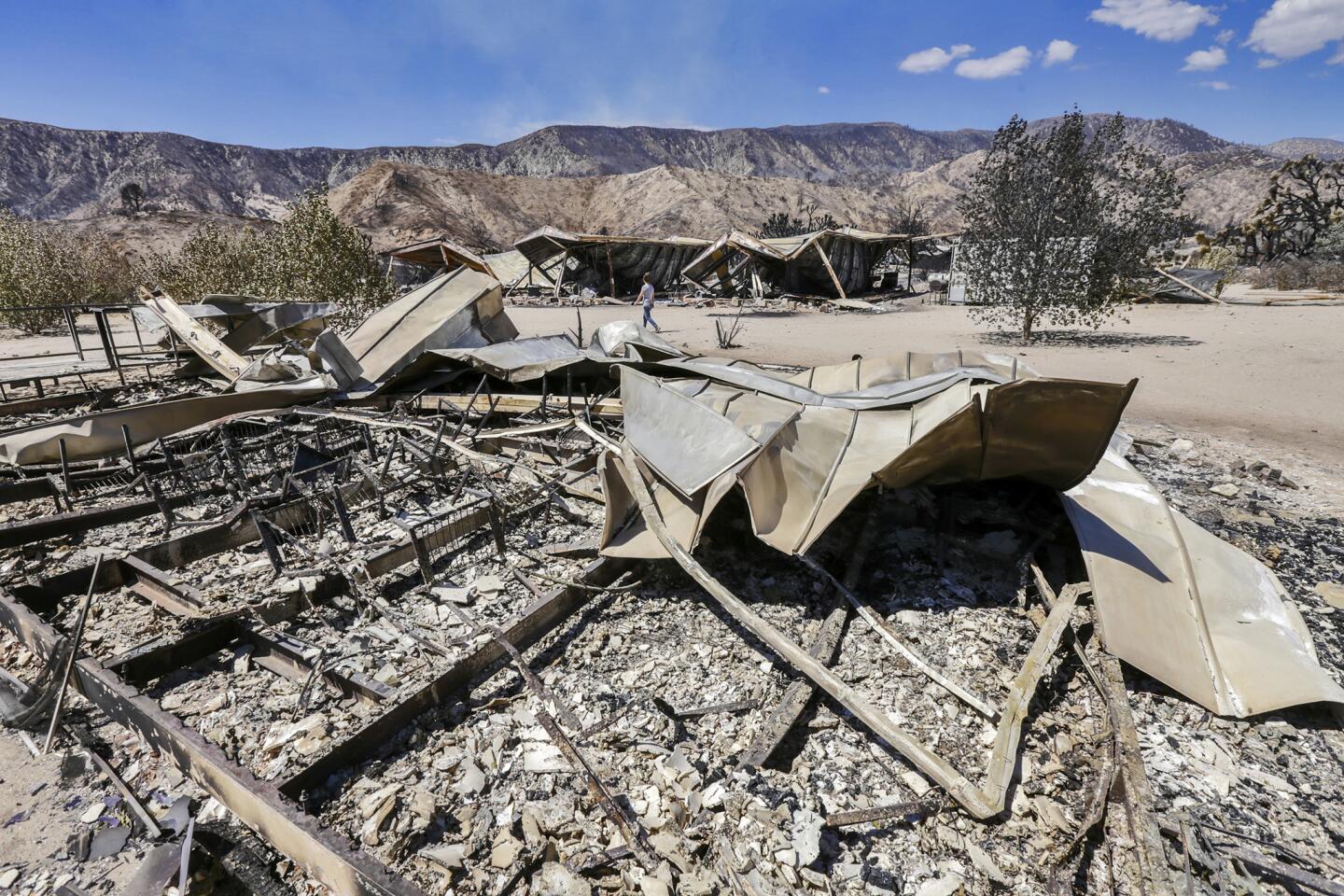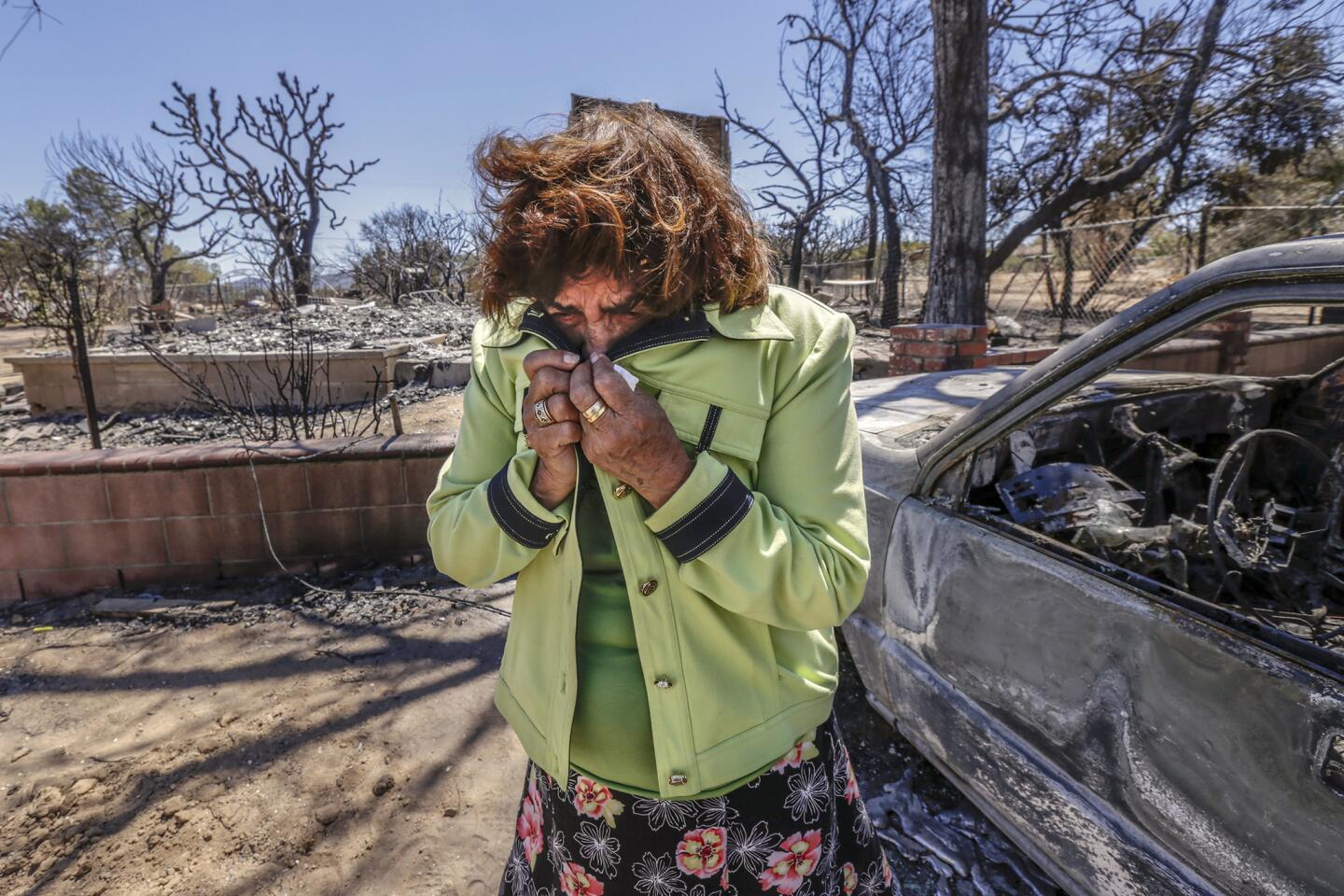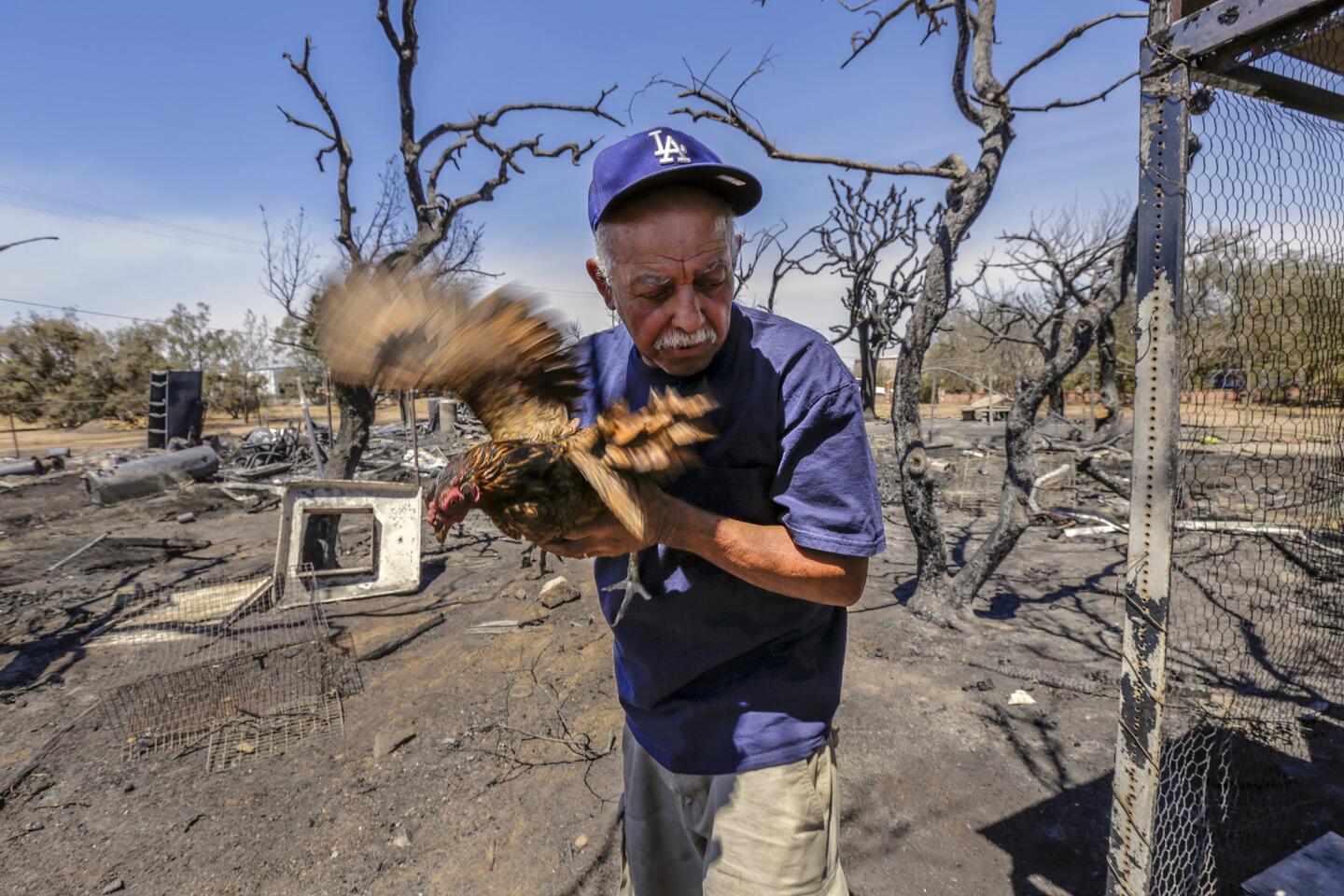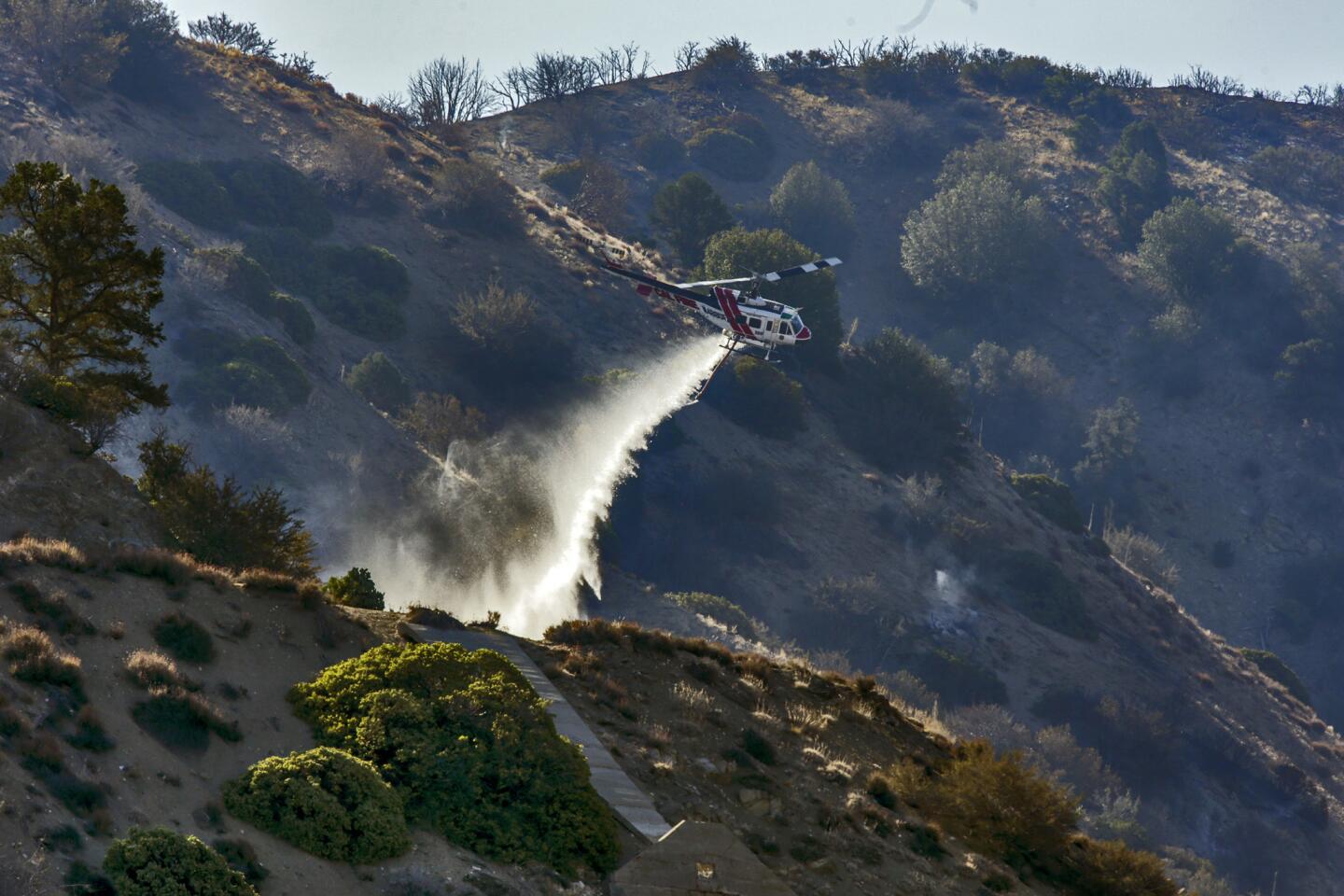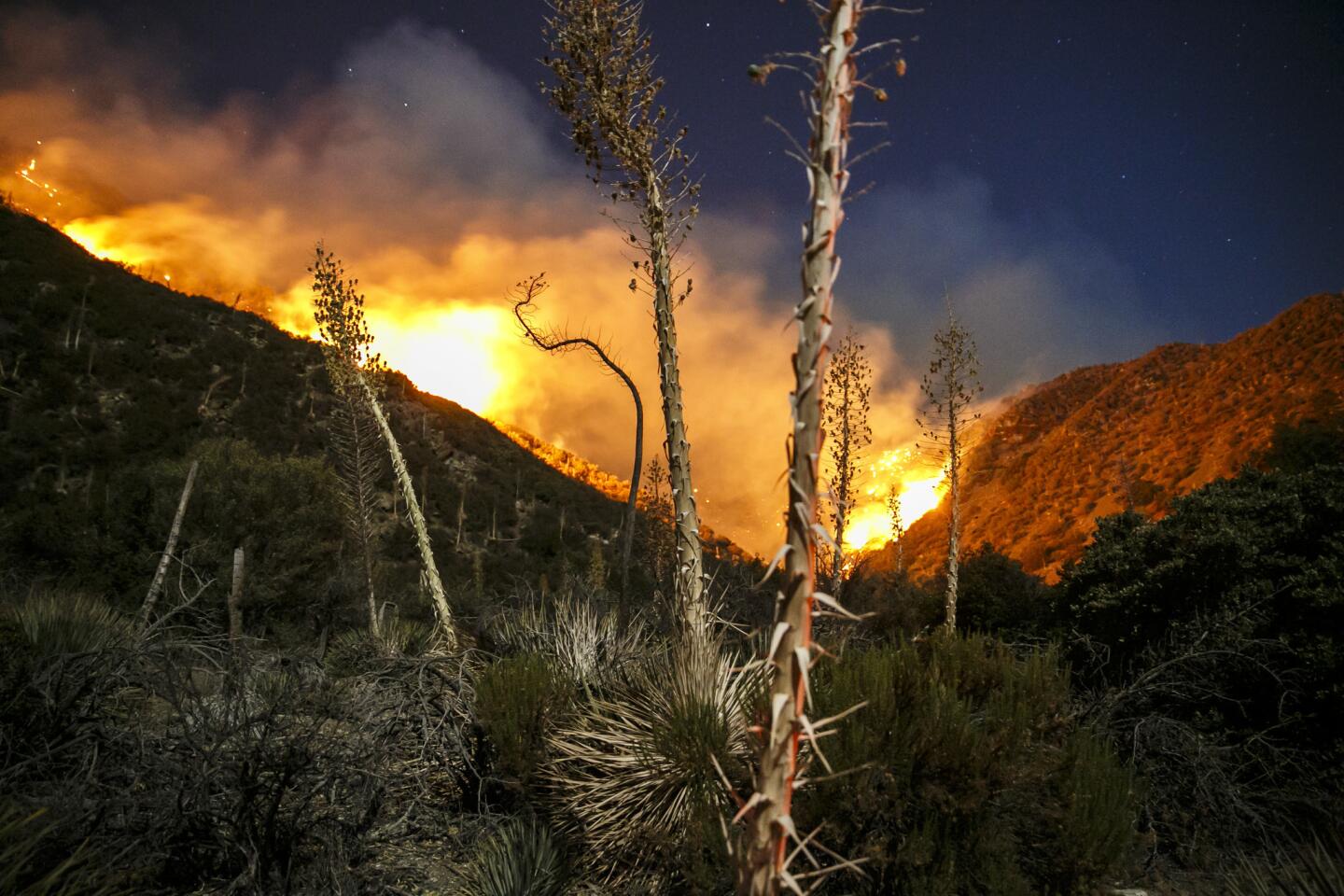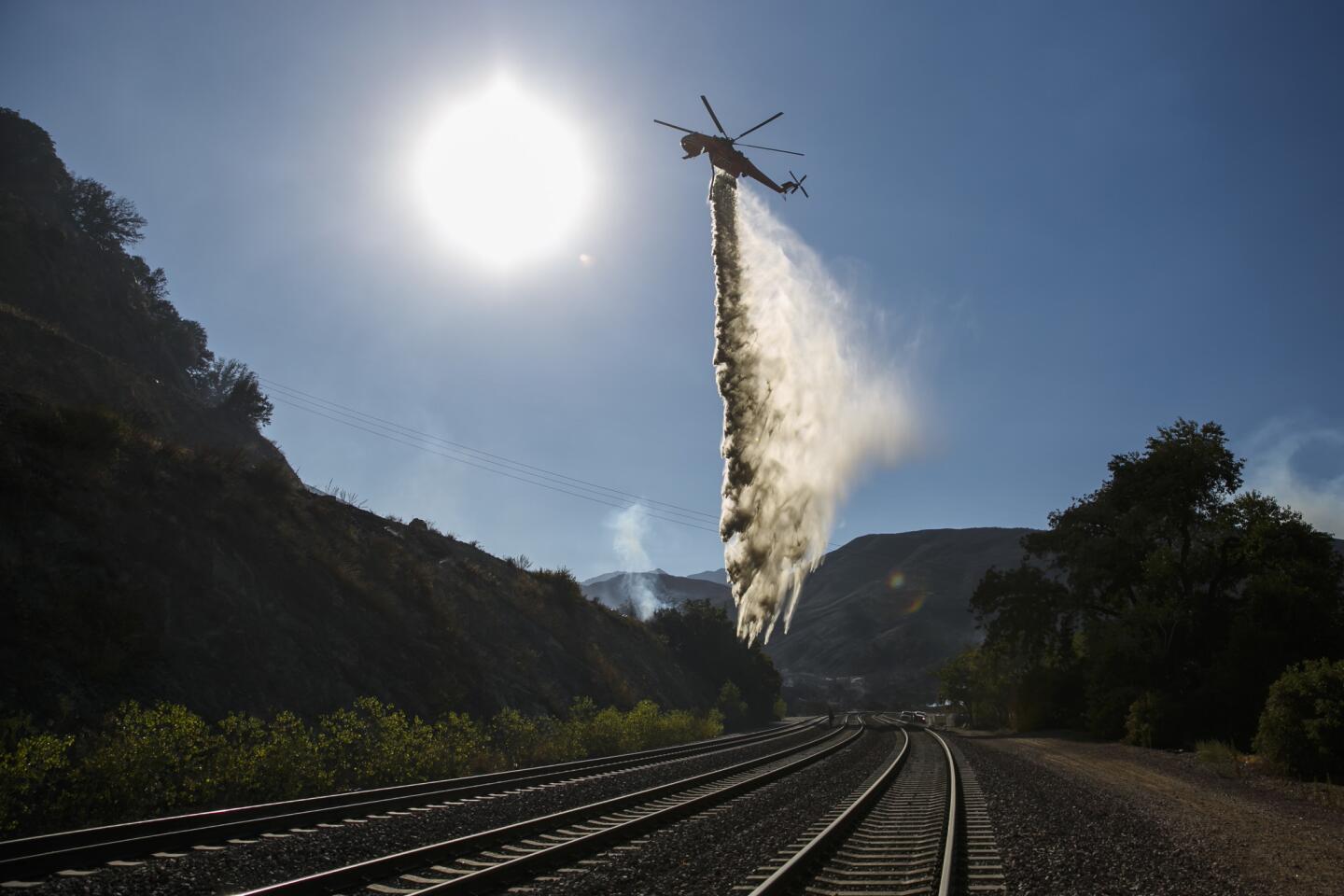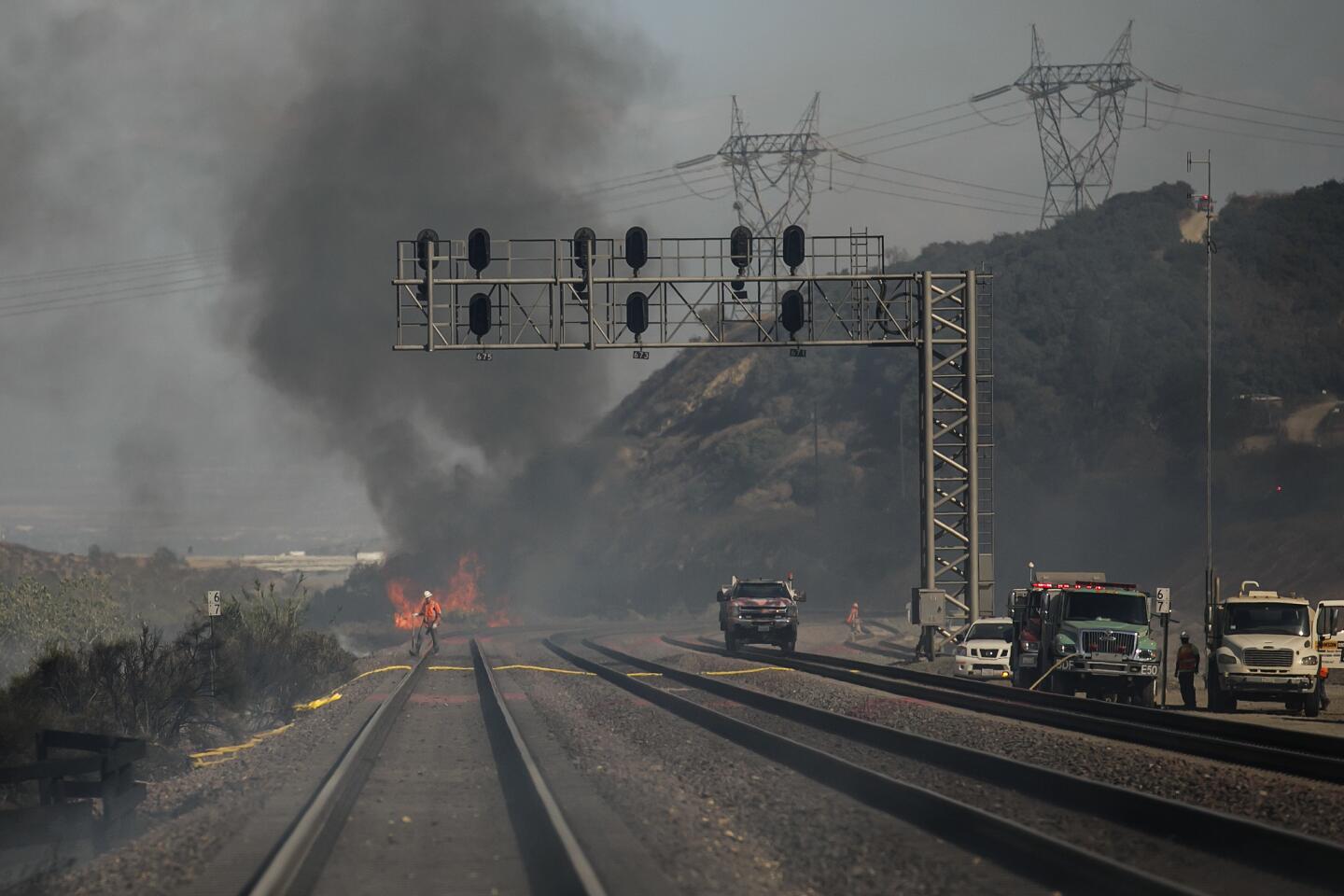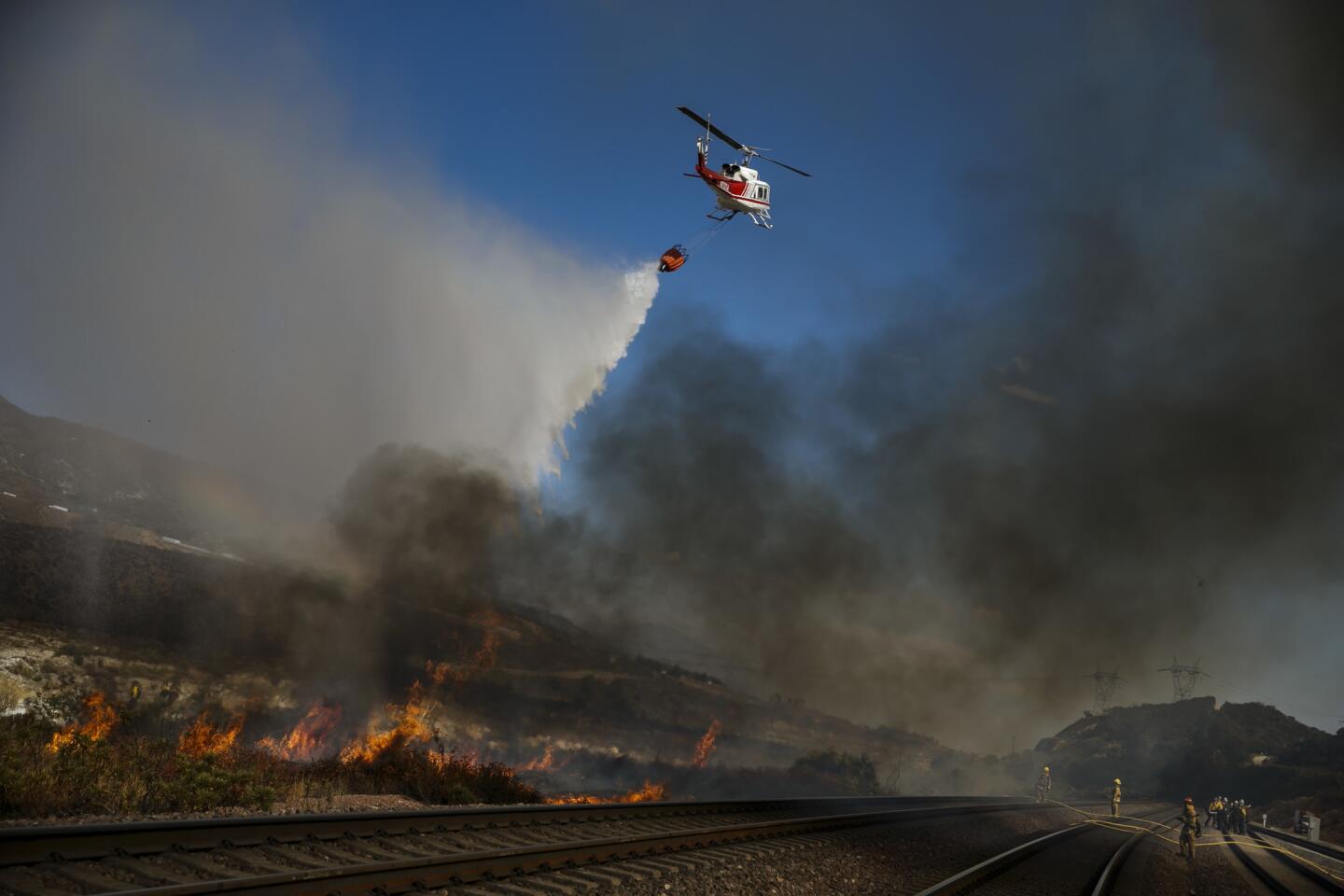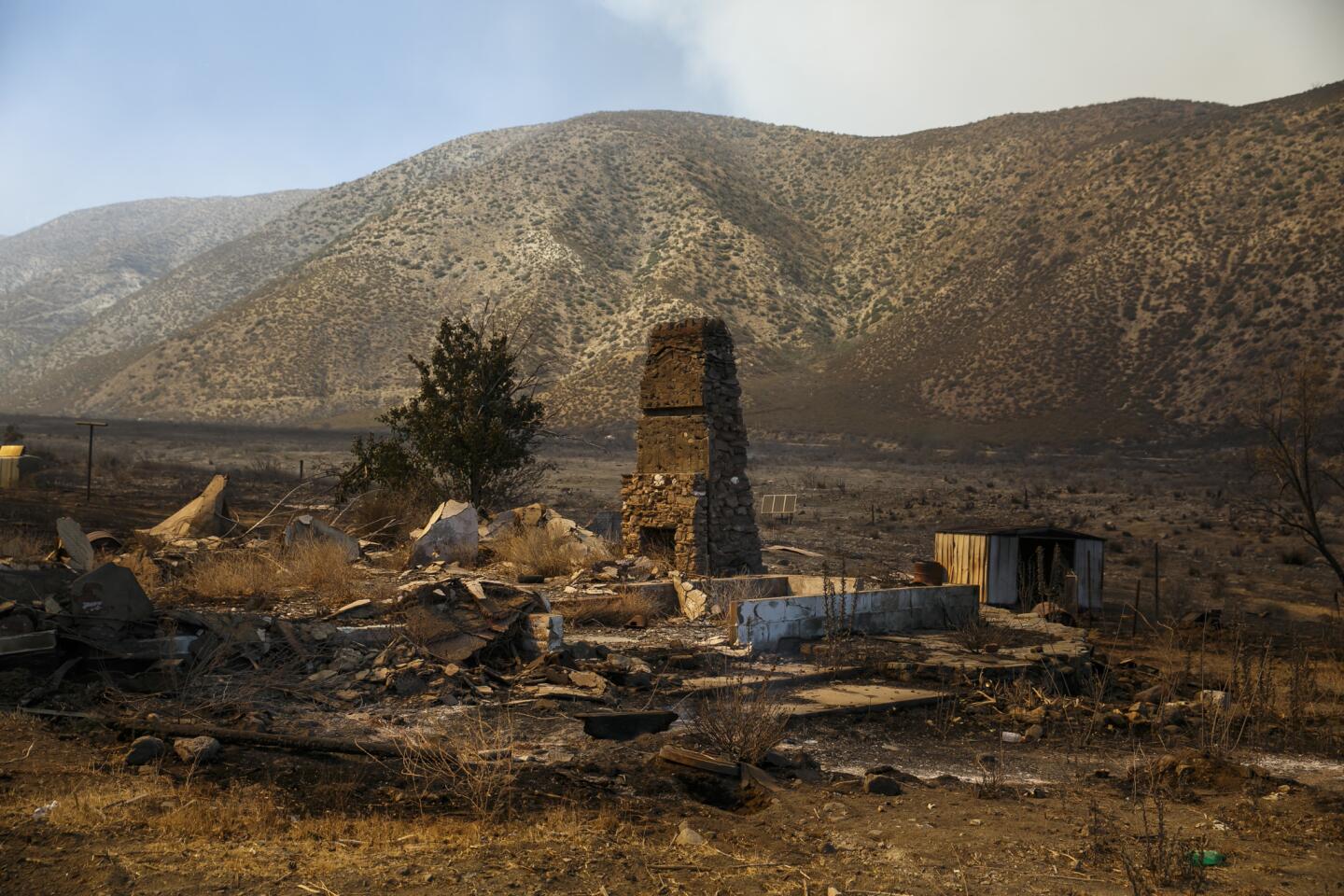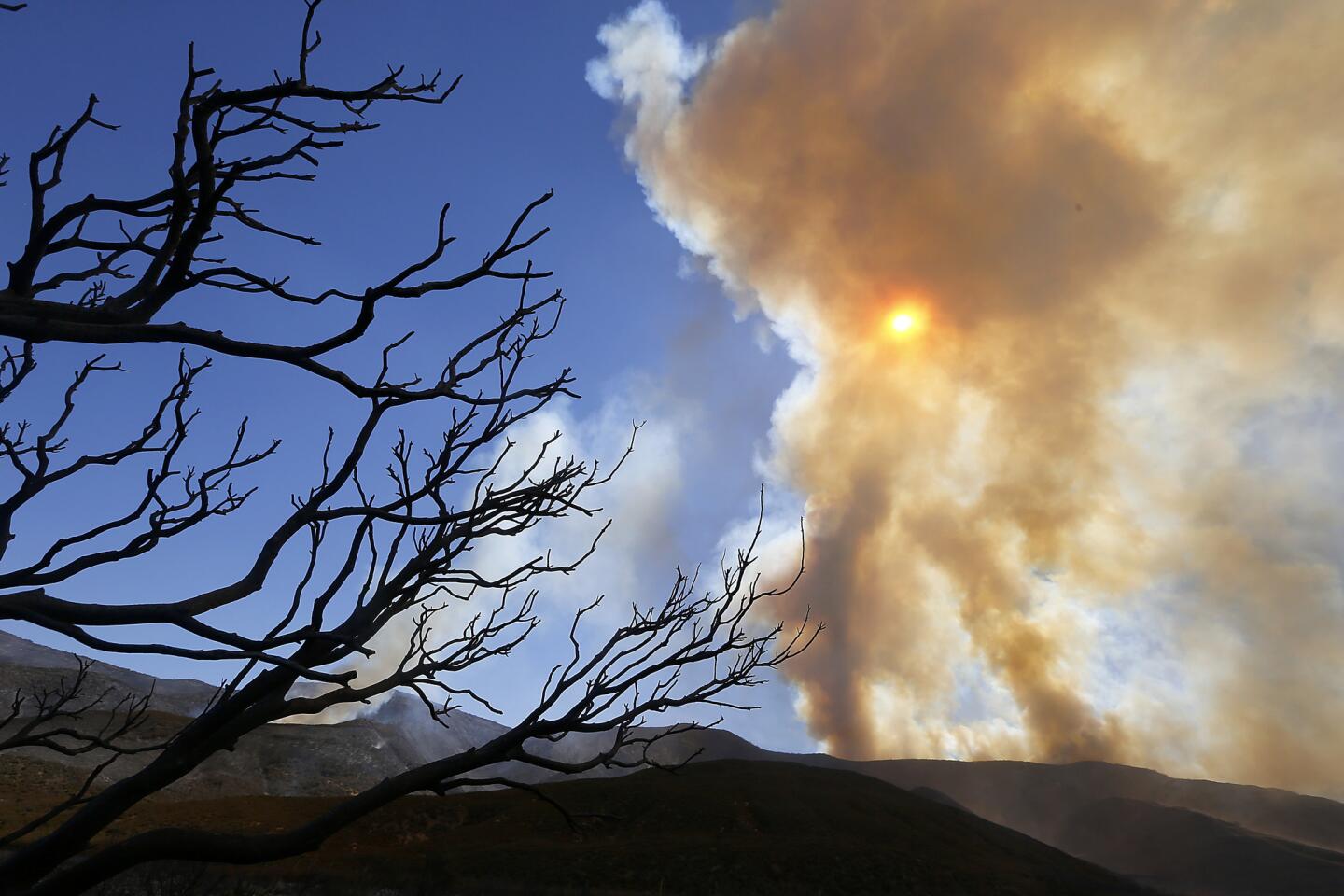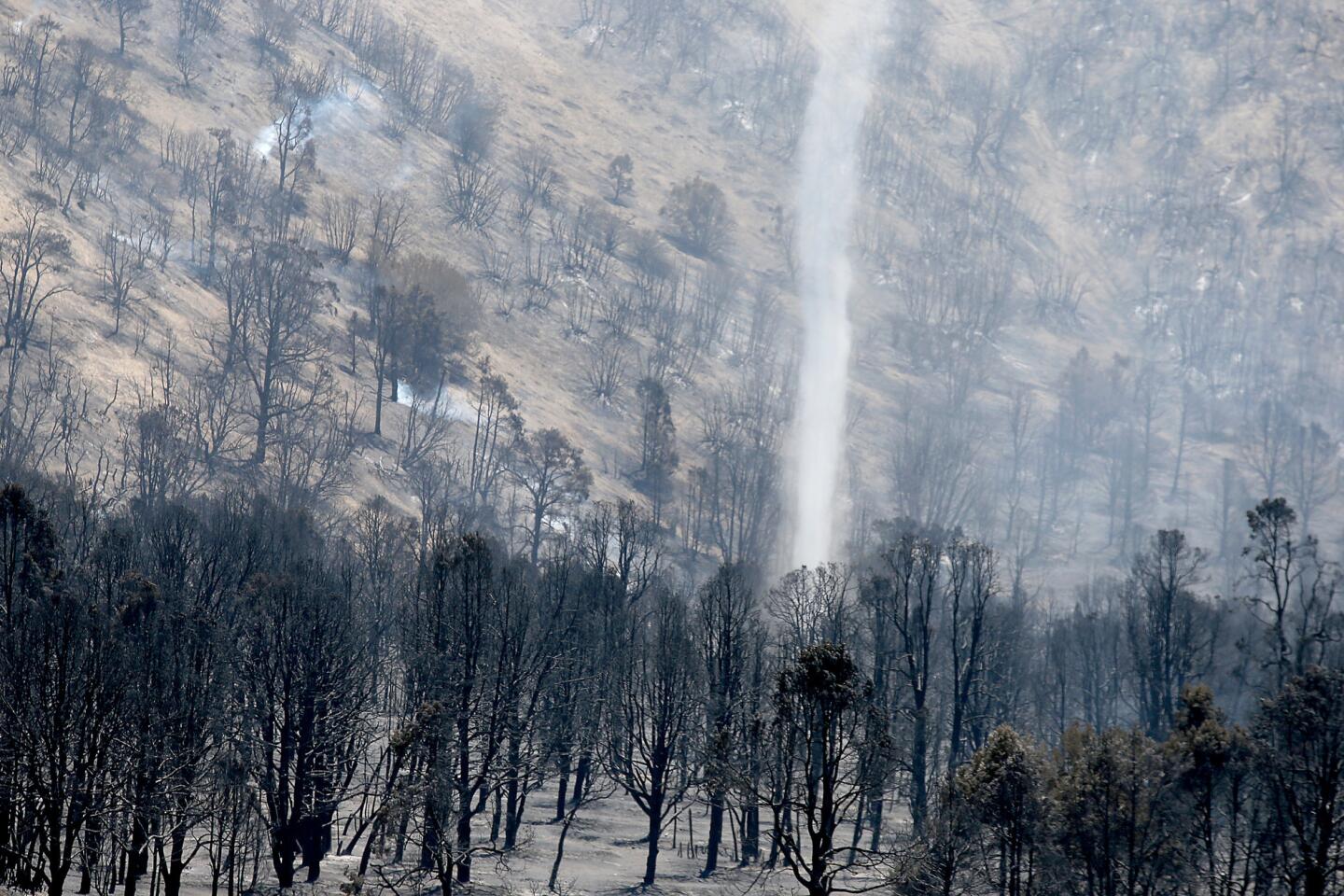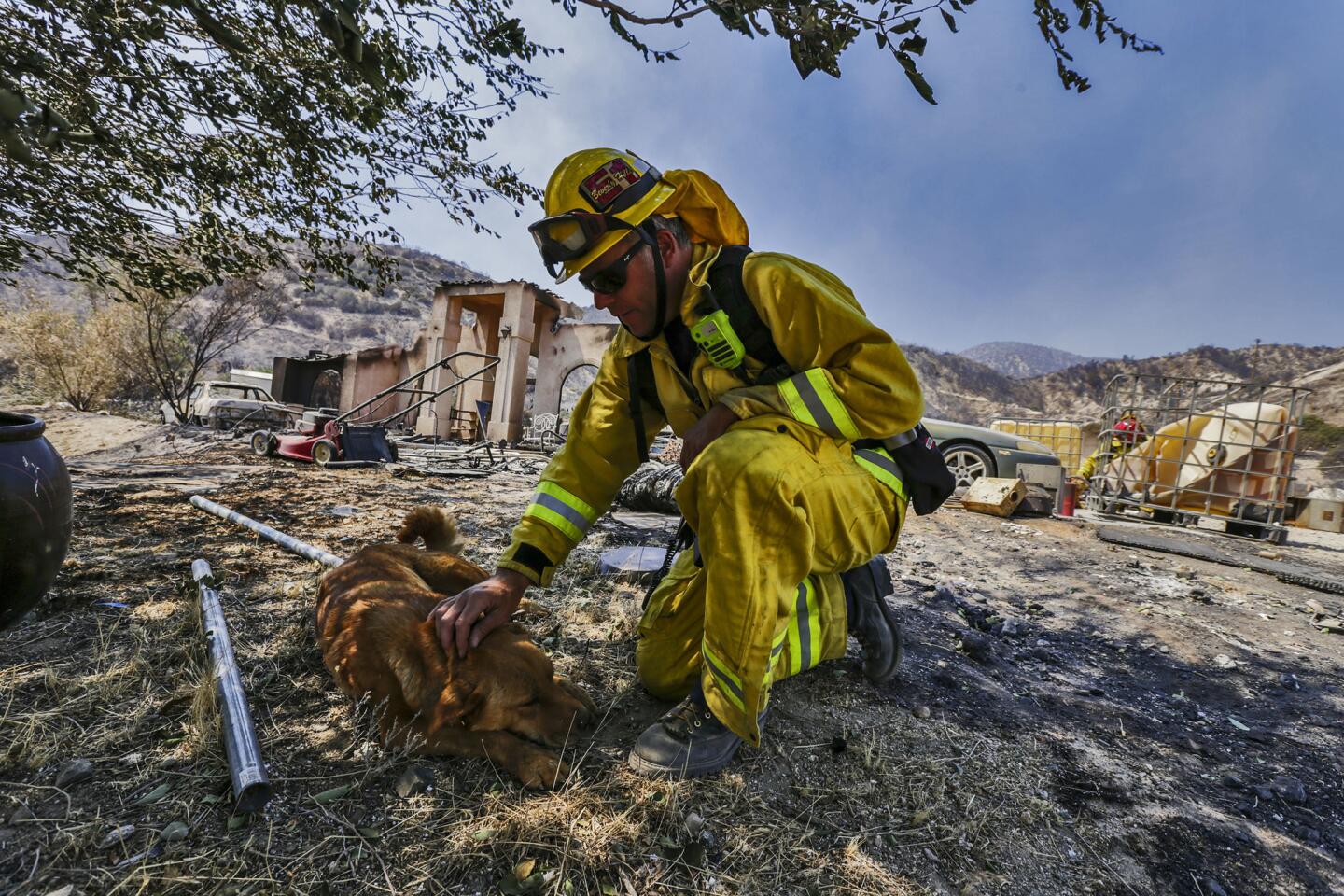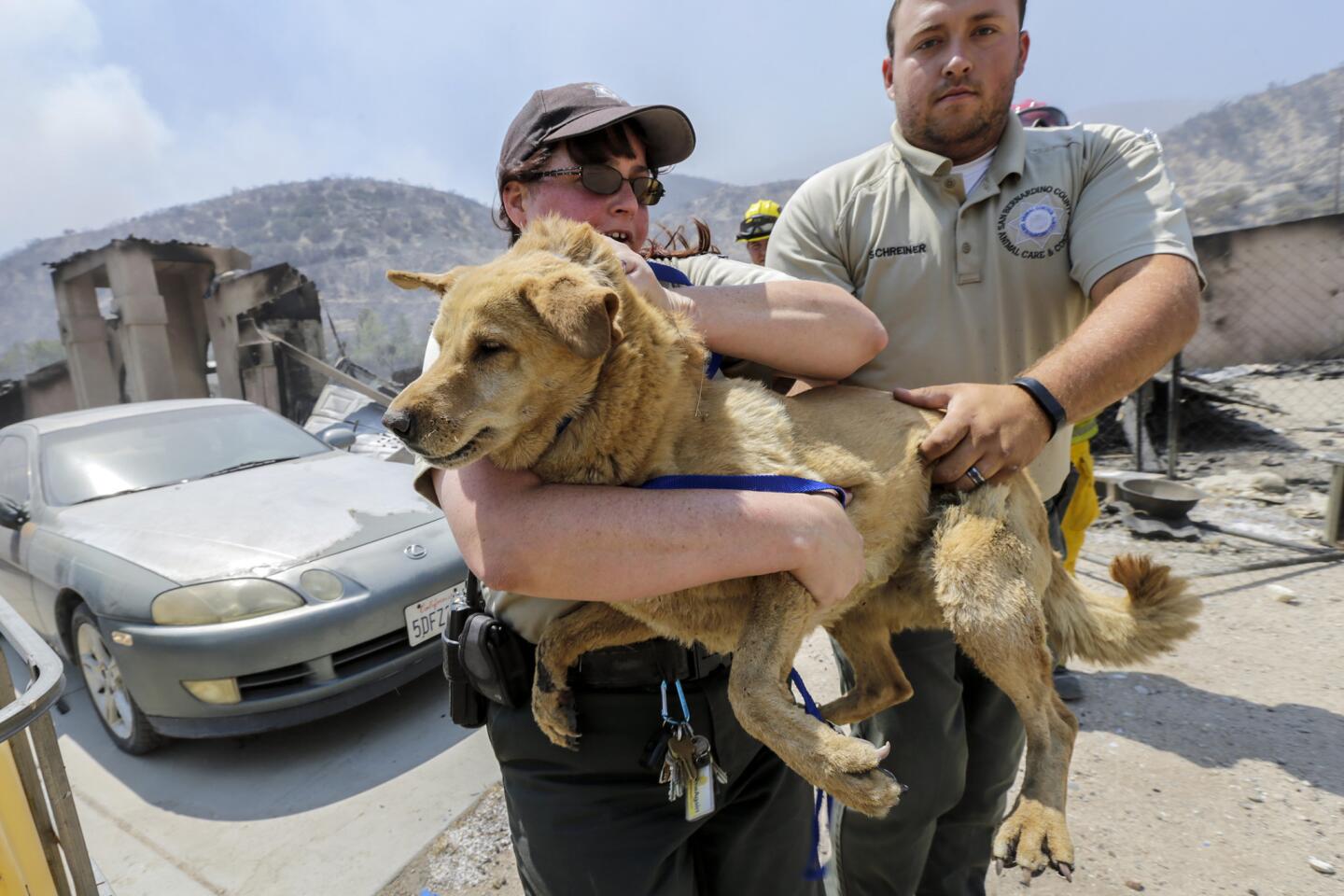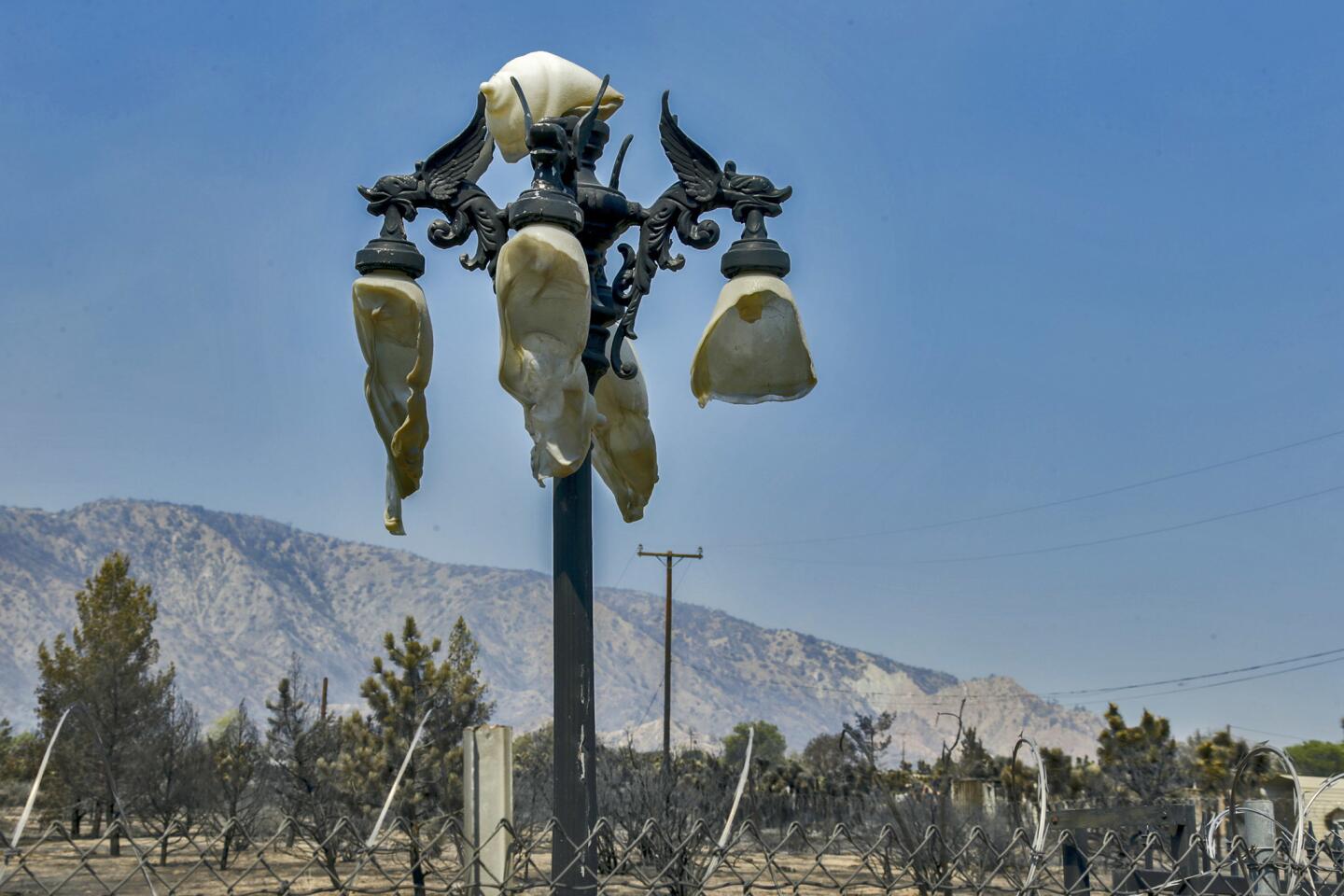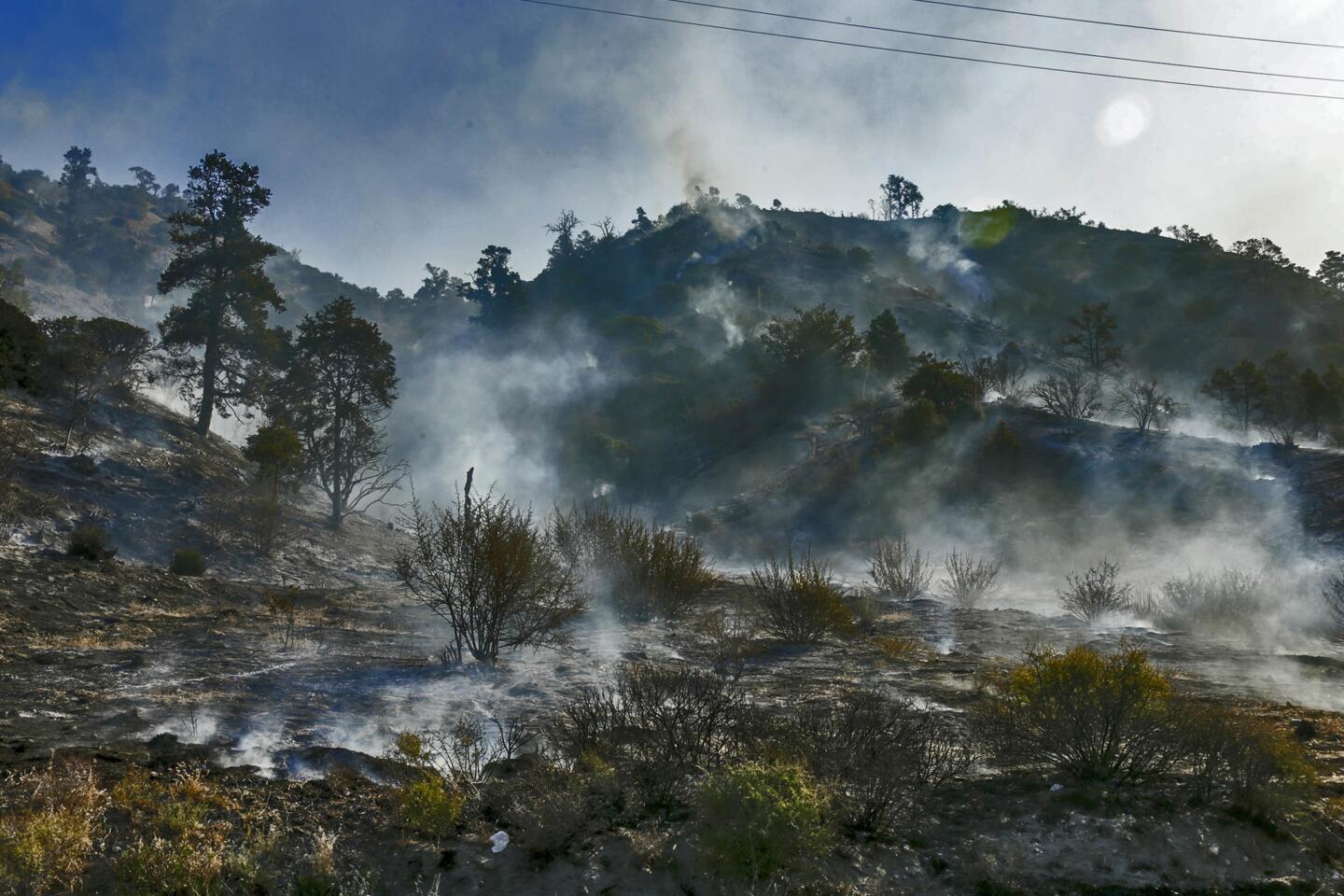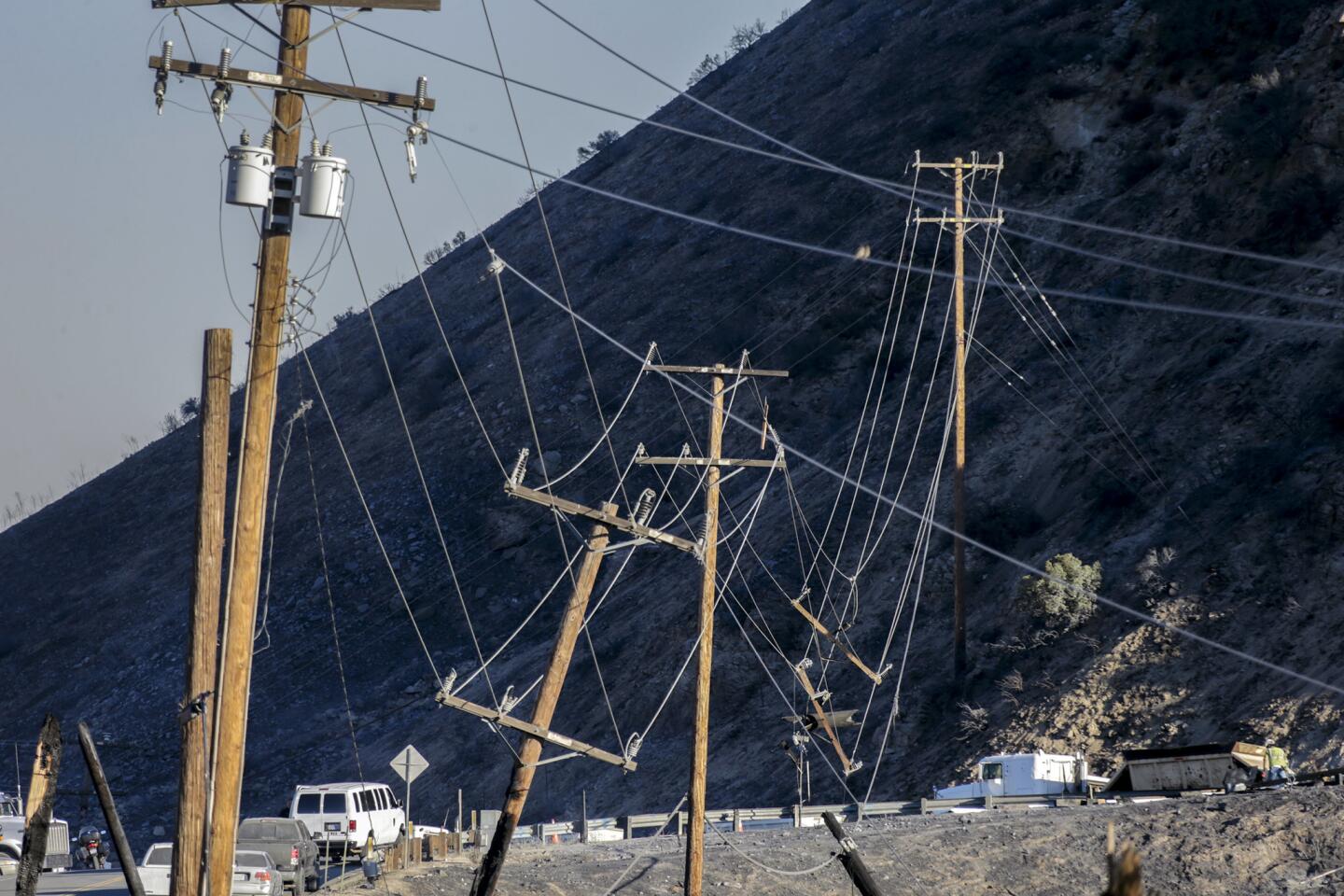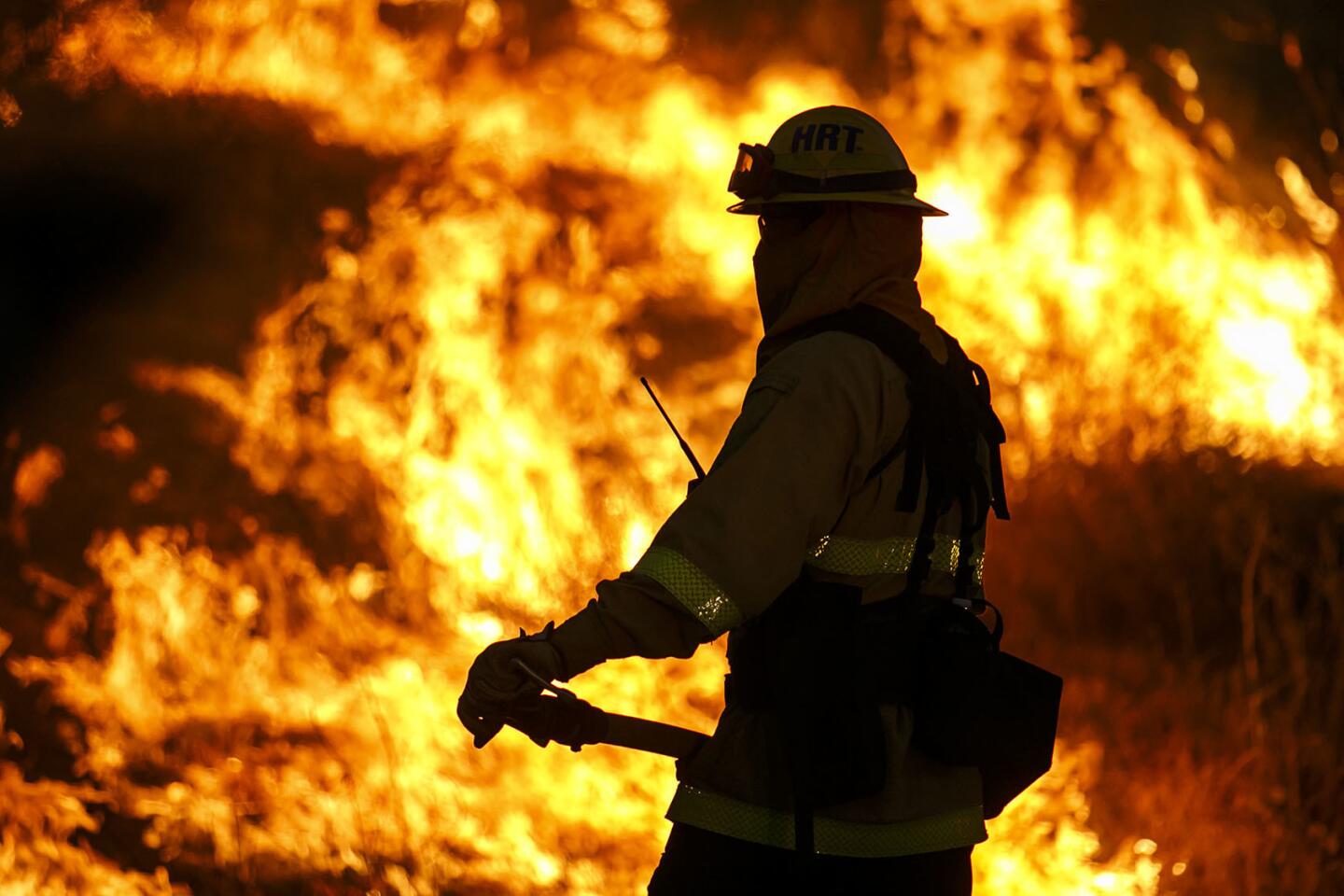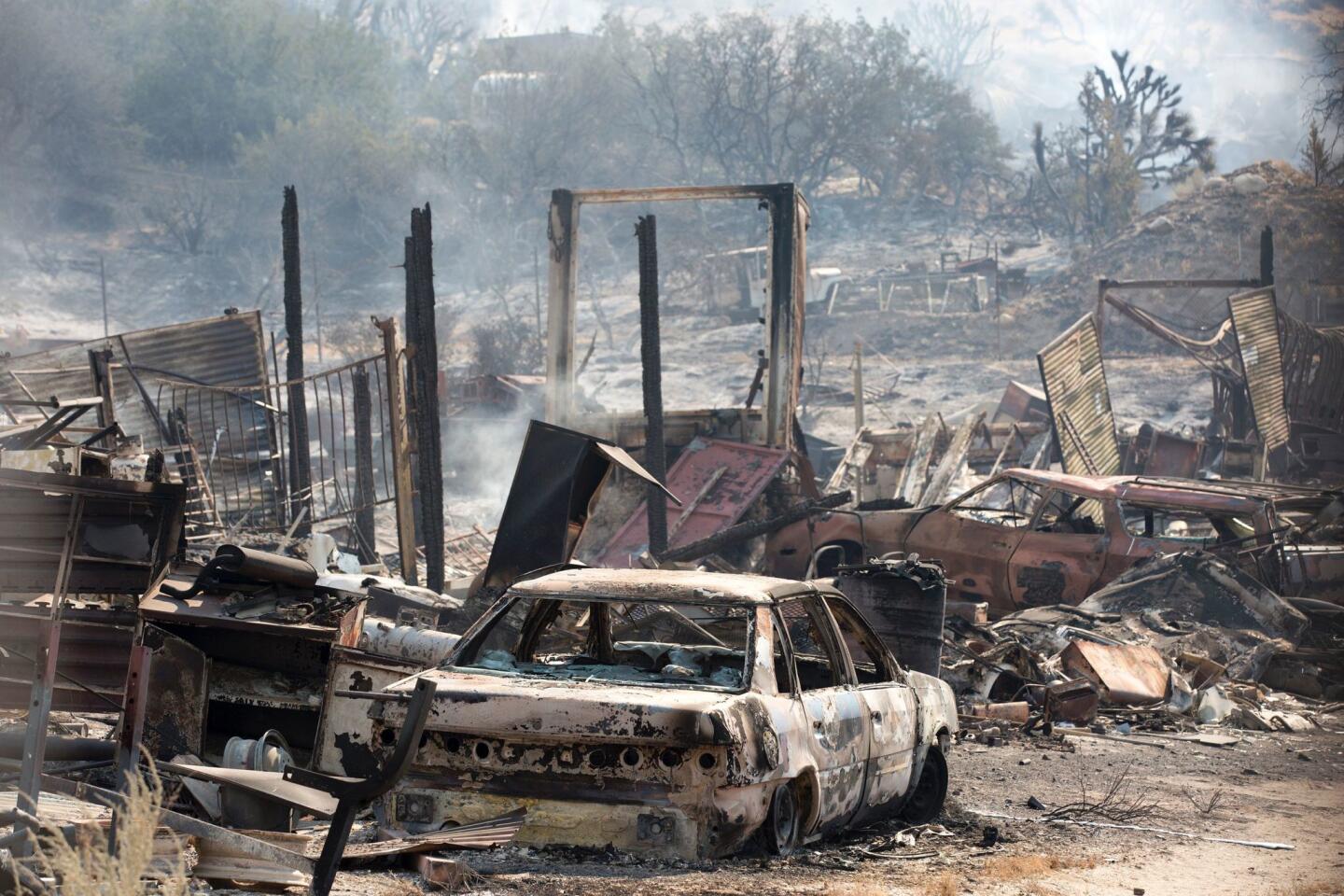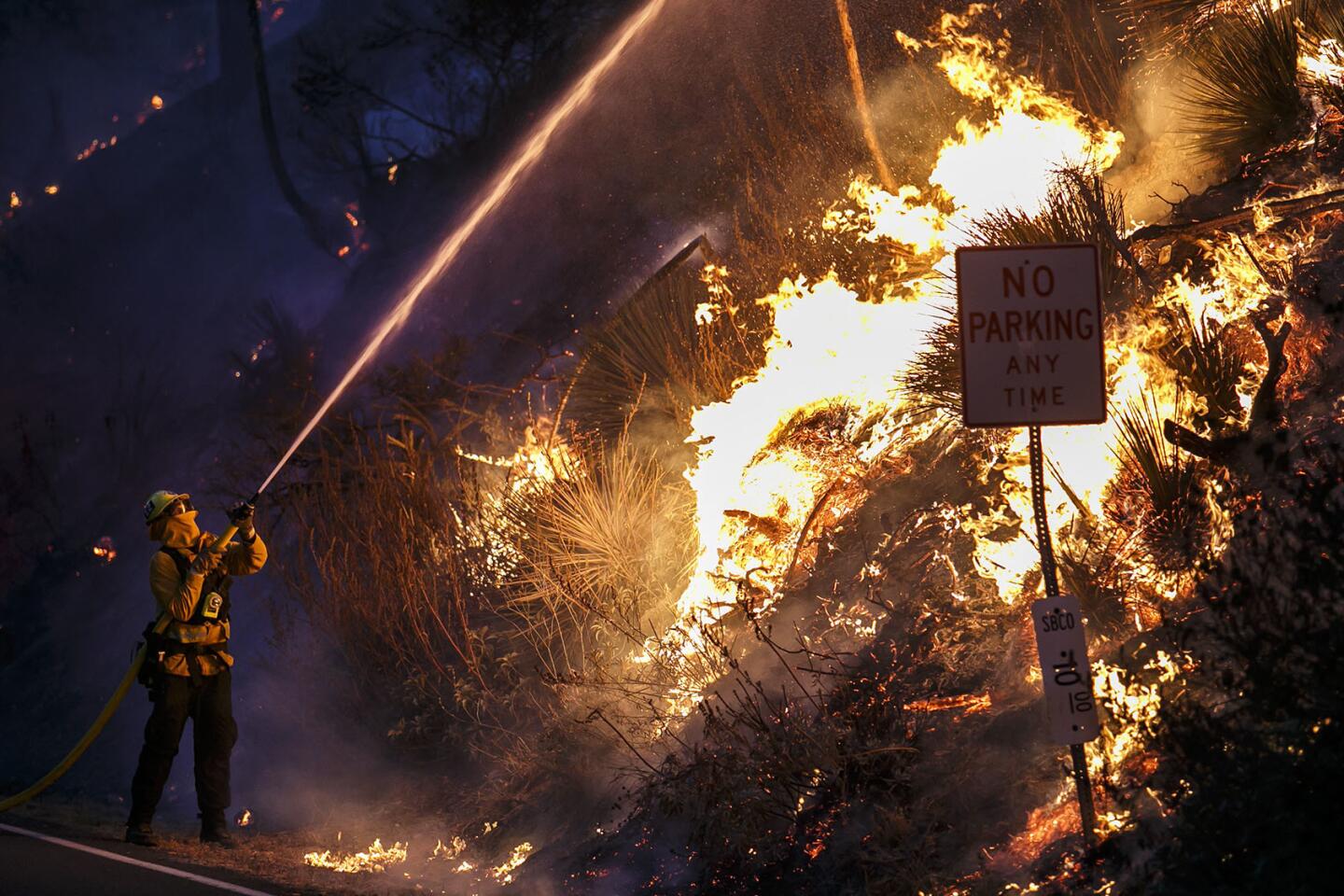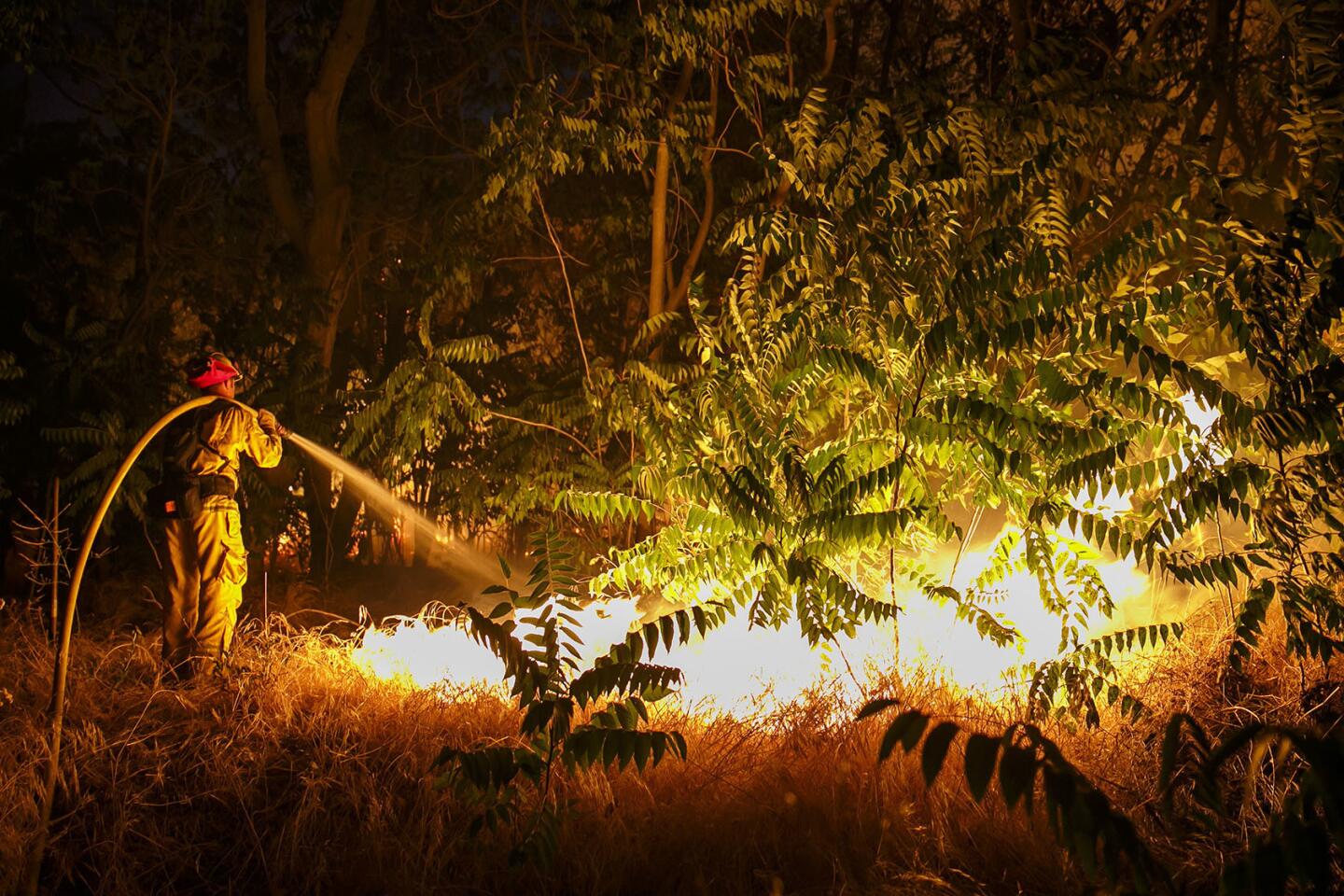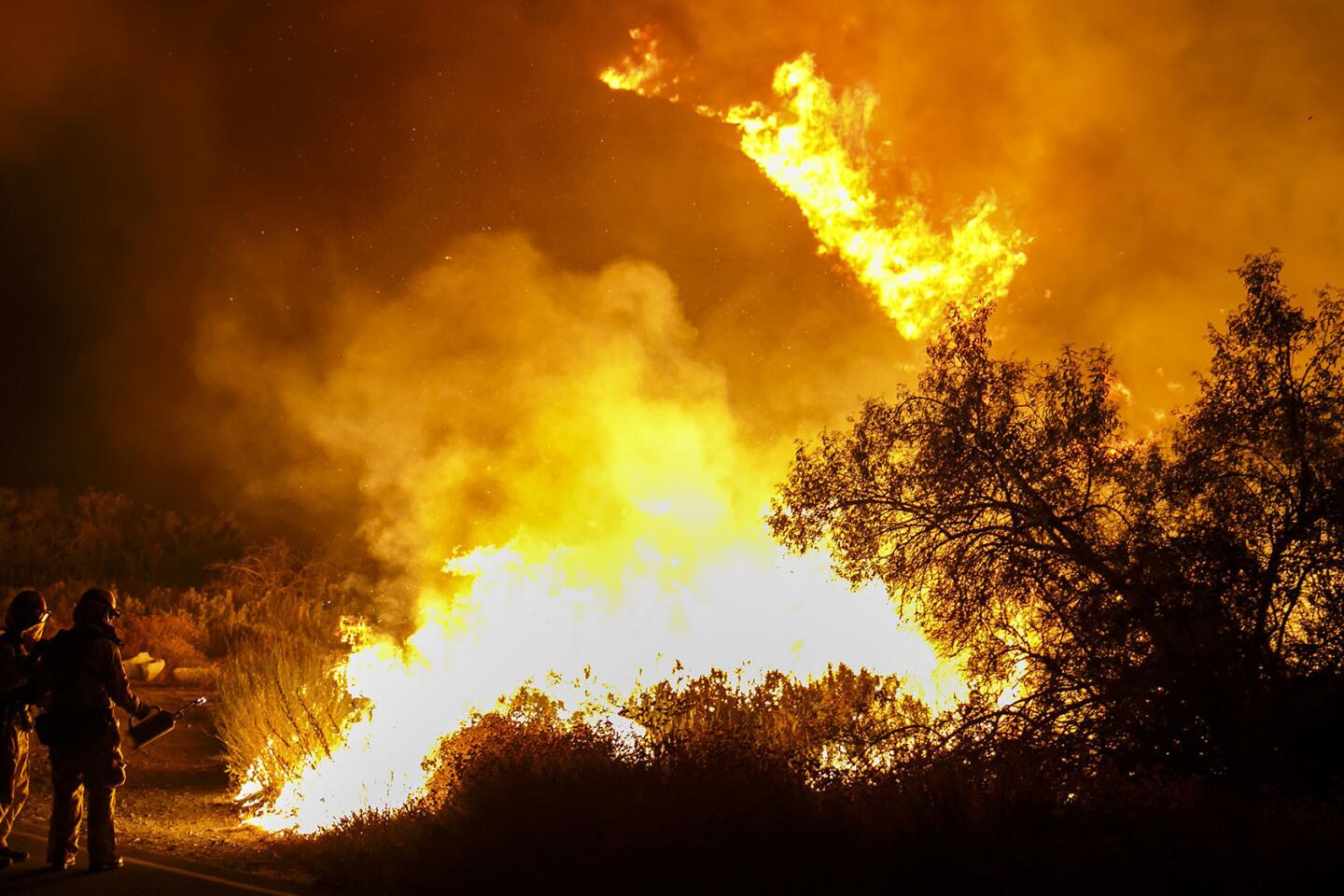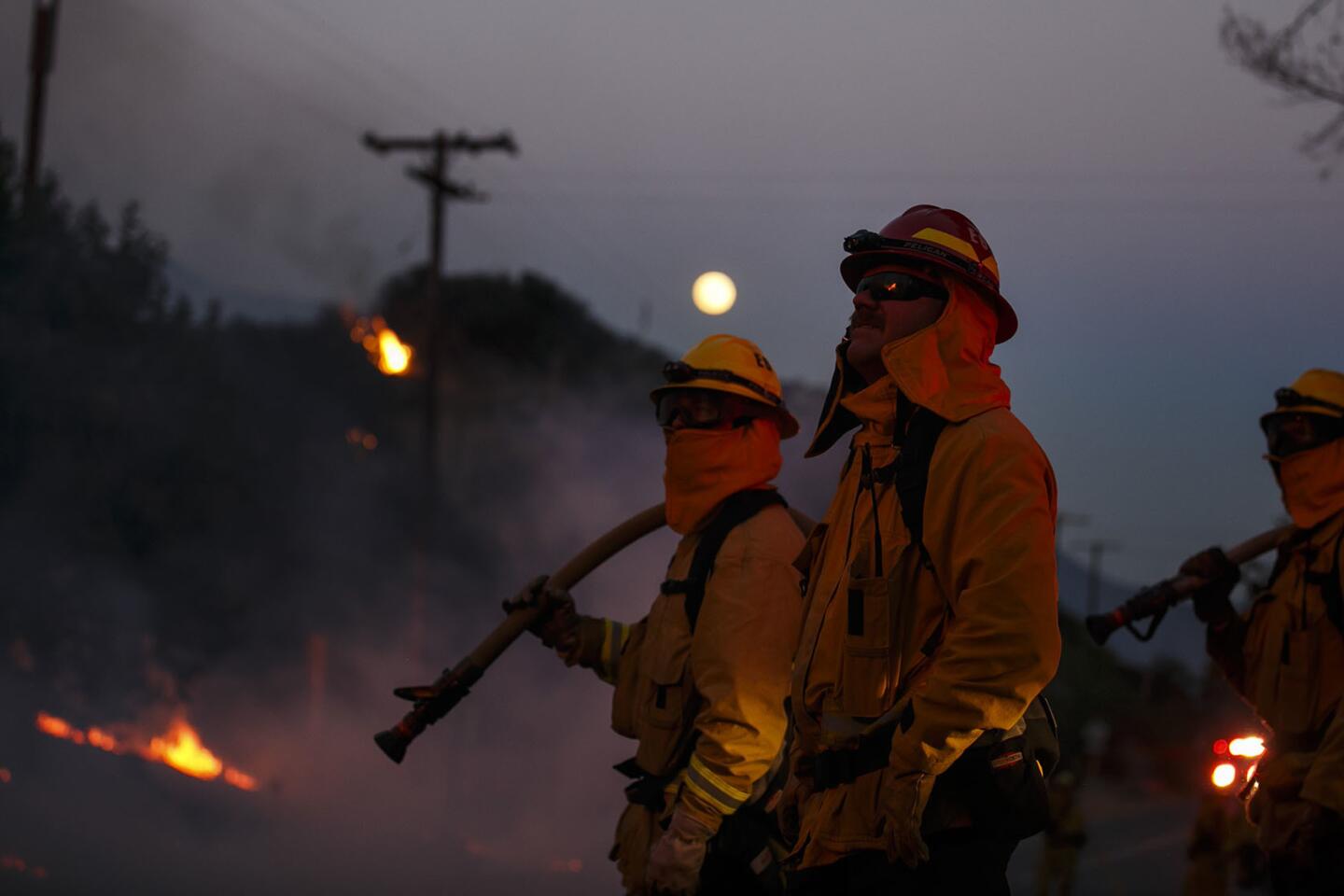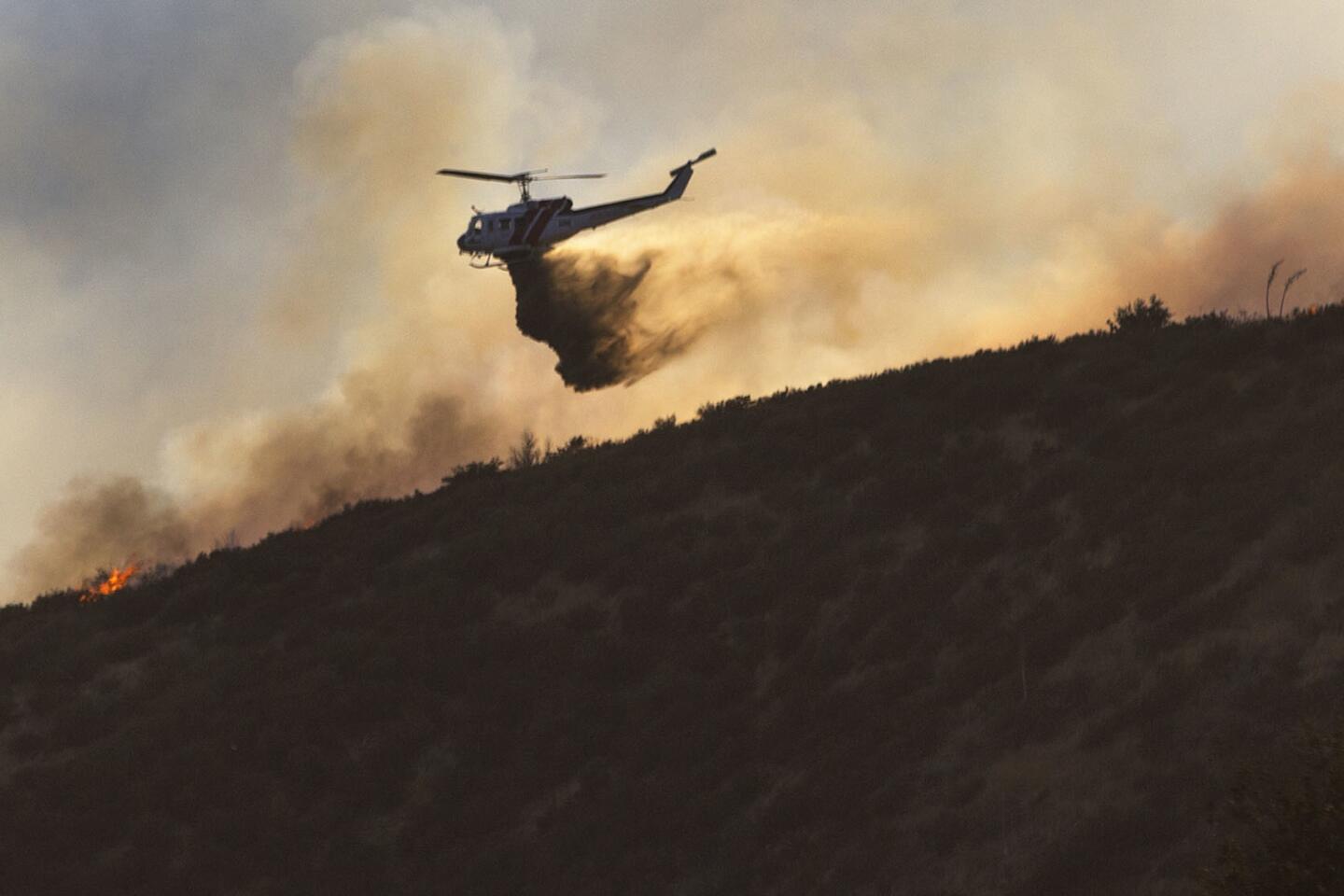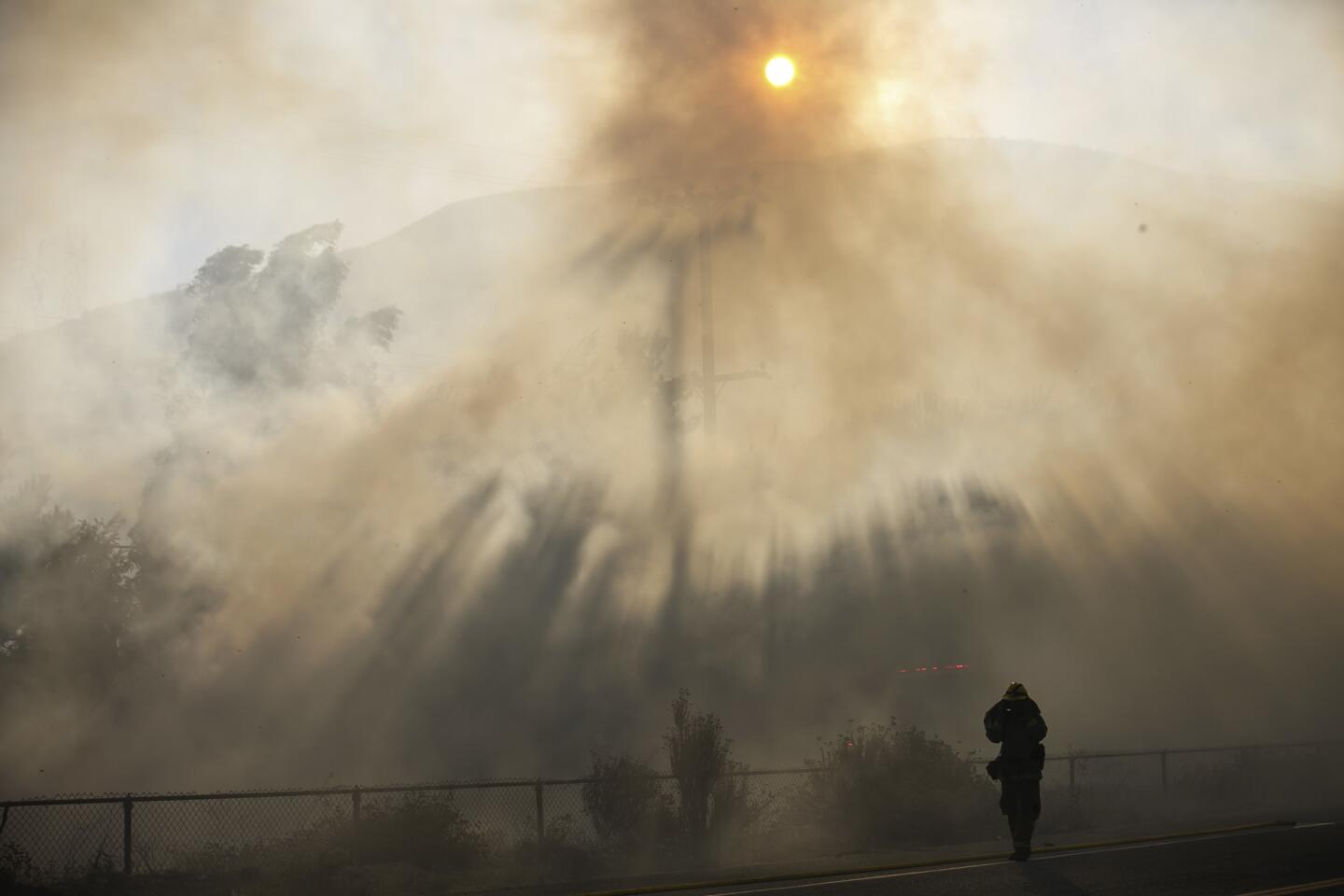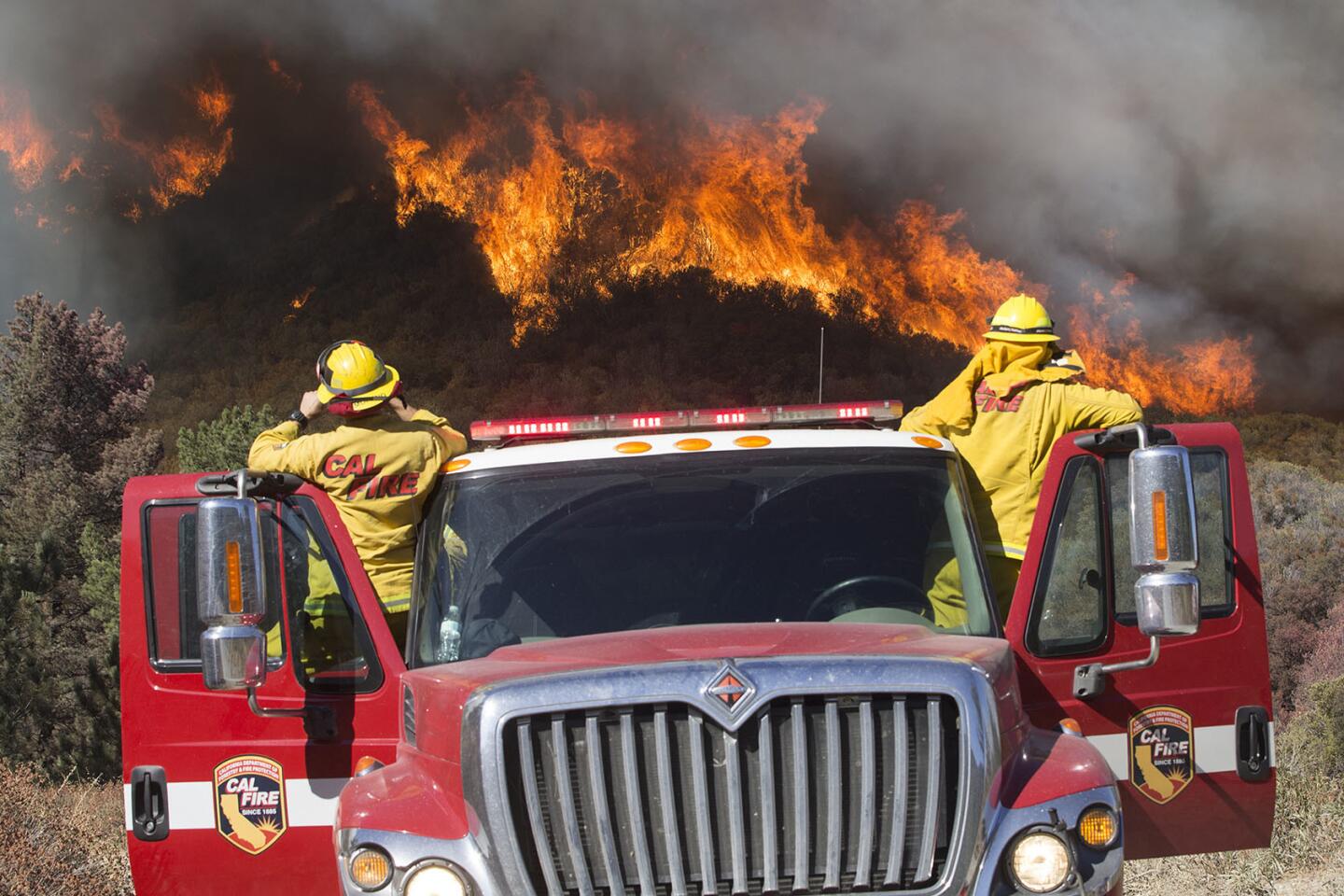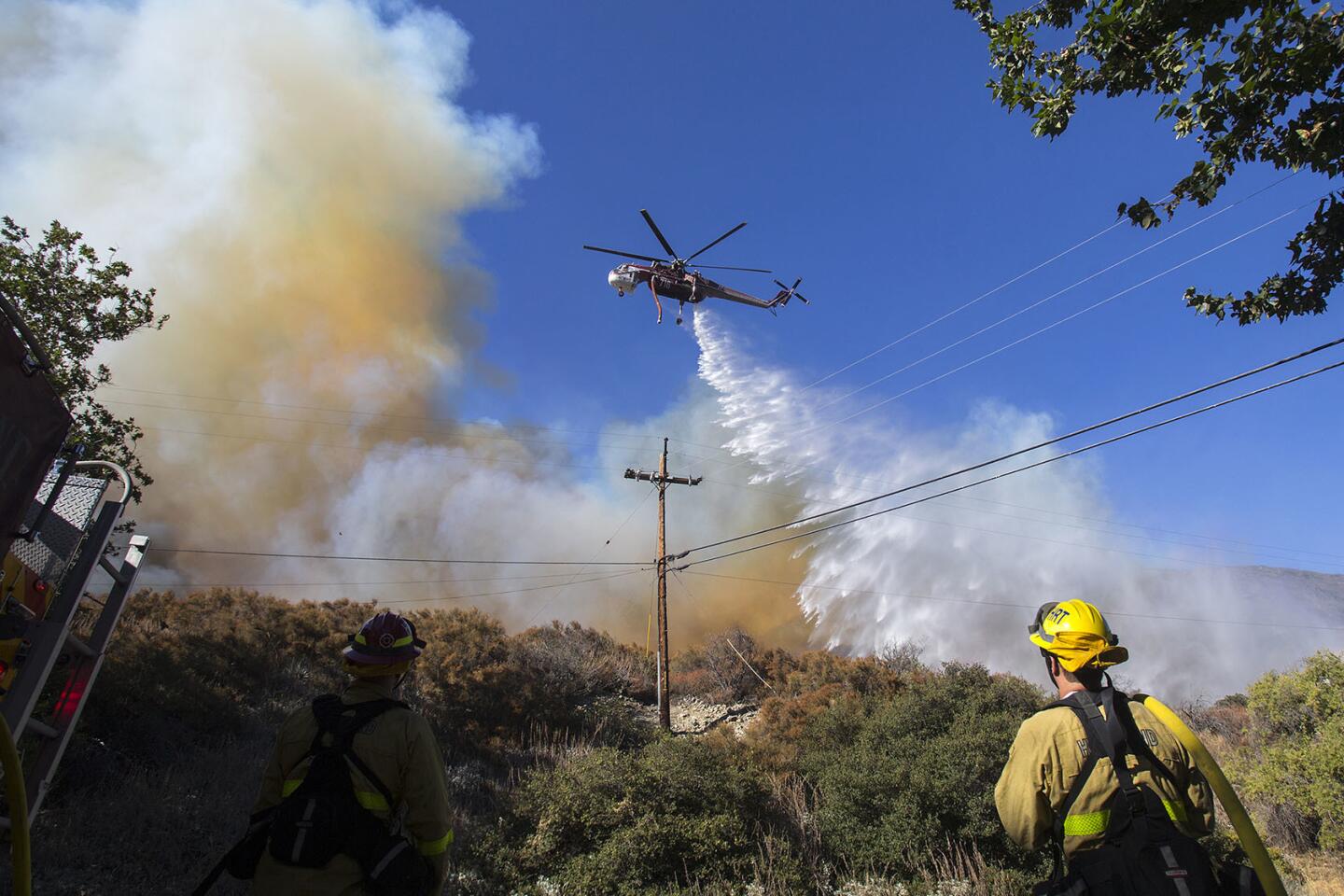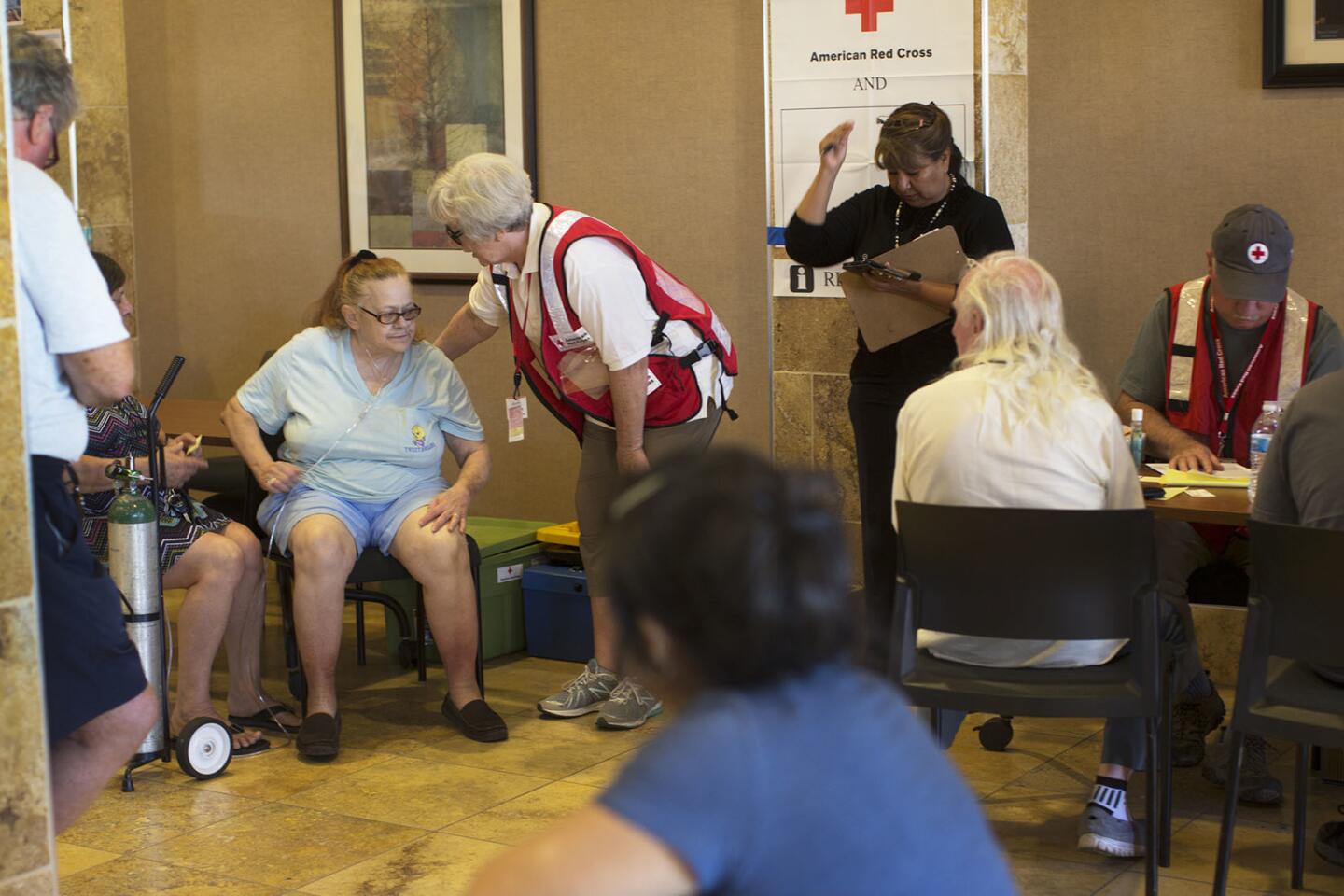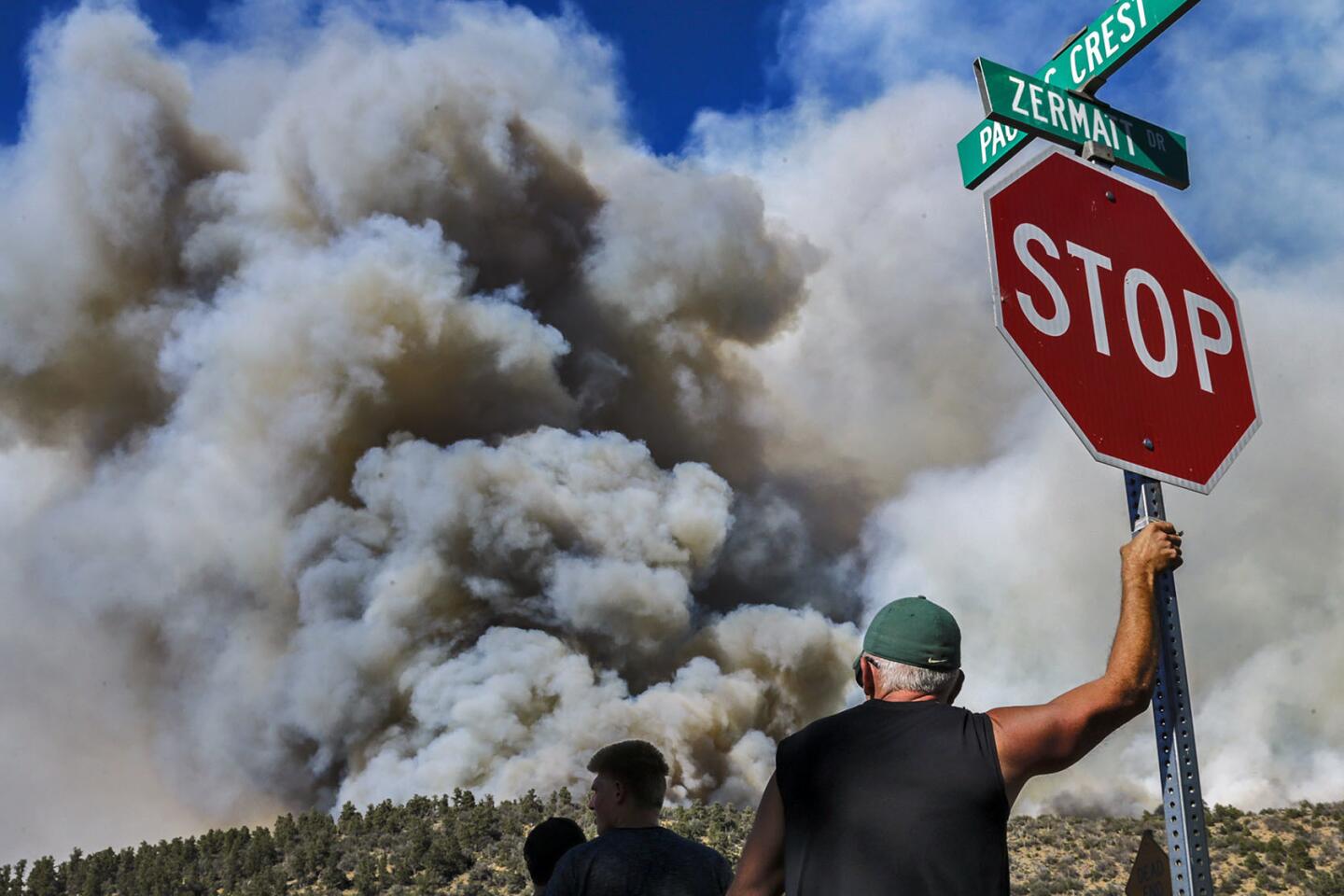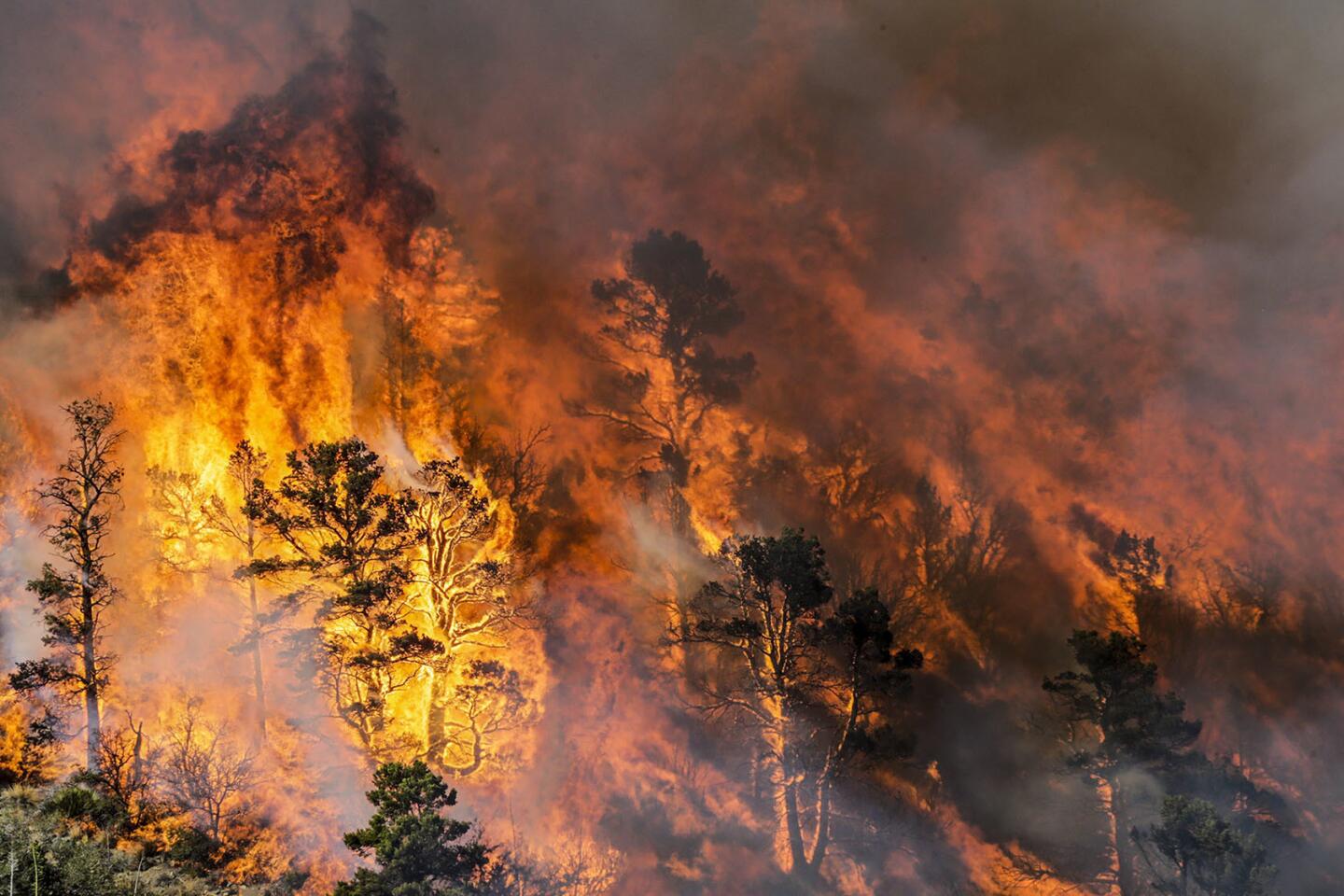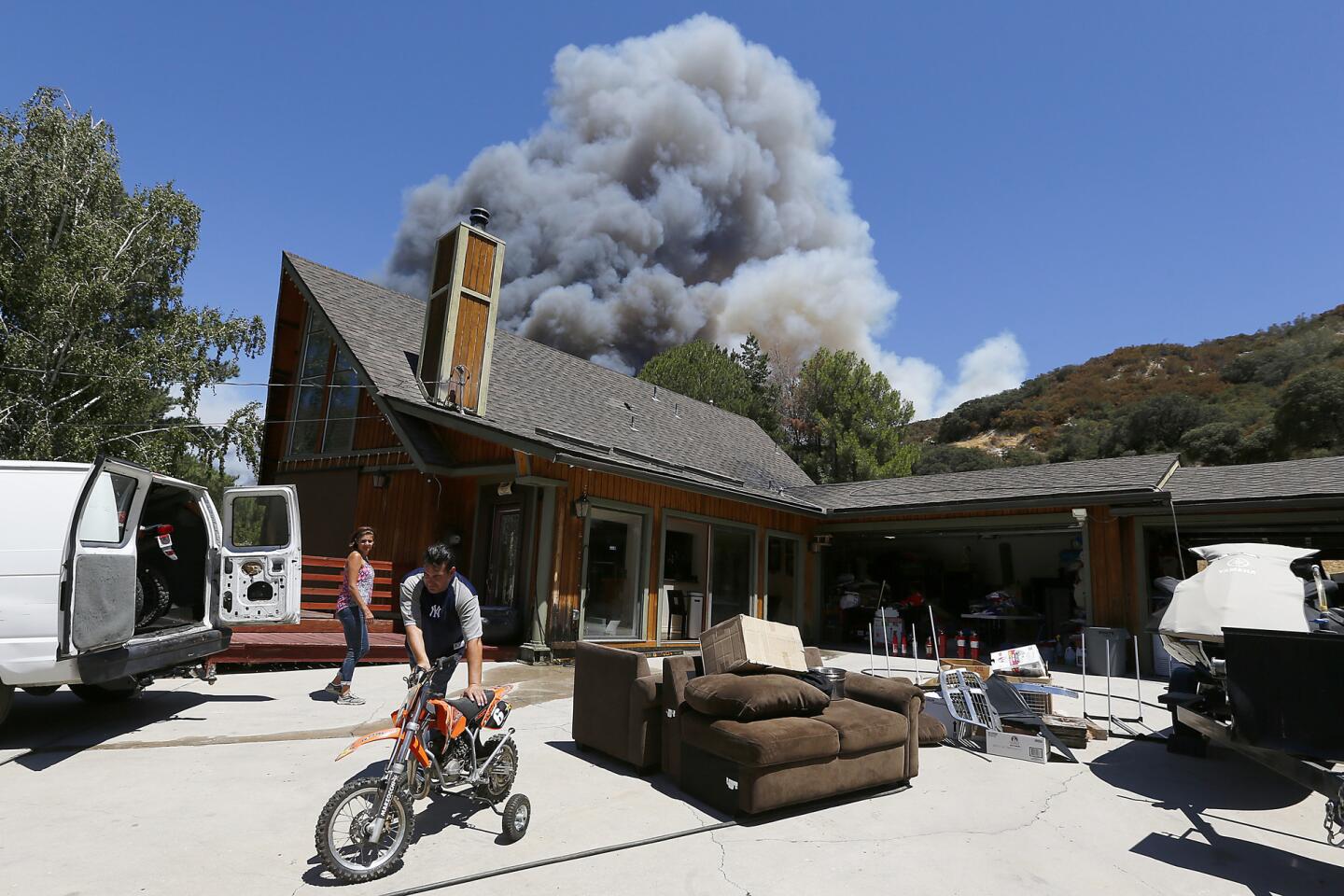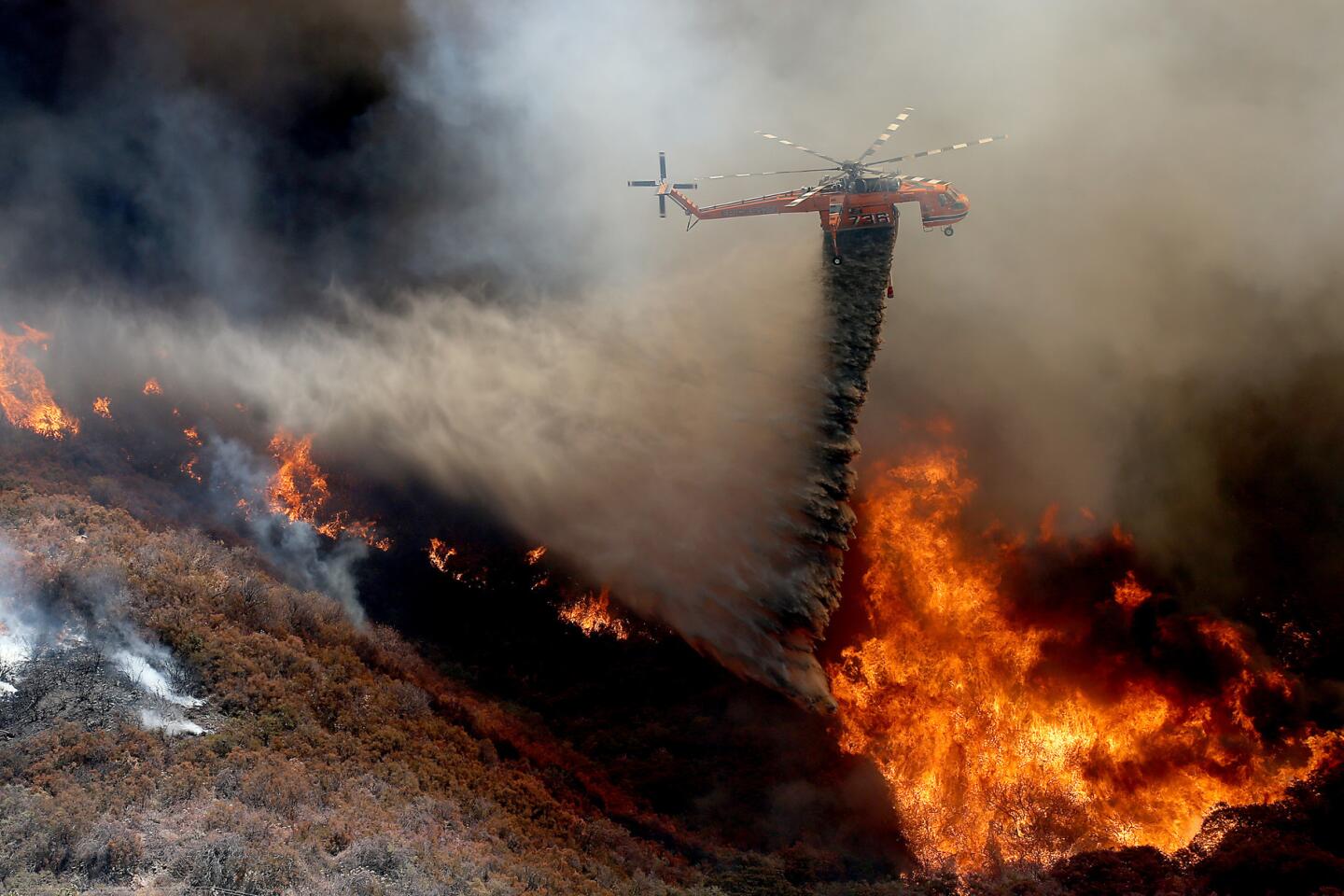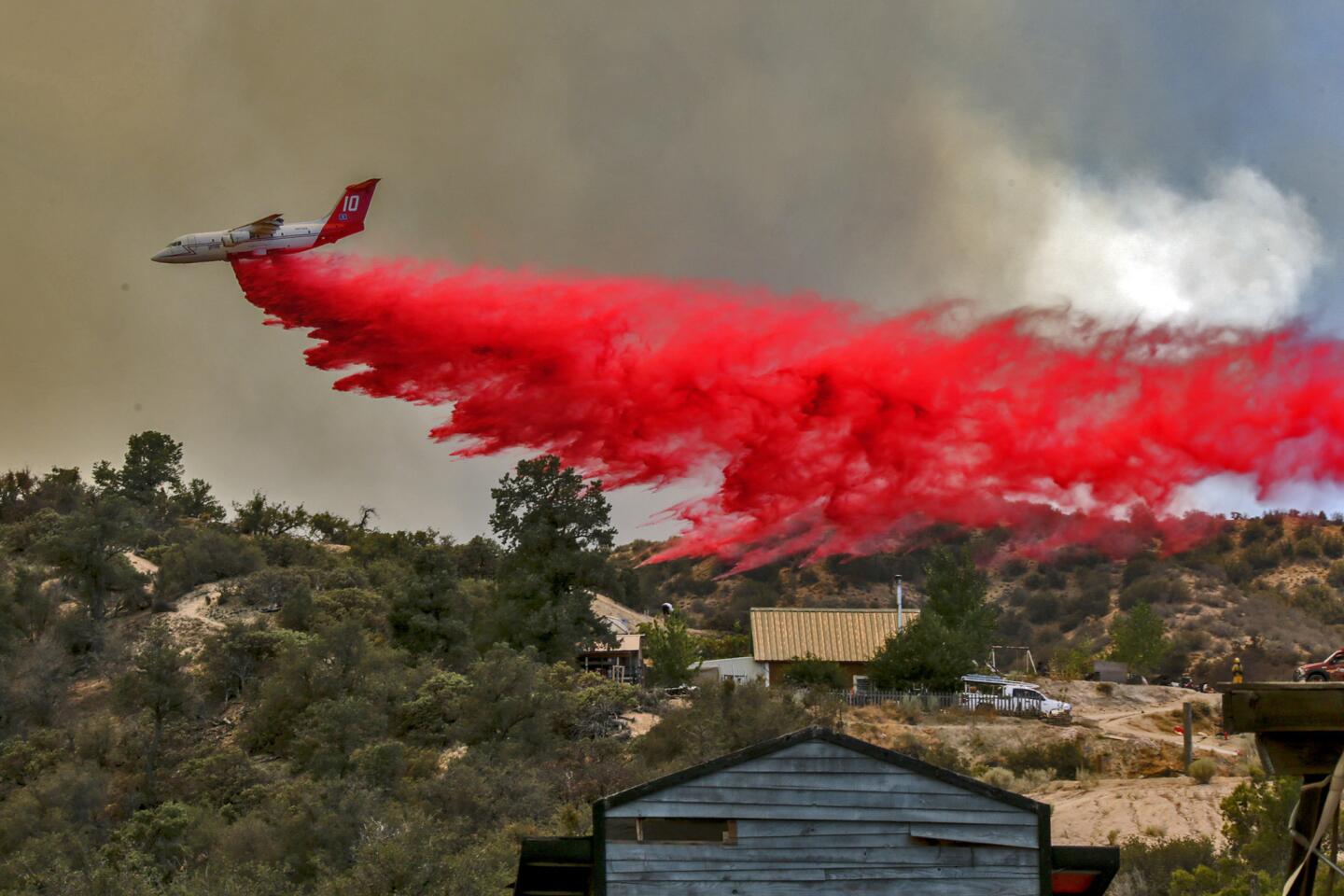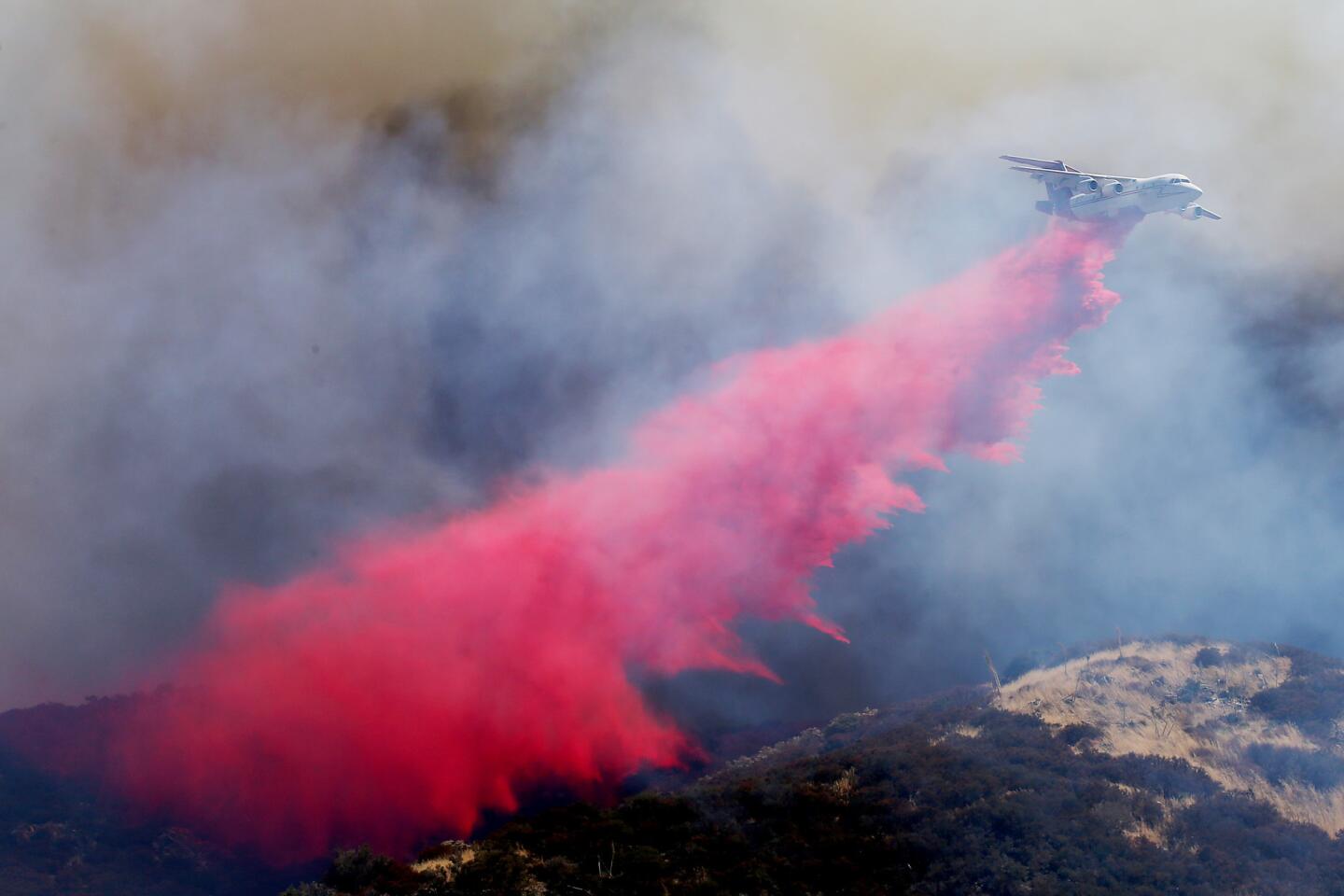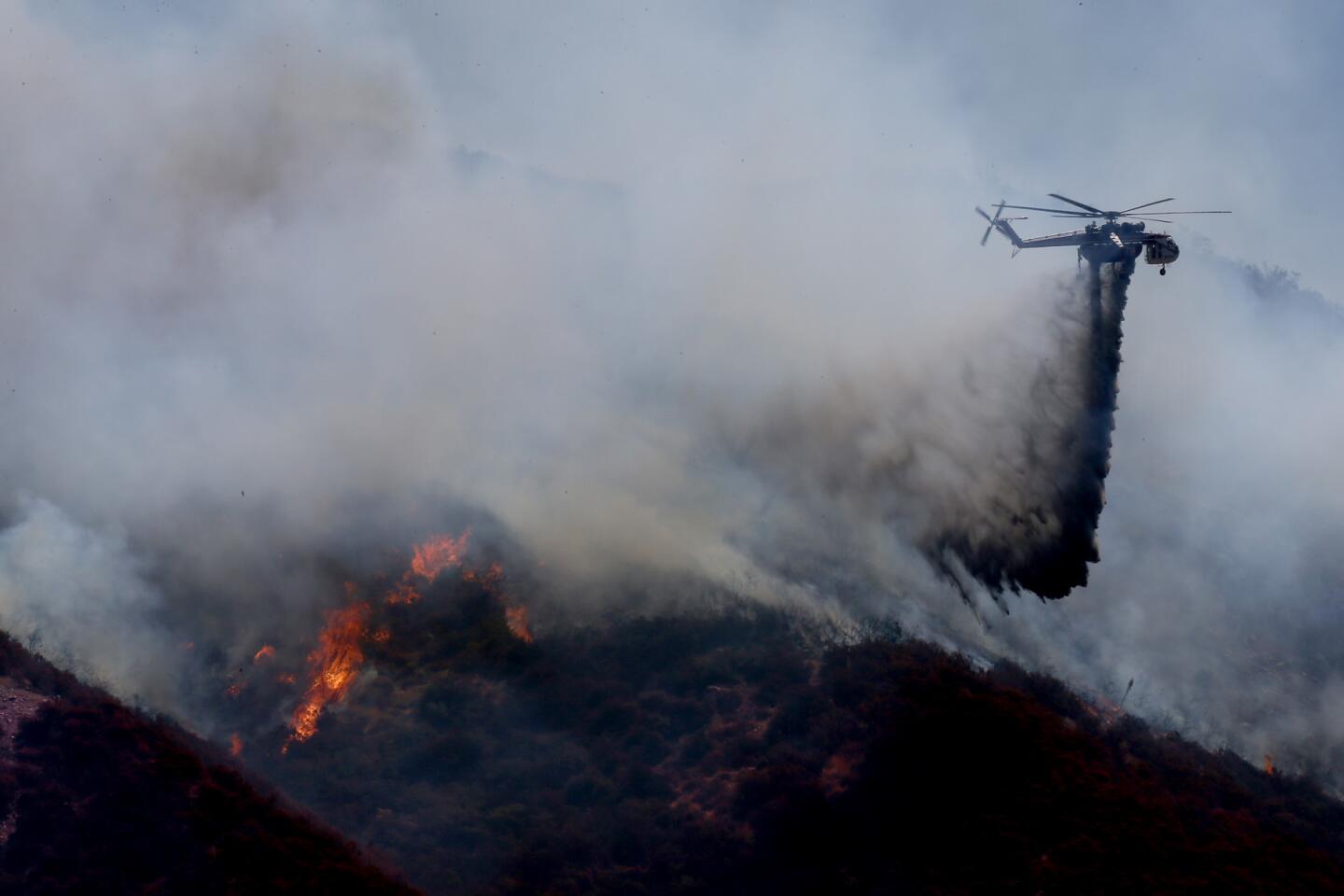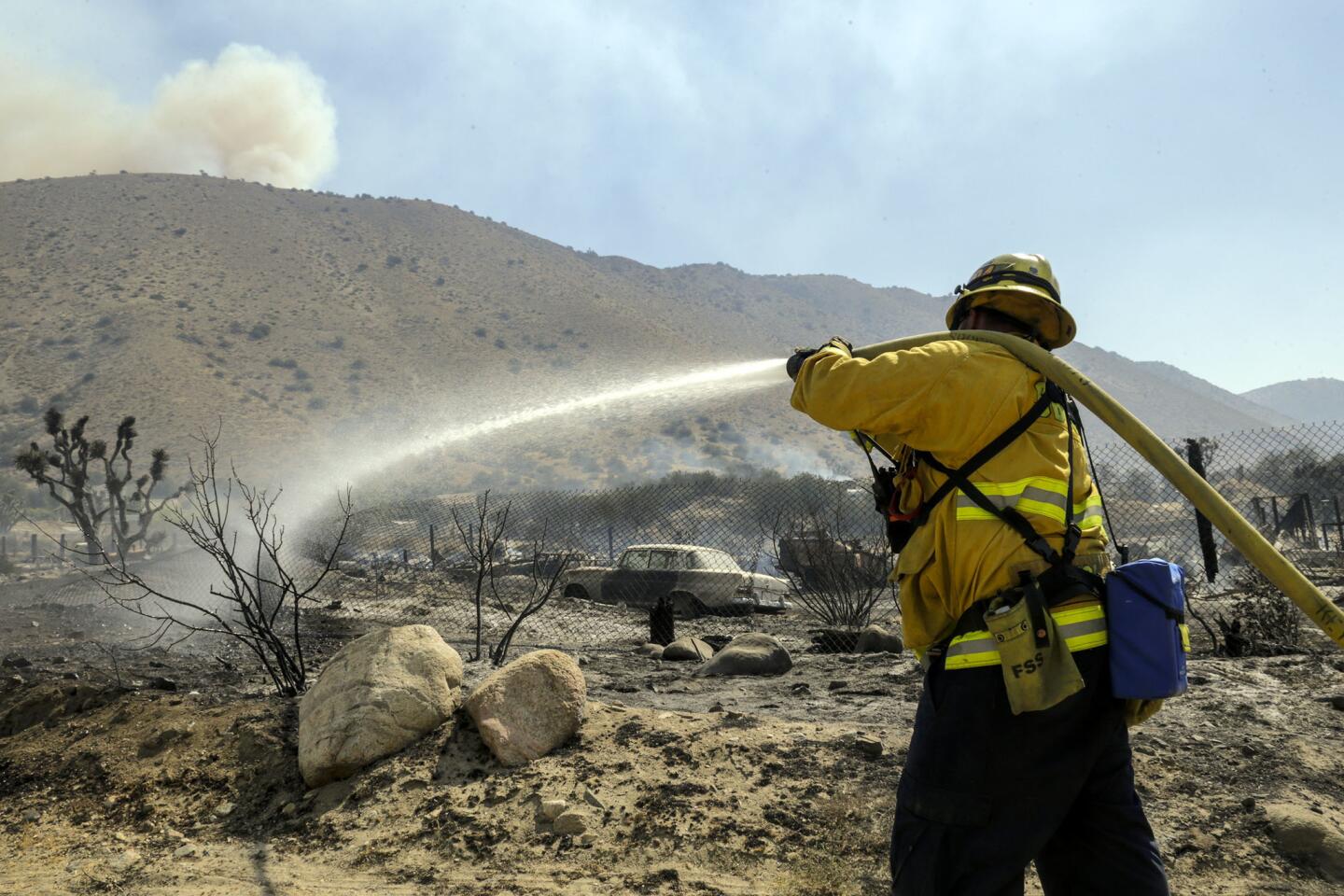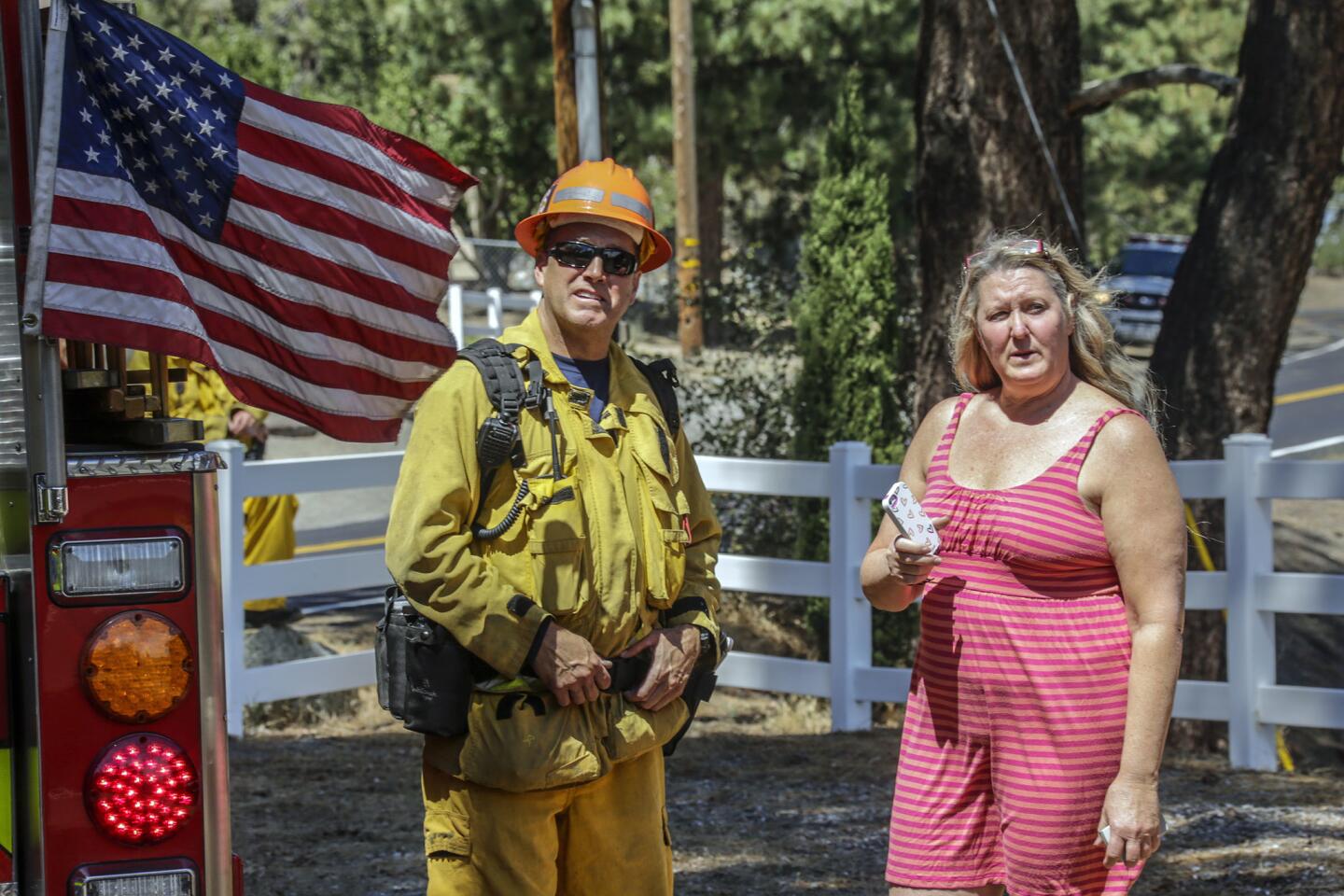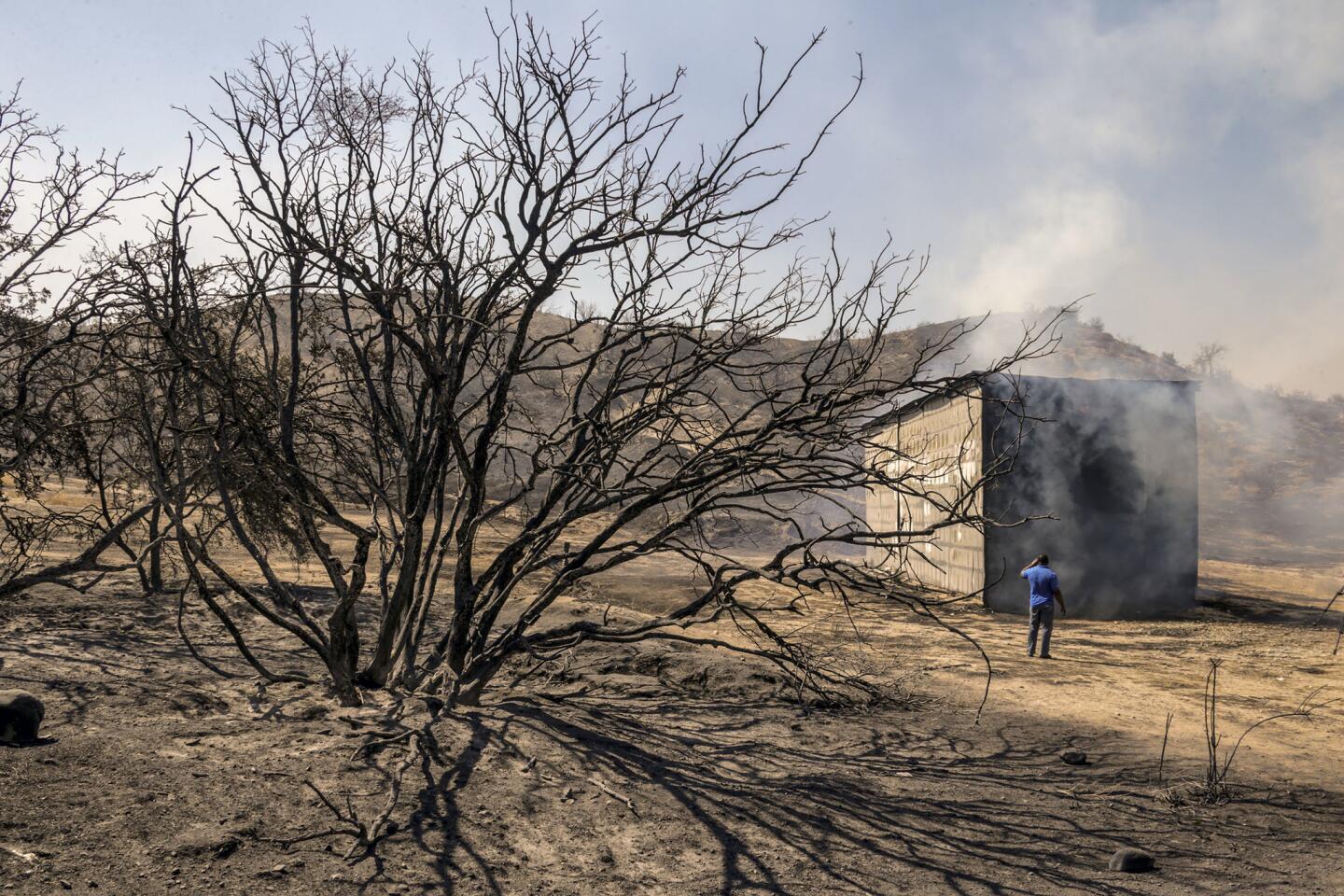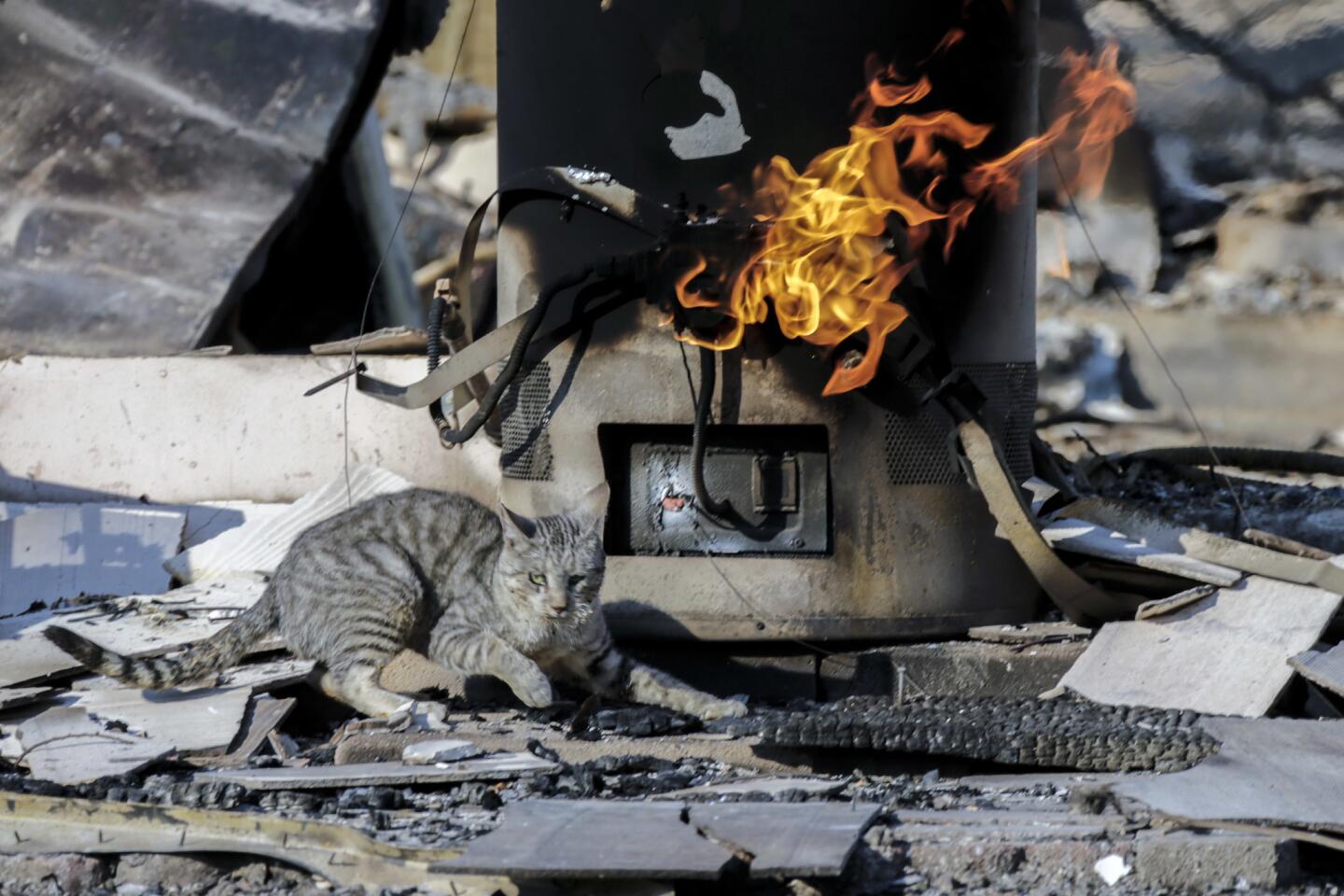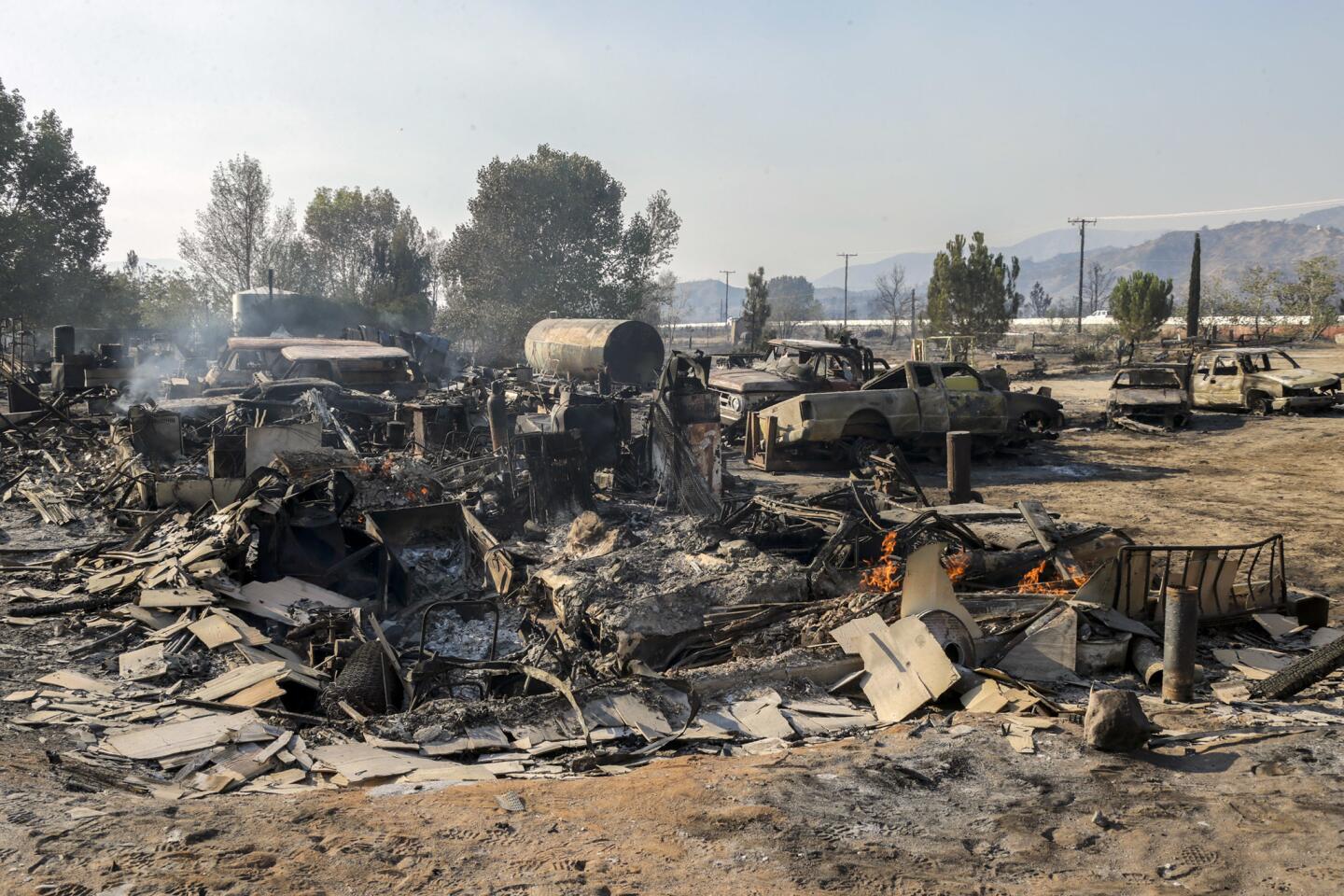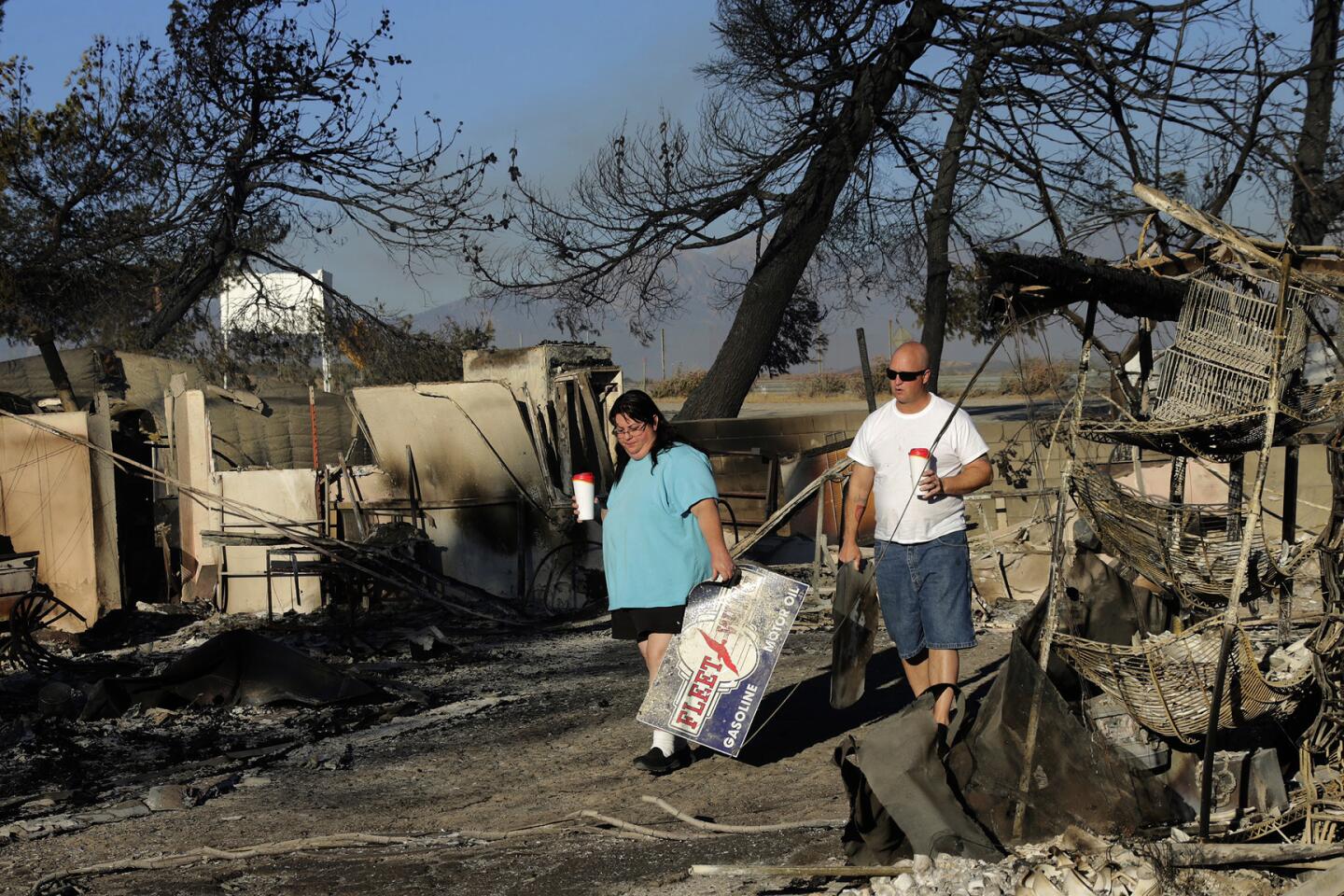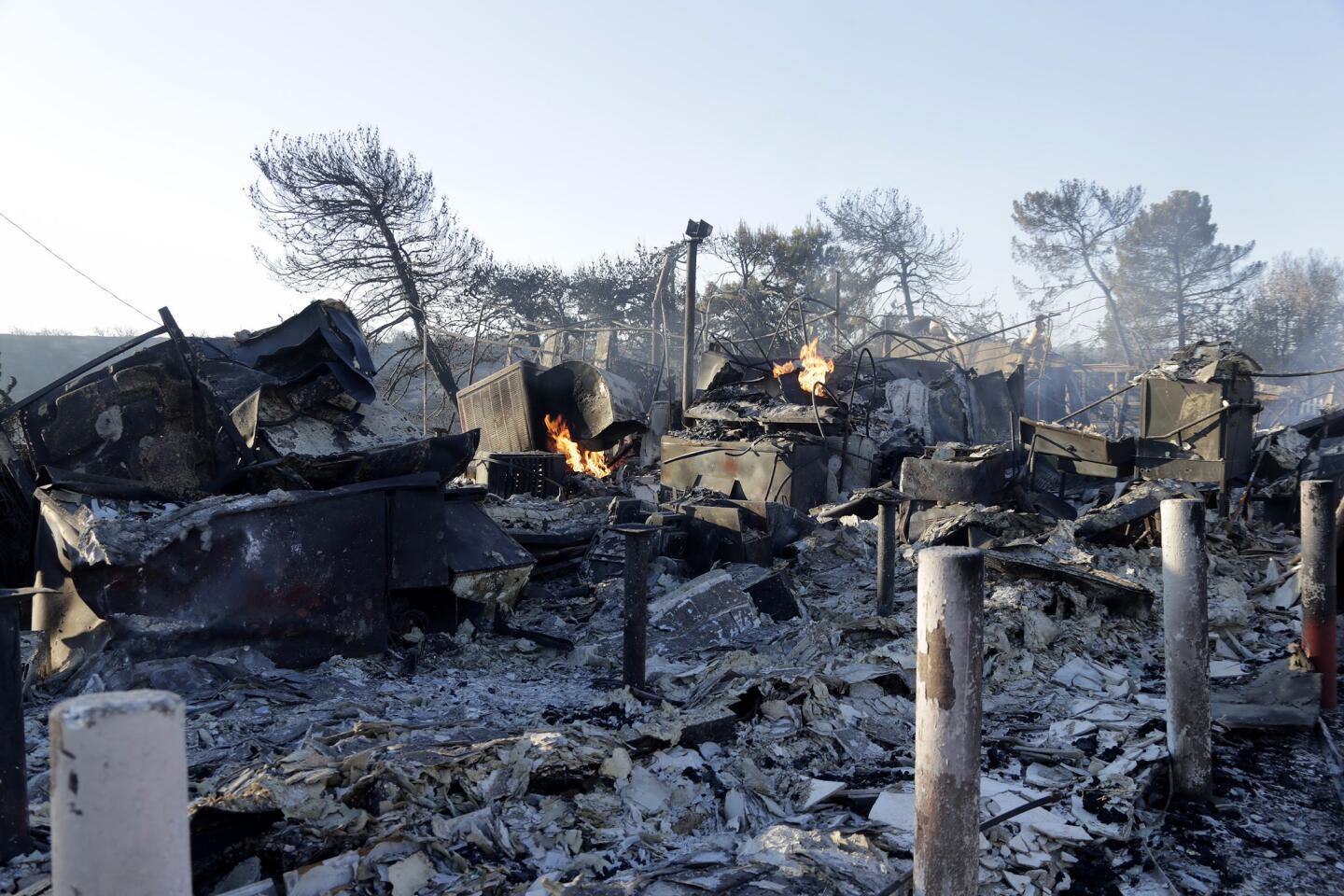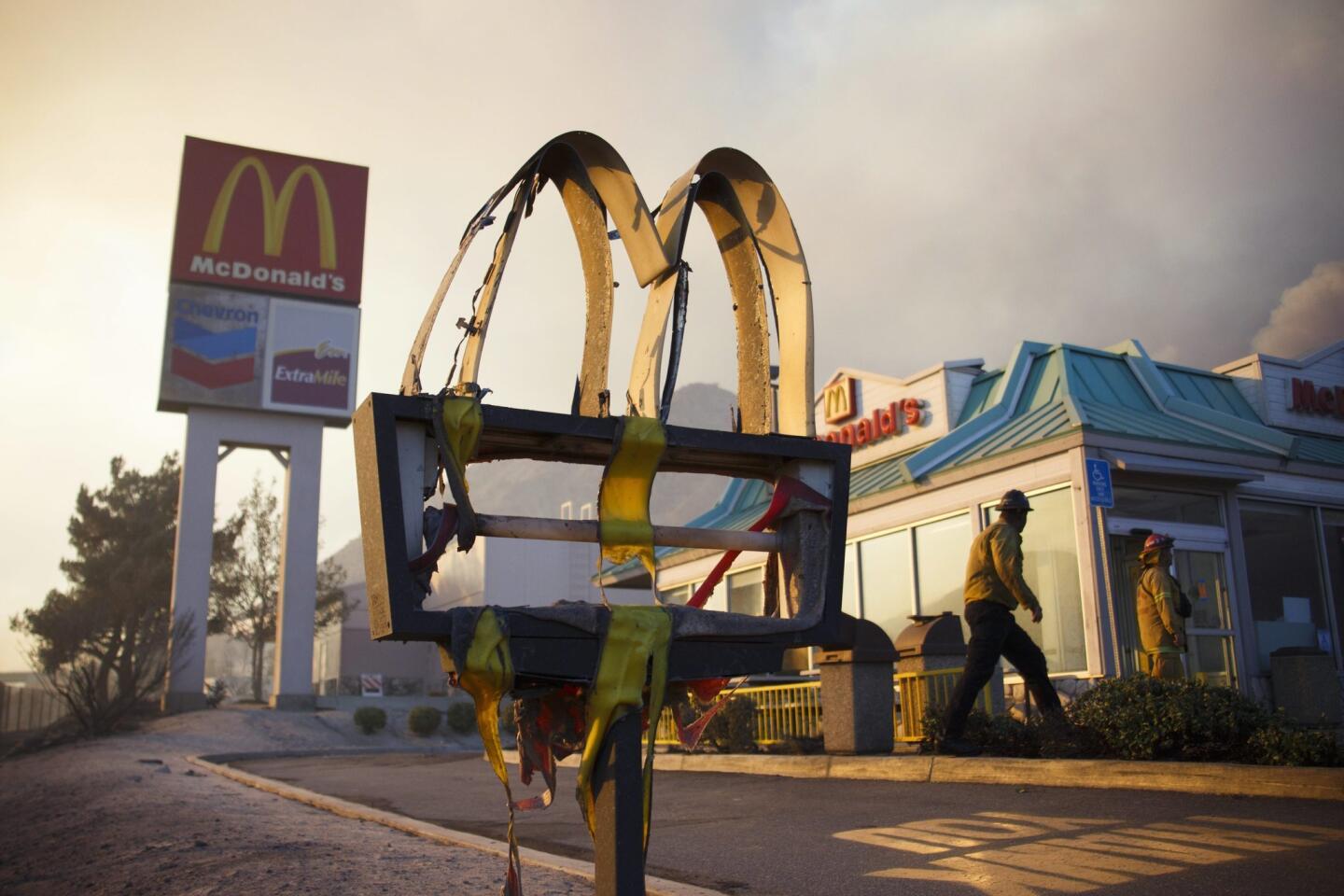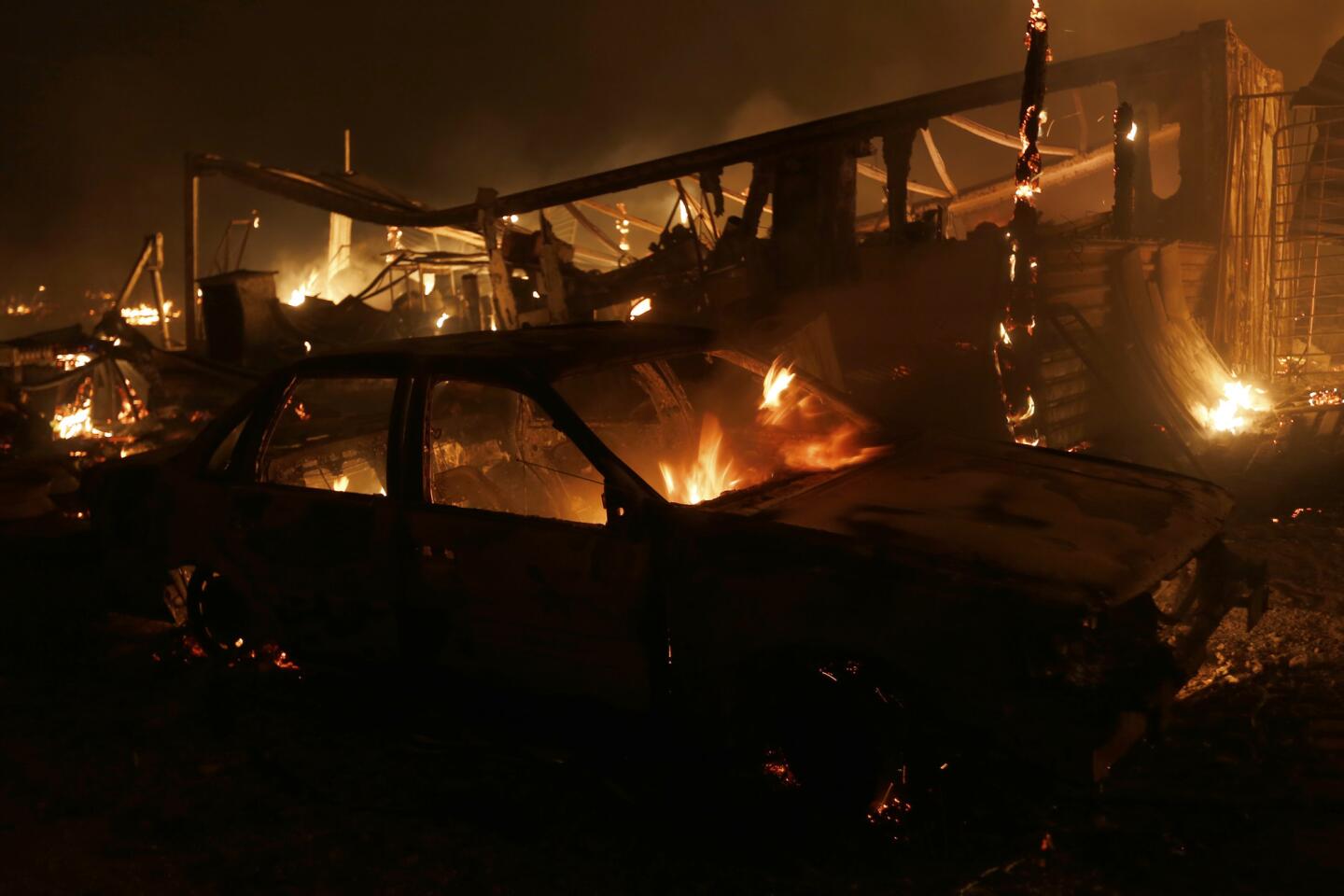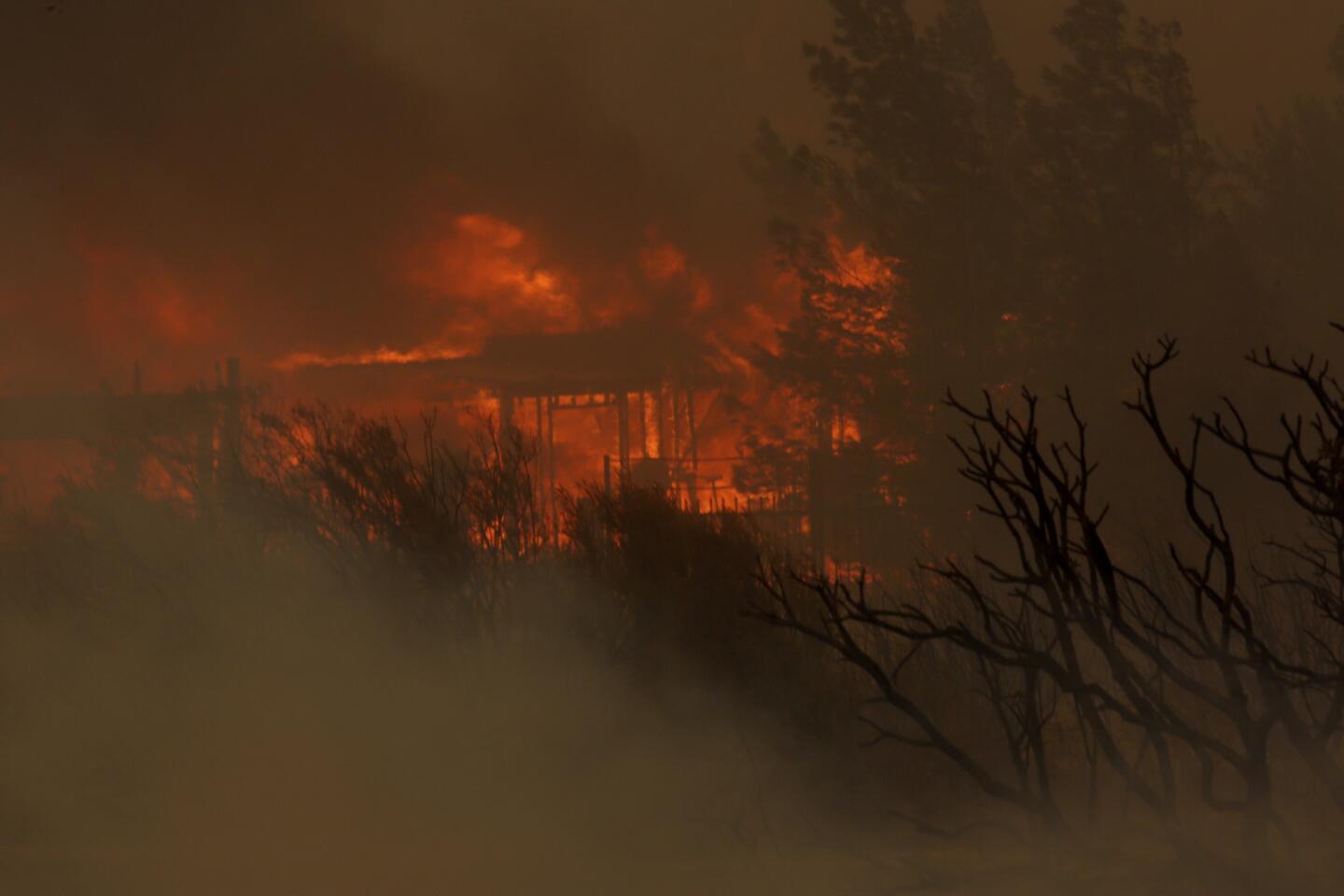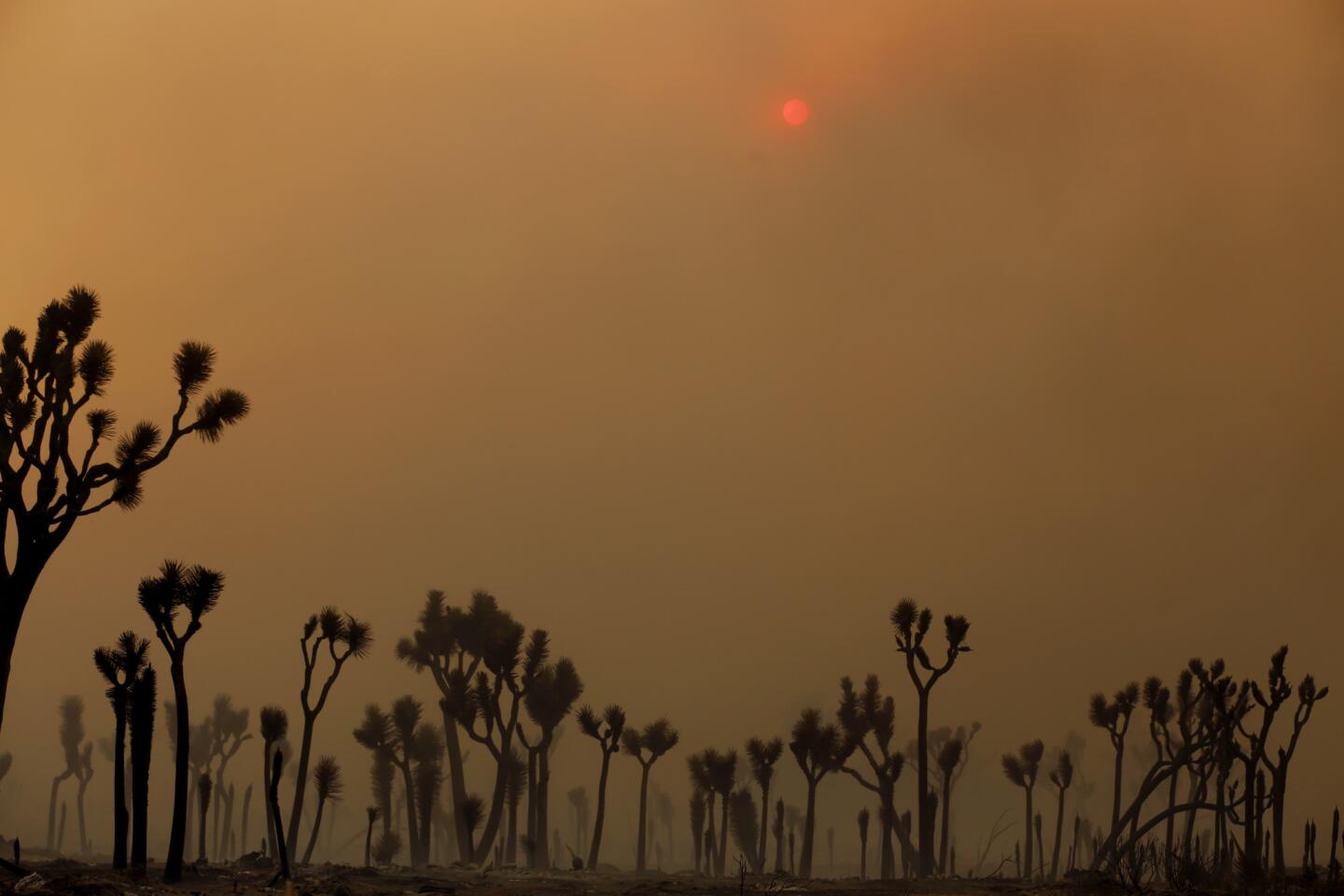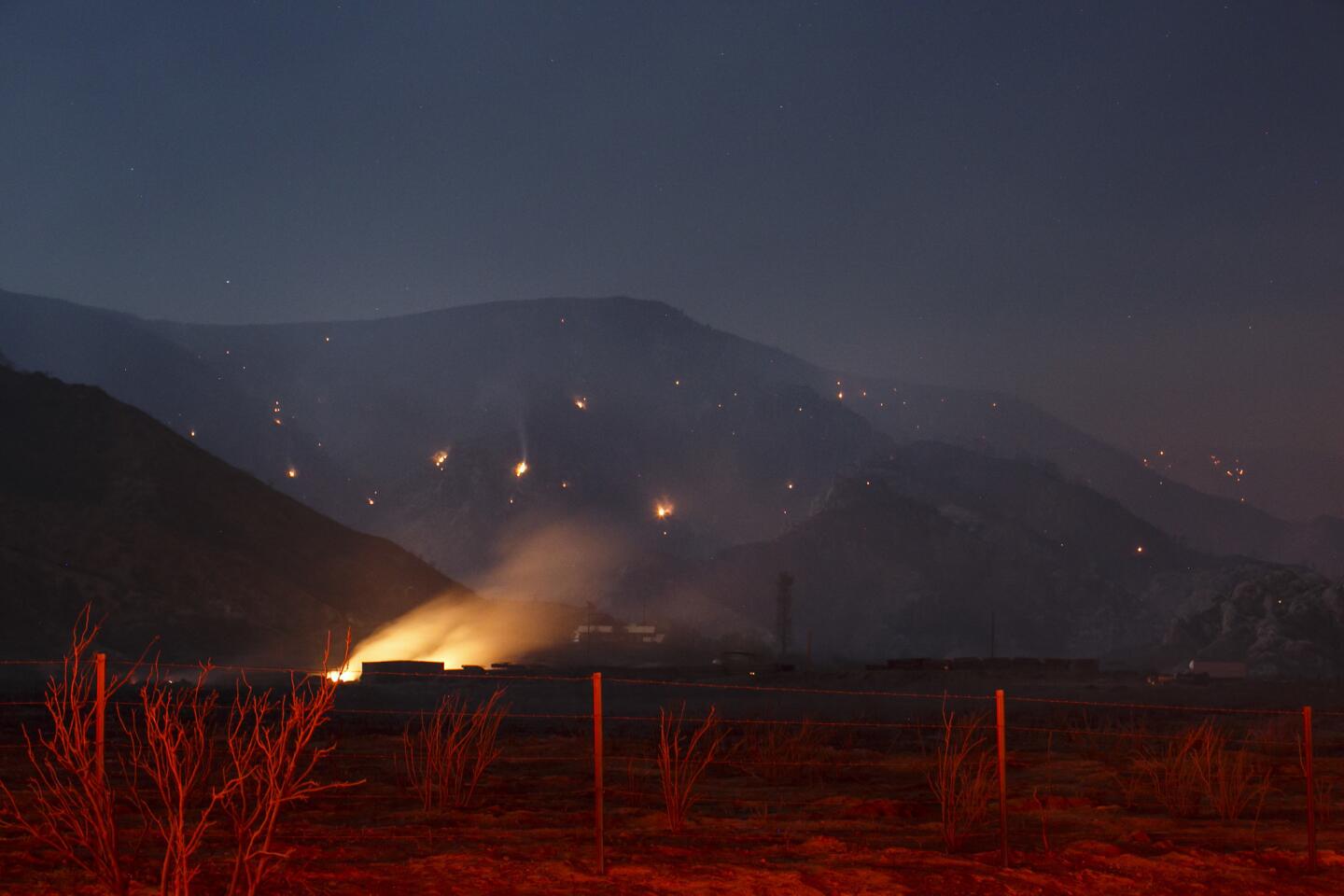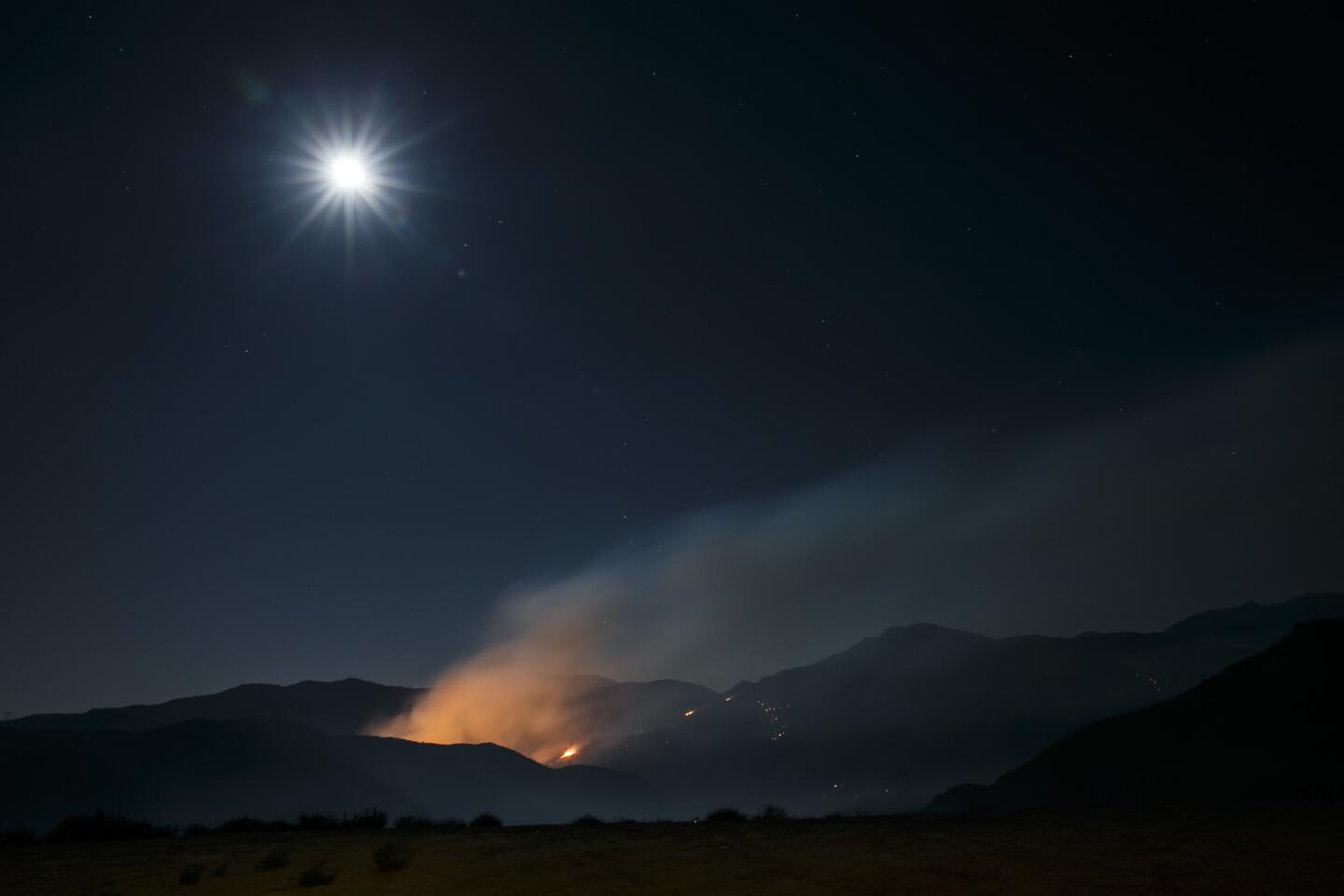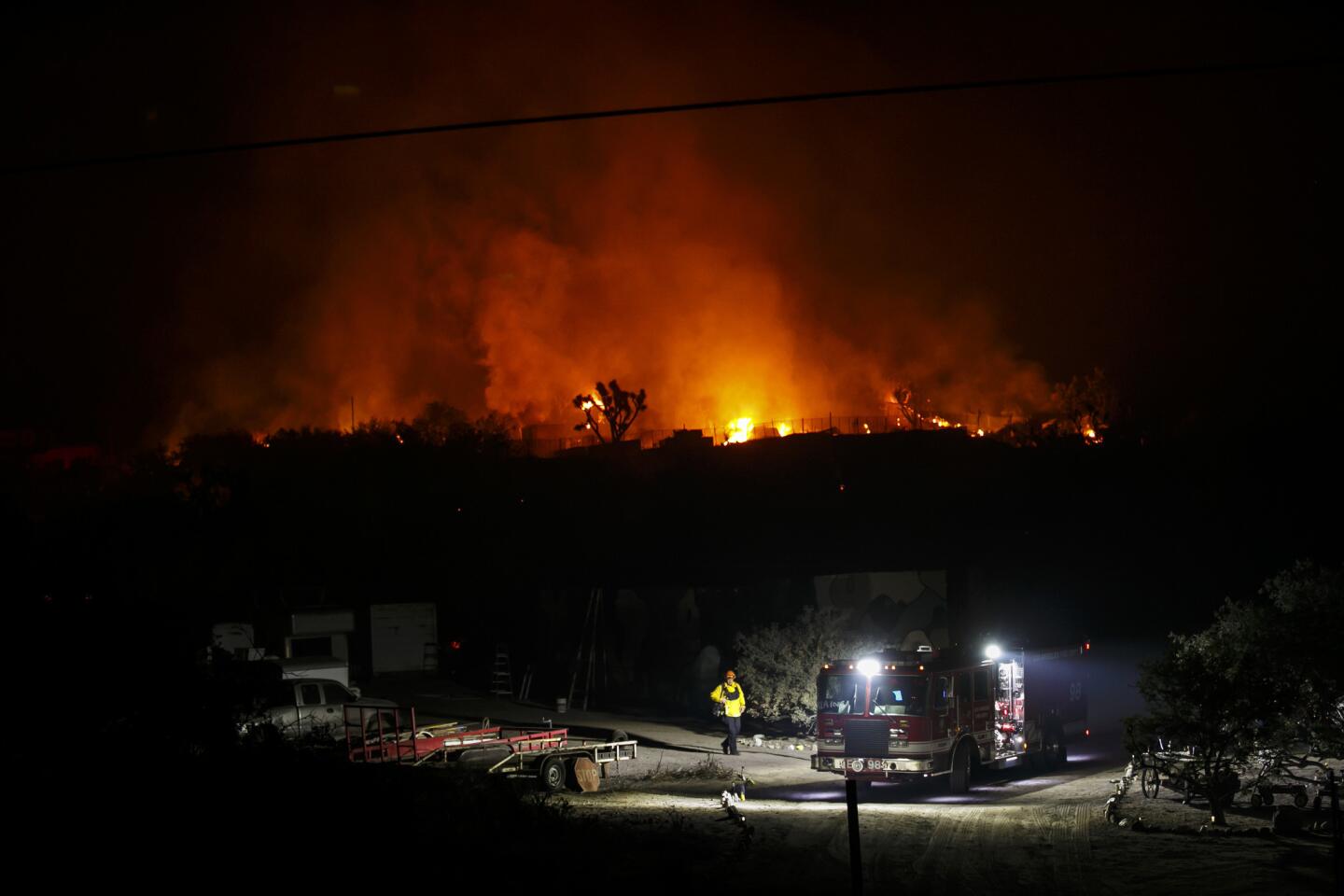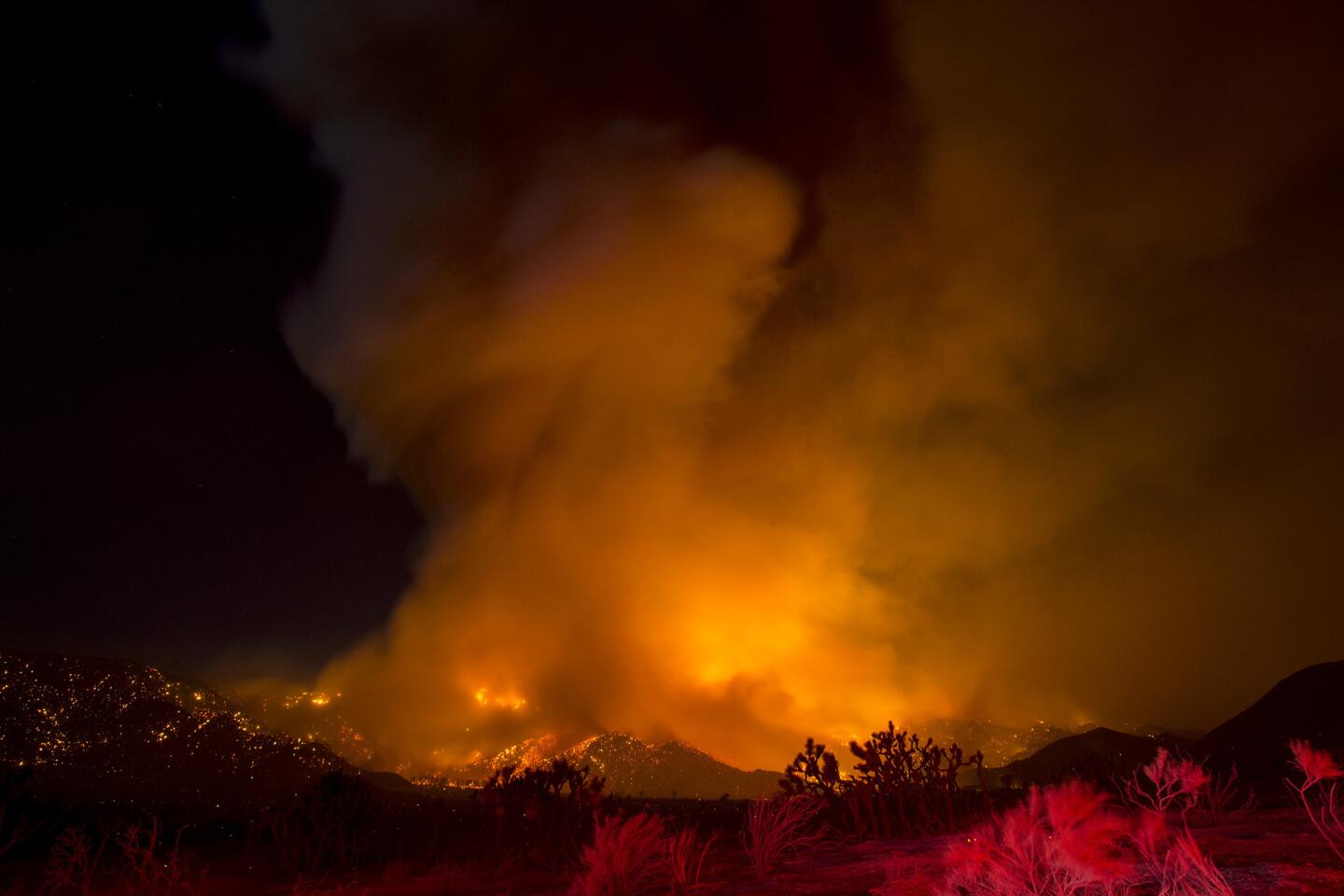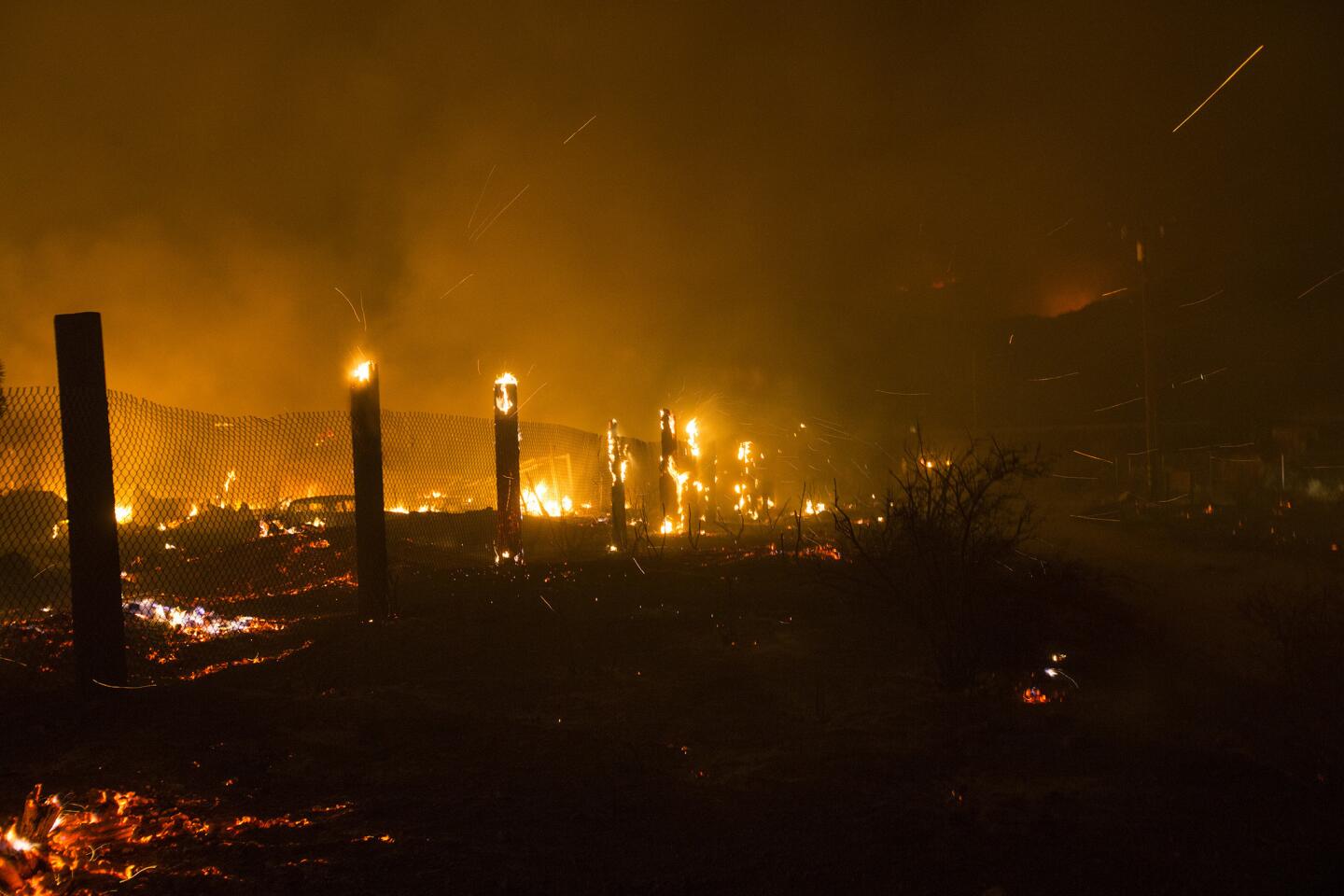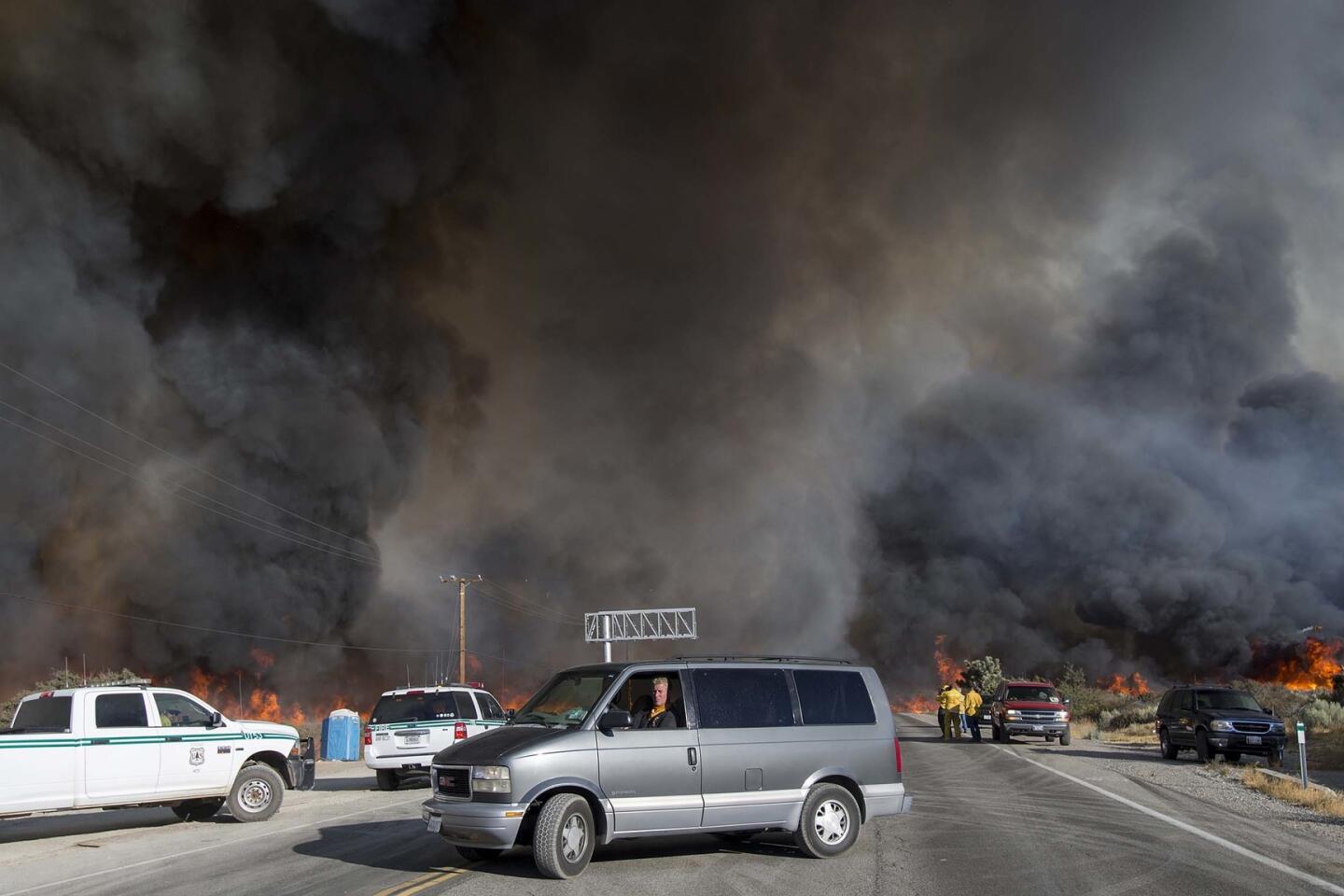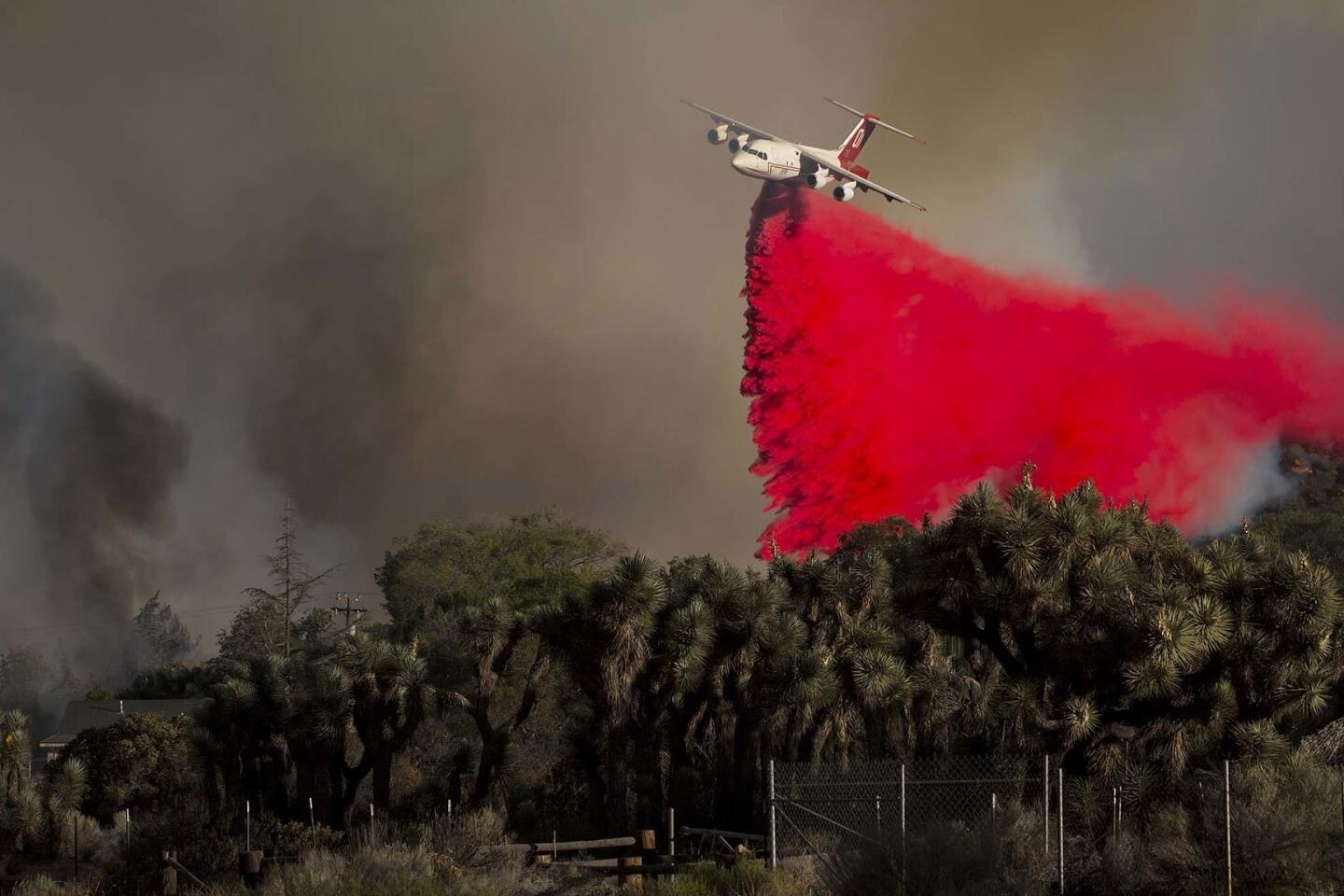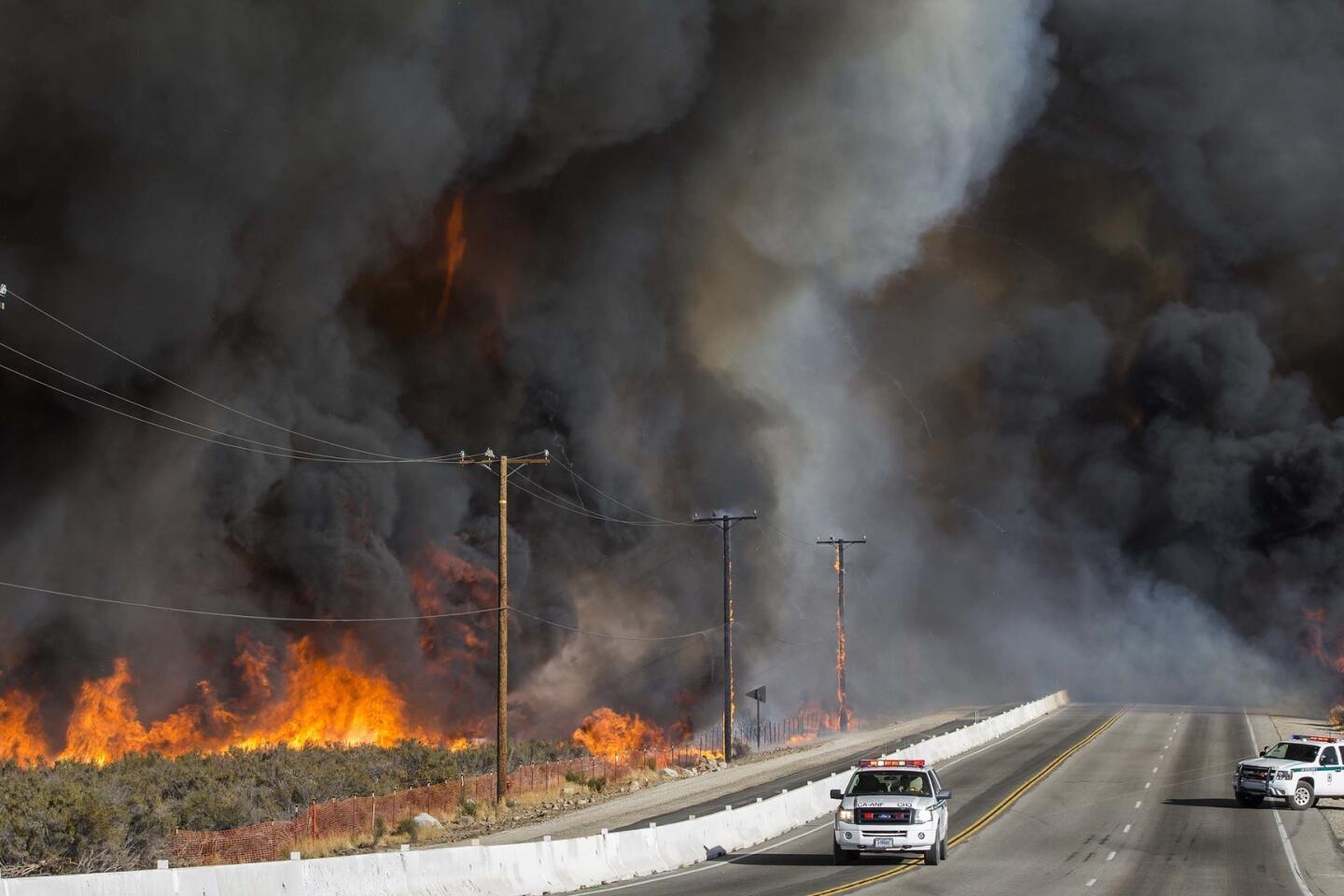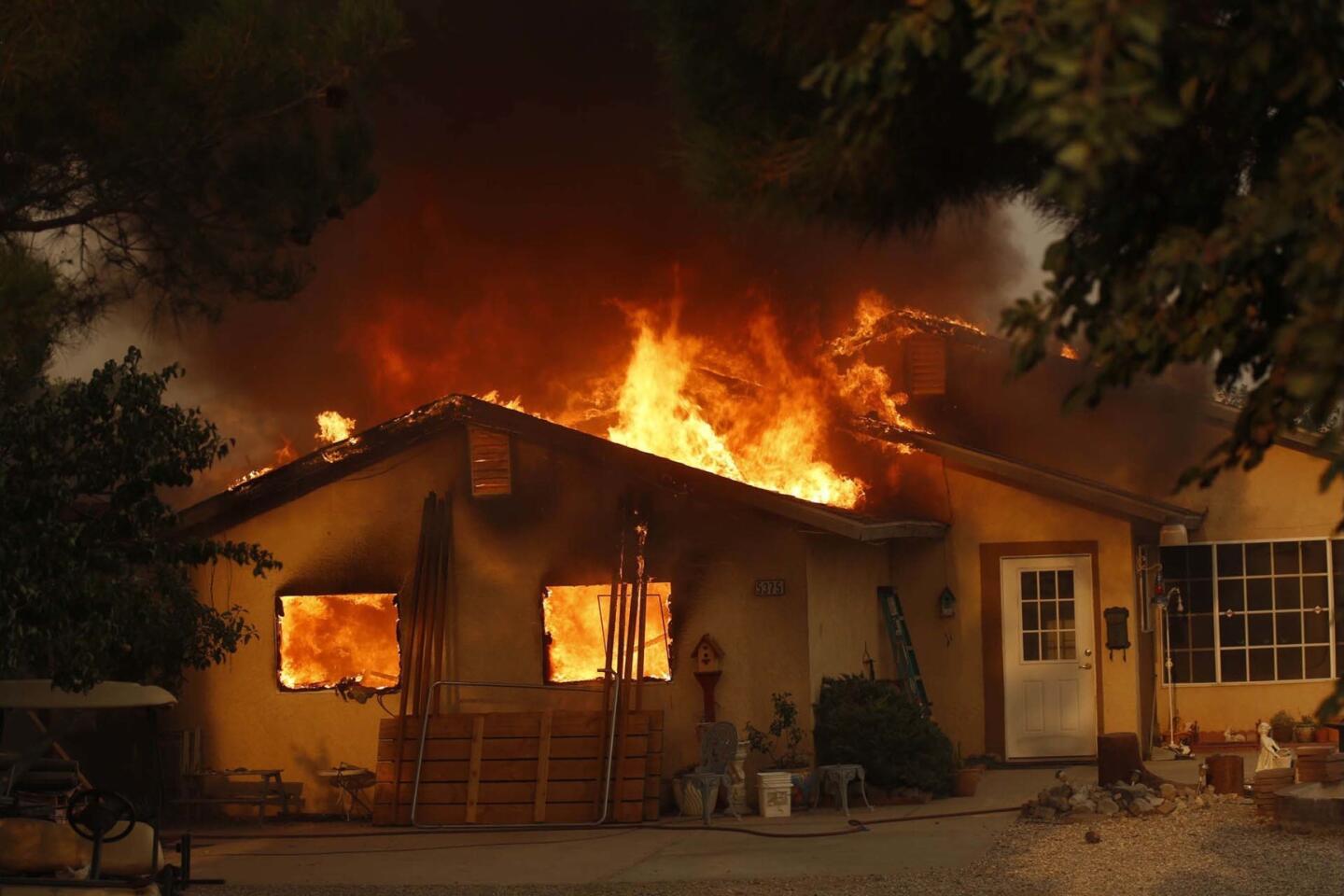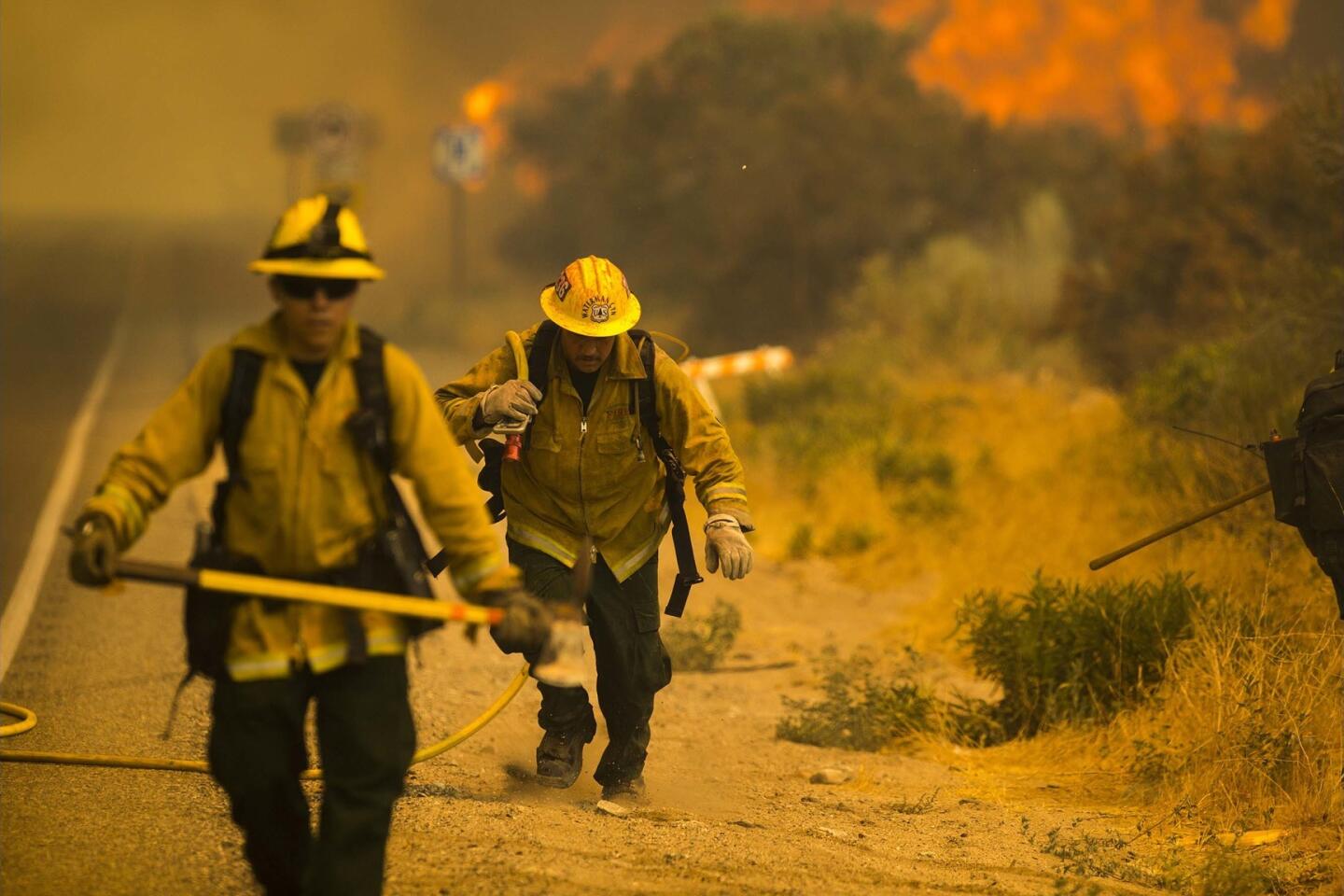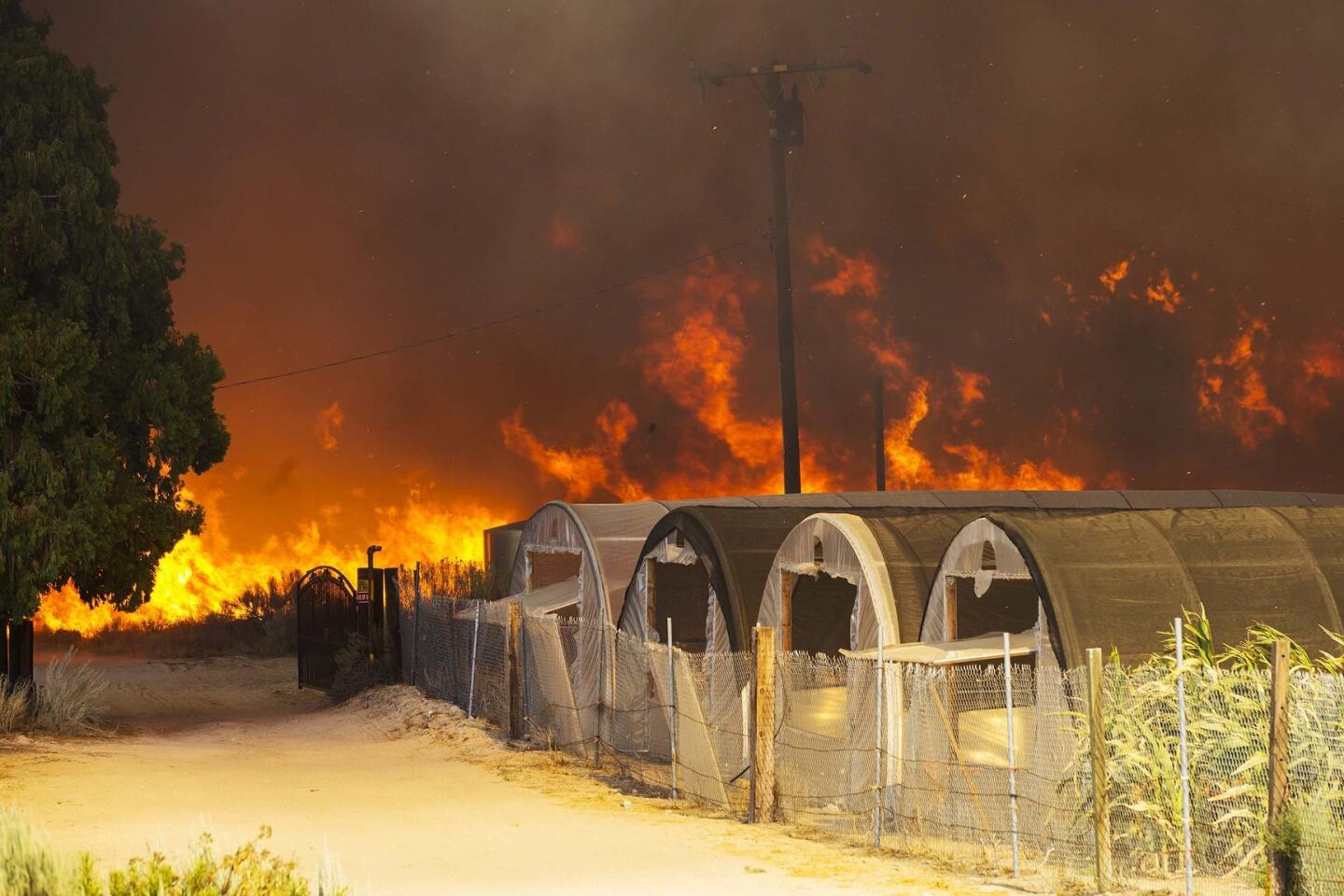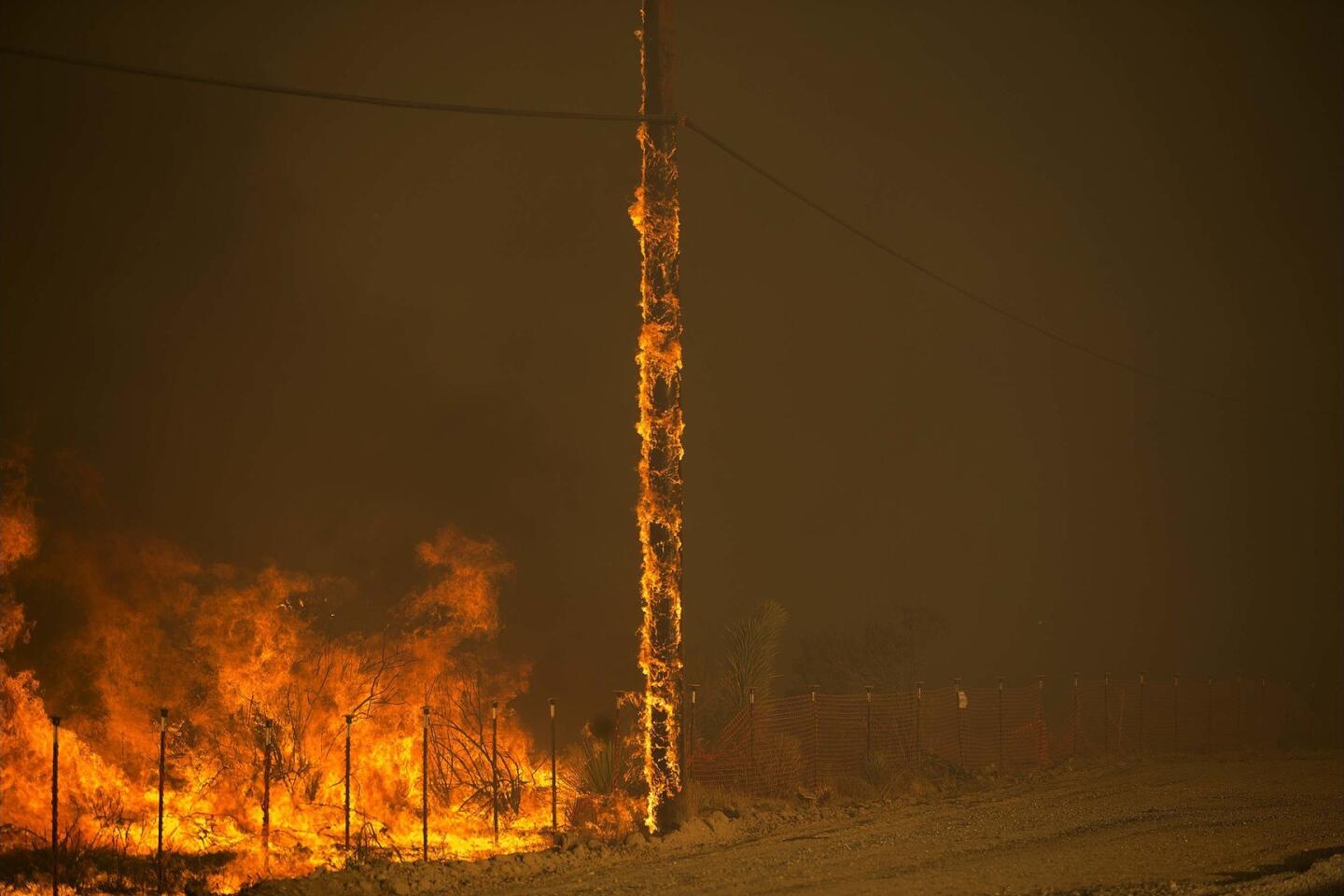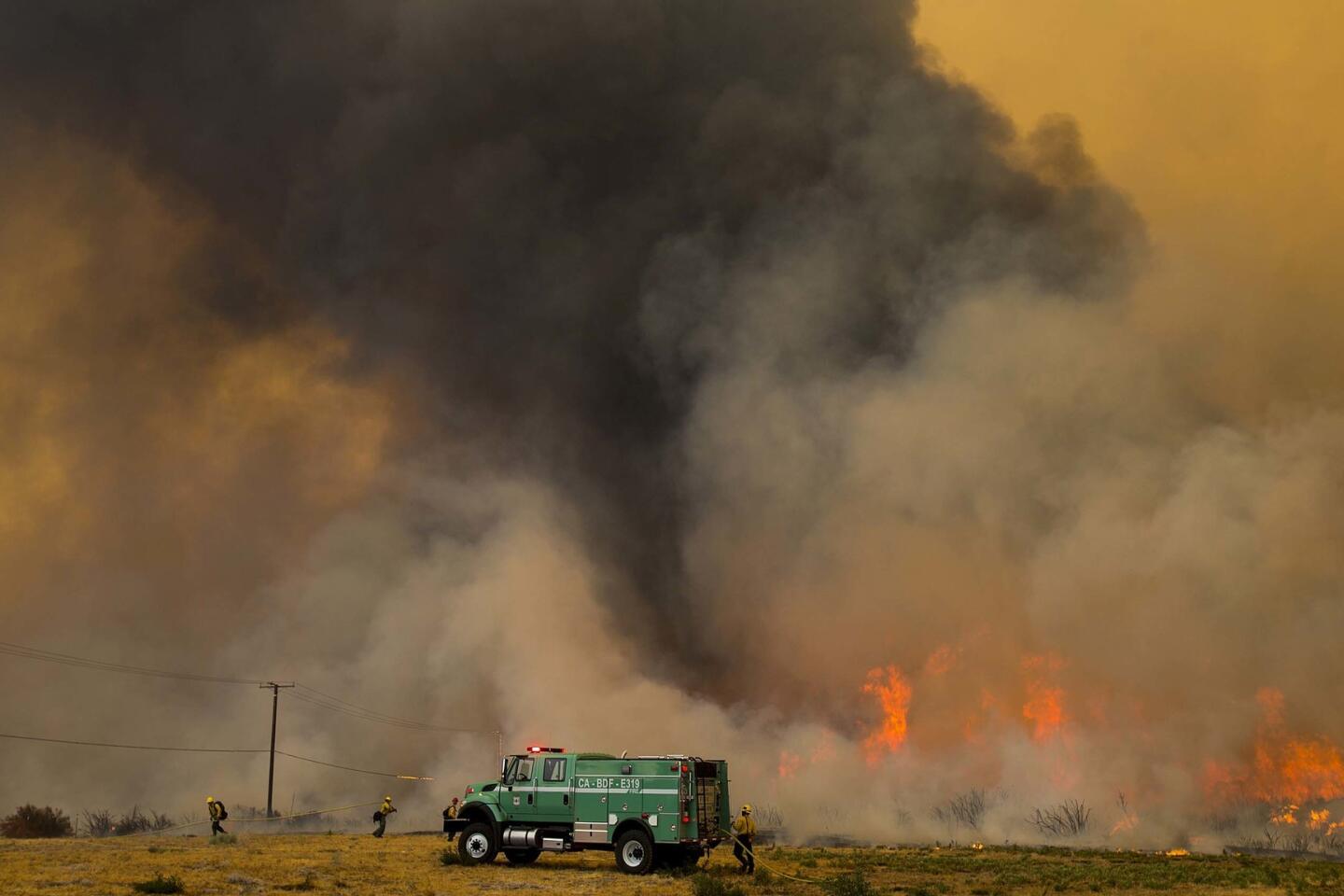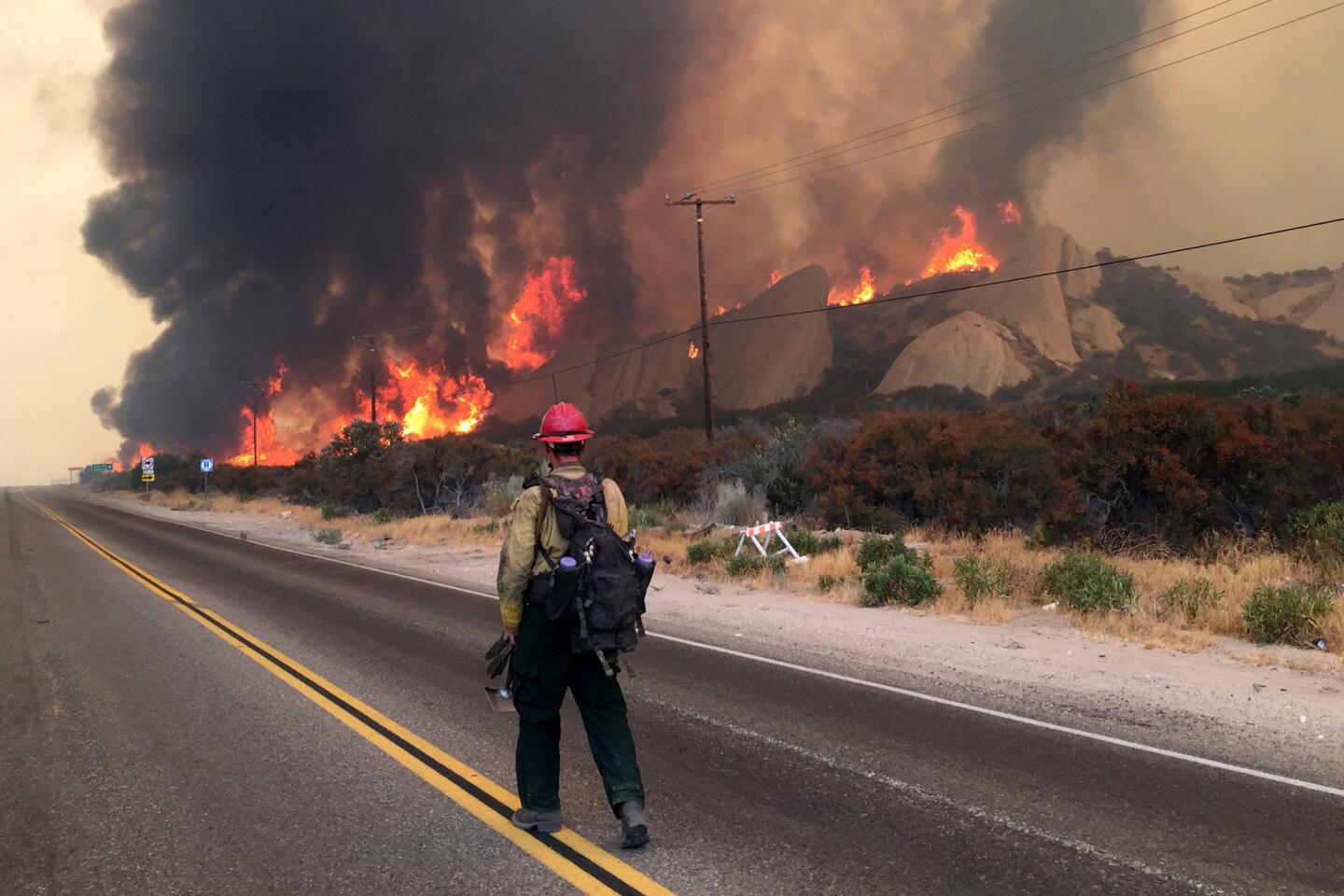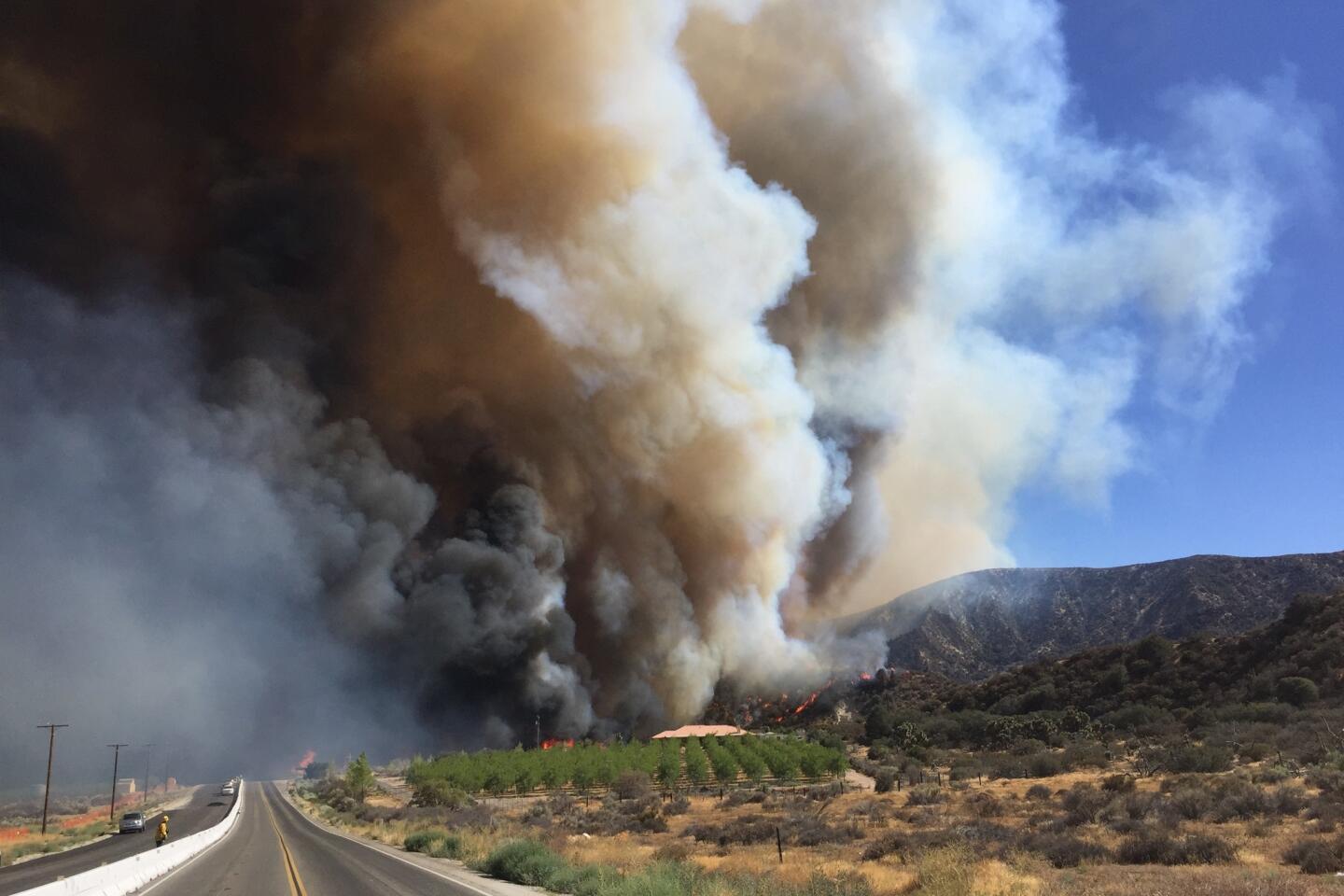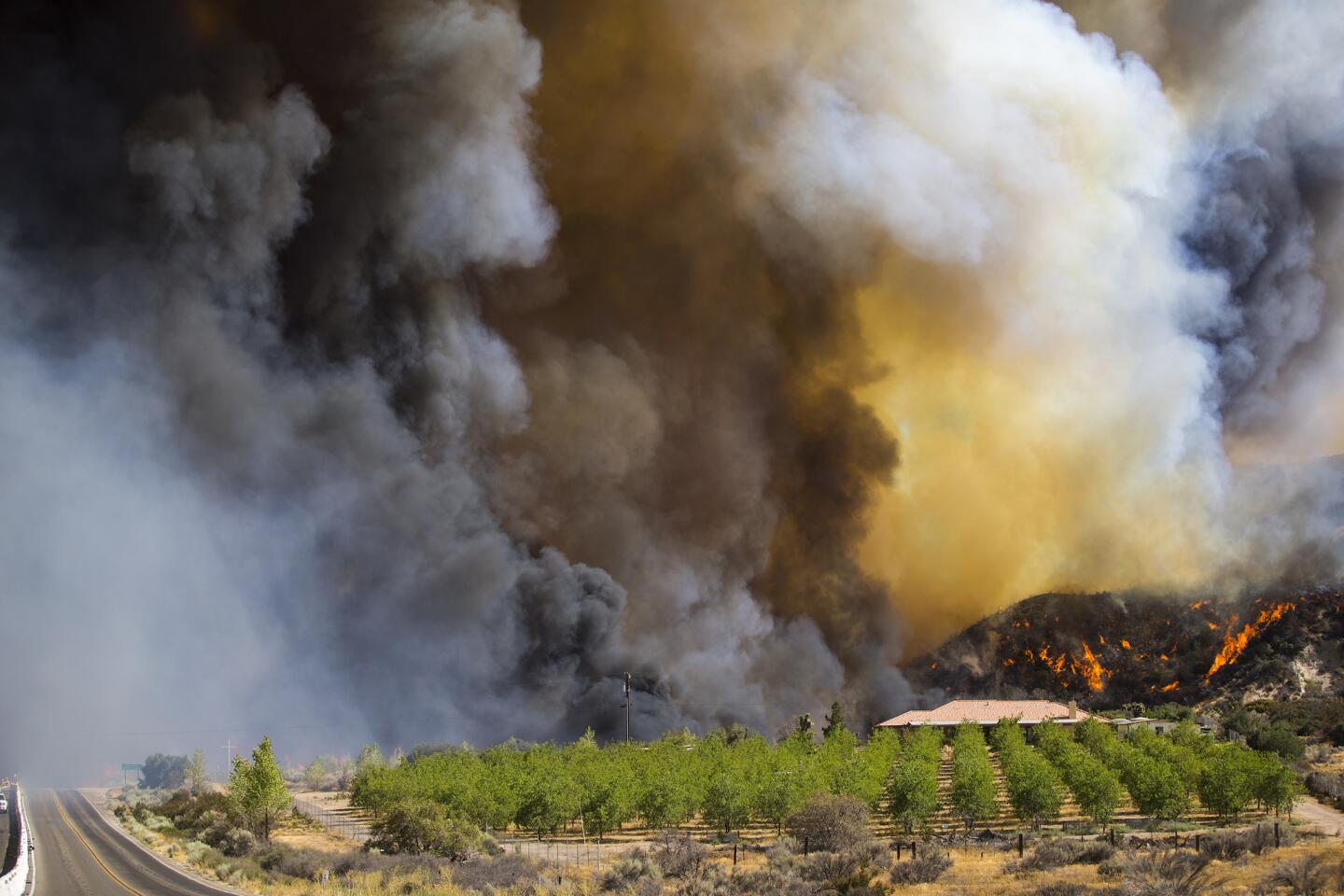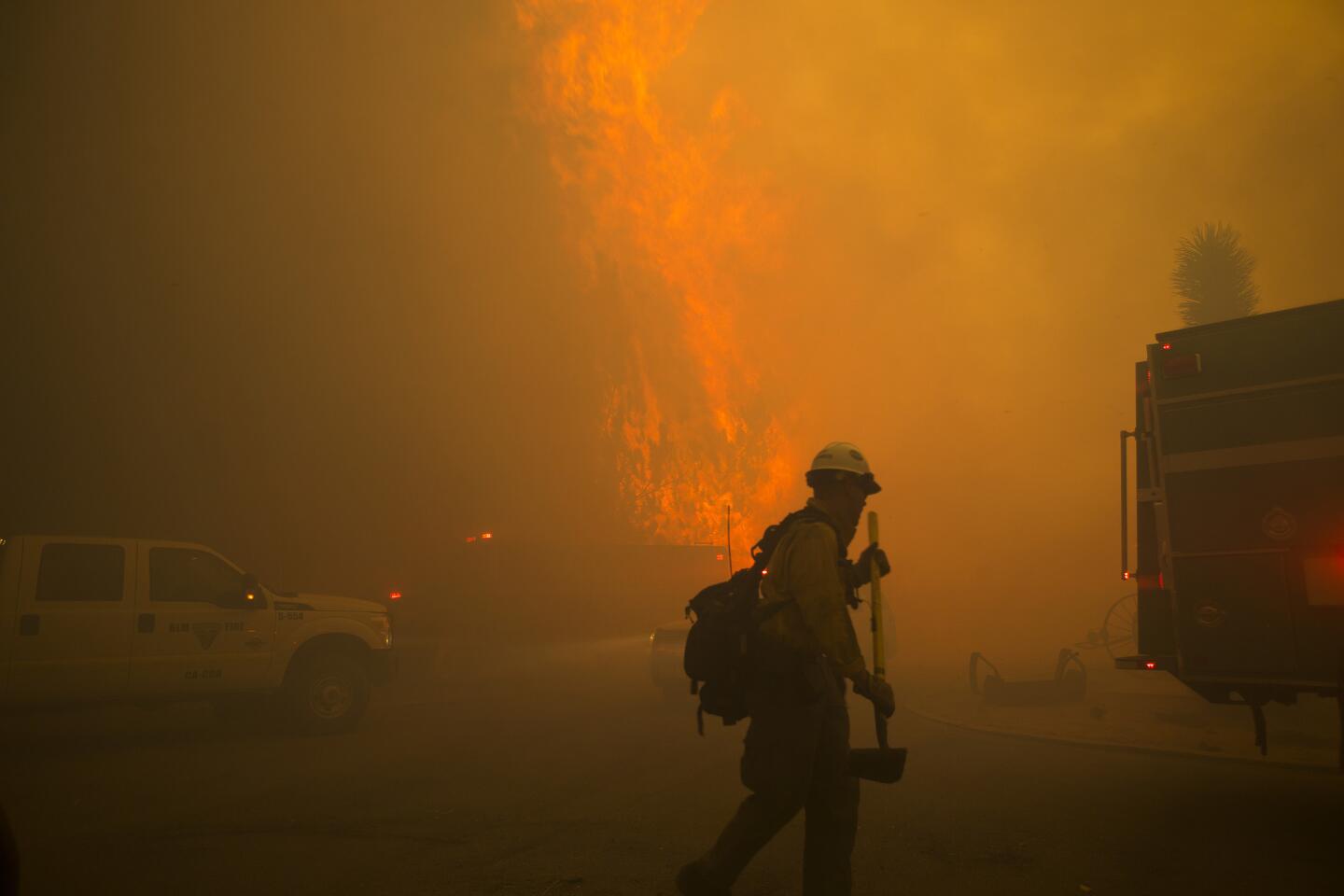Reporting from Lytle Creek — The aggressive fire in the Cajon Pass grew to 31,600 acres on Thursday as flames ripped through canyons and flatlands and reduced homes to ash and rubble.
Although crews made some progress against the blaze, which was 4% contained as of 6:30 a.m., a red flag warning is still in effect, meaning weather conditions are prime for a fast-moving, destructive wildfire.
The flames have left even veteran firefighters bewildered.
“It hit hard, it hit fast — it hit with an intensity that we haven’t seen before,” San Bernardino County Fire Chief Mark Hartwig said.
The menacing fire remained unruly Wednesday night, racing up Lone Pine Canyon and toward Highway 2, where the ski resort town of Wrightwood, population 4,525, was under threat.
Marc Peebles, a spokesman for the San Bernardino County Fire Department, likened the blaze’s activity Wednesday to an energetic child eluding his parents at the mall.
“It has been running all day,” he said.
With winds fanning the blaze, officials were concerned it could decimate Lytle Creek, a tiny mountain community along the wildfire’s southwestern flank that was under mandatory evacuation.
Structure-protection engines are stationed in Lytle Creek and Wrightwood. More than 1,500 firefighters were attacking the inferno “with everything they can from the air and the ground,” Lardner said.
More than 80,000 people in the county’s rural communities have been forced to flee. An unknown number of homes were destroyed.
The blaze’s small containment line was centered around Old Cajon, where the fire broke out Tuesday morning.
Officials are bracing for an immense tally of devastation from a fire fed by strong winds, parched tinder and triple-digit heat.
“There will be a lot of families that will come home to nothing,” Hartwig warned.
On Wednesday, the remote region was an ominous version of itself. Brilliant flames of red, gold and copper licked at skies choked with smoke. Multiple helicopters whirred in darkness as bulldozers razed paths below.
Summit Inn, a historic diner along Route 66 once frequented by Elvis Presley, had become indistinguishable rubble. Charred skeletons of buildings and cars dotted the area. A cargo train sat idle on tracks, abandoned by its engineer.
A spokesman for the U.S. Forest Service said assessment teams and cadaver dogs would be sent to homes and structures along Highway 138.
“The fire came so quickly,” said Chon Bribiescas. “We want to make sure nobody was left behind.”
It’s been 13 years since the area was struck by fire, leaving the hills and mountains a mix of dead brush and new growth.
The conditions on Tuesday were ripe for a fast-moving fire, officials said. The Cajon Pass, acting as a funnel, sent winds that raced up to 30 mph to help the blaze jump Interstate 15, said Michael Wakoski, battalion chief of the San Bernardino County Fire Department and incident commander of the Blue Cut fire.
Firefighters had difficulty navigating the steep slopes while the flames chewed through the rugged terrain, Wakoski said.
1/88
About 10 buildings belonging to the Thanksgiving Korean Church were reduced to rubble by the Blue Cut fire.
(Irfan Khan / Los Angeles Times) 2/88
Miguel and Mabel Ramos, both 73, survey the devastation of the Blue Cut fire after it swept through their Oak Hills residence.
(Irfan Khan / Los Angeles Times) 3/88
Mabel Ramos, 73, is overcome by emotion upon seeing the devastation caused by the Blue Cut fire, which swept through her Oak Hills residence.
(Irfan Khan / Los Angeles Times) 4/88
Miguel Ramos holds a single chicken that survived after the Blue Cut fire swept through his Oak Hills property, burning the guest house and killing about 135 animals.
(Irfan Khan / Los Angeles Times) 5/88
A CalFire helicopter makes a water drop on still smoldering remnants of Blue Cut Fire on the hilltop ridges along Hwy 2 in Wrightwood.
(Irfan Khan / Los Angeles Times) 6/88
The Blue Cut fire continues to burn north of Lytle Creek in San Bernardino County.
(Marcus Yam / Los Angeles Times) 7/88
Ground crews put out errant fires that popped up near the train tracks in Keenbrook in San Bernardino County.
(Marcus Yam / Los Angeles Times) 8/88
A firefighting helicopter makes water drops to keep errant fires from approaching the train tracks near Interstate 15 at Keenbrook in San Bernardino County.
(Marcus Yam / Los Angeles Times) 9/88
Fire burns on the train tracks near Interstate 15 at Keenbrook in San Bernardino County.
(Marcus Yam / Los Angeles Times) 10/88
A firefighting helicopter drops water on glames getting close to the train tracks near Interstate 15 at Keenbrook in San Bernardino County.
(Marcus Yam / Los Angeles Times) 11/88
An abandoned structure sits in the path of the Blue Cut fire after it has passed through Lone Pine Canyon in San Bernardino County.
(Marcus Yam / Los Angeles Times) 12/88
A firefighting helicopter makes a water drop on a flare-up of the Blue Cut fire along Interstate 15 in the Cajon Pass on Thursday.
(Luis Sinco / Los Angeles Times) 13/88
The Blue Cut fire burns in the mountains of the San Bernardino National Forest, leaving charred vegetation in its wake near Wrightwood on Thursday.
(Luis Sinco / Los Angeles Times) 14/88
A firefighting helicopter flies through thick smoke as it makes a water drop on a flare-up of the Blue Cut fire along Interstate 15 in the Cajon Pass.
(Luis Sinco / Los Angeles Times) 15/88
A dust cyclone swirls through a charred moonscape left by the Blue Cut fire near Wrightwood.
(Luis Sinco / Los Angeles Times) 16/88
Scott Steele of the Beverly Hills Fire Department comforts one of two dogs hurt in the Blue Cut fire next to a burned structure on Monte Vista Road in Phelan.
(Irfan Khan / Los Angeles Times) 17/88
Jaime Jungle, left, and Chris Schreiner from San Bernardino County Animal Control carry one of two dogs hurt by the Blue Cut fire at a burned-out structure on Monte Vista Road in Phelan.
(Irfan Khan / Los Angeles Times) 18/88
A light pole with plastic globes melted in the heat of the Blue Cut fire stands along Tamarind Avenue in Phelan.
(Irfan Khan / Los Angeles Times) 19/88
Fire crews are busy mopping up hot spots from the Blue Cut fire on Highway 2 on the way to Wrightwood.
(Irfan Khan / Los Angeles Times) 20/88
A helicopter makes a water drop in very dense smoke from Blue Cut Fire smoldering in the hills along Highway 2 near Wrightwood.
(Irfan Khan / Los Angeles Times) 21/88
Smoldering hillside from Blue Cut fire along Highway 2 near Wrightwood.
(Irfan Khan / Los Angeles Times) 22/88
Work crew prepare to repair downed power lines damaged by the Blue Cut fire on Highway 138 at the junction of 15 Freeway.
(Irfan Khan / Los Angeles Times) 23/88
The Blue Cut fire grew to more than 31,000 acres Thursday morning. (Marcus Yam / Los Angeles Times )
24/88
A car destroyed by the Blue Cut wildfire in Phelan, California.
(JONATHAN ALCORN / AFP/Getty Images) 25/88
A firefighter douses the Blue Cut fire burning alongside Lytle Creek Road on Wednesday night.
(Marcus Yam / Los Angeles Times) 26/88
Firefighters attack the Blue Cut fire as it burns along Lytle Creek Road on Wednesday night.
(Marcus Yam / Los Angeles Times) 27/88
Firefighters work to defend structures on Lytle Creek Road on Wednesday night. (Marcus Yam / Los Angeles Times)
28/88
A firefighter monitors the Blue Cut fire on the side of Lytle Creek Road on Wednesday night.
(Marcus Yam / Los Angeles Times) 29/88
A firefighter works to defend structures on Lytle Creek Road on Wednesday night.
(Marcus Yam / Los Angeles Times) 30/88
Firefighters set back fires on Lytle Creek Road on Wednesday night. (Marcus Yam / Los Angeles Times)
31/88
With a full moon in the background, firefighters monitor the Blue Cut fire along Lytle Creek Road on Wednesday night. (Marcus Yam / Los Angeles Times)
32/88
A firefighting helicopter drops water on a hillside to battle the Blue Cut fire west of Interstate 15 on Wednesday in Devore.
(Gina Ferazzi / Los Angeles Times) 33/88
Smoke from the Blue Cut fire burns over Interstate 15 on Wednesday in Devore.
(Gina Ferazzi / Los Angeles Times) 34/88
Firefighters work to extinguish flames on Cajon Blvd along the interstate 15, in San Bernardino County on Aug. 17.
(Marcus Yam / Los Angeles Times) 35/88
A firefighter battles the Blue Cut fire in thick brush along Lytle Creek Road.
(Luis Sinco / Los Angeles Times) 36/88
CalFire firefighters keep watch on the Blue Cut fire as it roars on a hillside above Sheep Canyon Road on Wednesday in Lytle Creek. (Gina Ferazzi / Los Angeles Times)
37/88
A sky crane drops water on the Blue Cut Fire to keep it from crossing Lytle Creek Road on Wednesday in Lytle Creek. (Gina Ferazzi / Los Angeles Times)
38/88
Lytle Creek residents check-in at the evacuation center set up at the Jessie Turner Health & Fitness Center on Wednesday in Fontana. (Gina Ferazzi / Los Angeles Times)
39/88
The Blue Cut fire burns close to Wrightwood. (Irfan Khan / Los Angeles Times)
40/88
Firefighters work around the Blue Cut fire near Wrightwood. (Irfan Khan / Los Angeles Times)
41/88
The Blue Cut fire burns a hillside near Wrightwood. (Irfan Khan / Los Angeles Times)
42/88
Firefighting helicopters battle the Blue Cut fire as it burns out of control around the community of Lytle Creek.
(Luis Sinco / Los Angeles Times) 43/88
Lytle Creek residents Nico and Dalia Santucci prepare to evacuate as the Blue Cut fire burns near their home.
(Luis Sinco / Los Angeles Times) 44/88
A firefighting helicopter drops water on the Blue Cut fire as it burns above Lytle Creek on Wednesday.
(Luis Sinco / Los Angeles Times) 45/88
Air tanker drops fire retardant near residences threatened by Blue Cut Fire along Highway 2 Wednesday afternoon.
(Irfan Khan / Los Angeles Times) 46/88
A structure is engulfed in flames as the Blue Cut fire burns out of control in Lytle Creek.
(Luis Sinco / Los Angeles Times) 47/88
A firefighting airplane drops fire retardant on the Blue Cut fire in the foothills of the San Bernardino National Forest.
(Luis Sinco / Los Angeles Times) 48/88
Towering flames of the Blue Cut fire burn out of control in the foothills of the San Bernardino National Forest above Lytle Creek.
(Luis Sinco / Los Angeles Times) 49/88
A firefighting helicopter drops water on bruning brush as the Blue Cut fire burns out of control in the foothills of the San Bernardino National Forest on Wednesday.
(Luis Sinco / Los Angeles Times) 50/88
The Blue Cut fire exploded out of control Tuesday in the Cajon Pass, scorching 30,000 acres and destroying an unknown number of homes in several rural San Bernardino County communities.
(Irfan Khan / Los Angeles Times) 51/88
David Pearson, who lives on Lone Pine Canyon Road, decided to stay at home in Wrightwood as long as conditions allowed.
(Irfan Khan / Los Angeles Times) 52/88
Firefighter Bryan Hagan and Pegi Fall, standing along Lone Pine Canyon Road, watch as the Blue Cut fire approaches Wrightwood. Fall has decided to stay as long as conditions allow.
(Irfan Khan / Los Angeles Times) 53/88
The Blue Cut fire exploded out of control Tuesday in the Cajon Pass, scorching 30,000 acres and forcing over 80,000 to evacuate.
(Irfan Khan / Los Angeles Times) 54/88
A cat wandering around jumps way from hot surface and flames emitting at still smoldering structure at Hess Road.
(Irfan Khan / Los Angeles Times) 55/88
Destruction brought by Blue Cut fire on Hess Road in Phelan.
(Irfan Khan / Los Angeles Times) 56/88
Smoke rises out from underneath railroad tracks at a damaged bridge near the Interstate 15 damaged by the Blue Cut fire burning in San Bernardino County.
(Marcus Yam / Los Angeles Times) 57/88
Michelle Keeney and her husband, Scott, salvage some old signs from gutted Summit Inn Wednesday morning. Michelle Keeney is the manager of the restaurant destroyed in the fire.
(Irfan Khan / Los Angeles Times) 58/88
Spot fire continue to burn in what remains of the gutted Summit Inn at the junction of the 15 Freeway and Highway 138 Wednesday morning.
(Irfan Khan / Los Angeles Times) 59/88
A melted sign from a McDonald’s restaurant shows the damage as firefighters check the area after the Blue Cut fire swept through Cajon Junction.
(EUGENE GARCIA / EPA) 60/88
Burned homes and vehicles are left in the wake of the Blue Cut Fire that broke out in Devore near the Cajon Pass on Aug. 16, 2016.
(Francine Orr / Los Angeles Times) 61/88
Burned homes and vehicles are left in the wake of the Blue Cut fire that broke out in Devore near the Cajon Pass on Aug. 16, 2016.
(Francine Orr / Los Angeles Times) 62/88
Smoke from the Blue Cut fire that broke out in Devore near the Cajon Pass and quickly spread on Aug. 16, 2016.
(Francine Orr / Los Angeles Times) 63/88
Fire continues to burn along Highway 138, in San Bernardino County.
(Marcus Yam / Los Angeles Times) 64/88
During the night, a portion of the Blue Cut fire burns along Interstate 15.
(Marcus Yam / Los Angeles Times) 65/88
A firefighter returns to his vehicle as fire continue to burn along Highway 138 in San Bernardino County.
(Marcus Yam / Los Angeles Times) 66/88
The Blue Cut fire still burns out of control into the evening off Highway 138 in Summit Valley, Calif.
(Gina Ferazzi / Los Angeles Times) 67/88
Winds blow hot embers along a burning fence line as the Blue Cut fire torches the landscape into the evening off Highway 138 in Summit Valley.
(Gina Ferazzi / Los Angeles Times) 68/88
Motorists flee The Blue Cut fire as it burns out of control on both sides of Highway 138 in Summit Valley.
(Gina Ferazzi / Los Angeles Times) 69/88
Residents watch in despair as the Blue Cut fire burns homes on the hillside off Highway 138 in Summit Valley, California.
(Gina Ferazzi / Los Angeles Times) 70/88
An air tanker drops fire retardant near homes as the Blue Cut fire burns out of control on both sides of Highway 138 in Summit Valley, California.
(Gina Ferazzi / Los Angeles Times) 71/88
A home is engulfed in flames as the Blue Cut fire burns out of control on both sides of Highway 138 in Summit Valley, California.
(Gina Ferazzi / Los Angeles Times) 72/88
San Bernadino County firefighter David Pingree works to save a home near Hwy 138.
(Francine Orr / Los Angeles Times) 73/88
The Blue Cut fire burns out of control on both sides of Highway 138 in Summit Valley, California.
(Gina Ferazzi / Los Angeles Times) 74/88
A home located at 5375 Hwy 138 in Phelan is consumed by the Blue Cut fire as it rages out of control August 16, 2016.
(Francine Orr / Los Angeles Times) 75/88
Fire crews head back to their truck after a failed attempt to stop the Blue Cut Fire spreading along Highway 138 in Phelan, California.
(Gina Ferazzi / Los Angeles Times) 76/88
The Blue Cut Fire roars out of control behind greenhouses along Highway 138 in Phelan, California.
(Gina Ferazzi / Los Angeles Times) 77/88
A firefighter watches as the Blue Cut Fire roars near Highway 138 as it burns vegetation and power poles in Phelan, Calif. (Gina Ferazzi / Los Angeles Times )
78/88
Fire crews attempts but can not stop the Blue Cut fire as it spreads along Highway 138 in Phelan, California.
(Gina Ferazzi / Los Angeles Times) 79/88
A firefighter reports that the Blue Cut fire is burning on both sides of Highway 138 in Phelan, Calif. (Gina Ferazzi / Los Angeles Times )
80/88
A power pole burns as the Blue Cut fire burns out of control on both sides of Highway 138 in Summit Valley, California.
(Gina Ferazzi / Los Angeles Times) 81/88
A house is surrounded by flames as the Blue Cut Fire roars above Highway 138 in Phelan, Calif., on Tuesday.
(Gina Ferazzi / Los Angeles Times) 82/88
A firestorm approaches as a fire crew begins to pull out at Mormon Rocks Station in the San Bernardino National Forest off Highway 138.
(Gina Ferazzi / Los Angeles Times) 83/88
A firefighter on Tuesday monitors the Blue Cut fire along Highway 138, near the Cajon Pass.
(Gina Ferazzi / Los Angeles Times) 84/88
The Blue Cut fire engulfs the Mormon Rocks Fire Station in the San Bernardino National Forest off Highway 138 in Phelan, Calif., on Tuesday.
(Gina Ferazzi / Los Angeles Times) 85/88
The Blue Cut fire burns along California Highway 138 on Tuesday.
(Gina Ferazzi / Los Angeles Times) 86/88
The Blue Cut Fire roars out of control as it heads towards home off Highway 138.
(Gina Ferazzi / Los Angeles Times) 87/88
The Blue Cut fire throws up a large plume of smoke shortly after it broke out late Tuesday morning.
(Gina Ferazzi / Los Angeles Times) 88/88
The Blue Cut fire engulfs the Mormon Rocks area off Highway 138 in Phelan, Calif., on Tuesday.
(Gina Ferazzi / Los Angeles Times) Six county firefighters were trapped Tuesday by walls of flame while defending homes and evacuating residents in Swarthout Canyon, officials said. They were treated for minor injuries and have returned to the field, officials said.
No other injuries have been reported.
In addition to Lytle Creek, Lone Pine Canyon, Wrightwood and Swarthout Canyon, mandatory evacuations were ordered for Baldy Mesa, Old Cajon Road and West Cajon Valley, fire officials said.
The northbound lanes of the 15 Freeway through the Cajon Pass reopened late Wednesday, according to the California Highway Patrol.
The freeway, a key trucking and commuter route that connects Southern California with Nevada, was closed after the Blue Cut fire erupted. Clogged traffic and major road closures had made it difficult for residents to leave the area.
Mary Grass, 74, and her husband left their Phelan home Tuesday as smoke and flames tore through the area. After dropping their horse off at a friend’s house in Hesperia, they headed to Victorville to spend the night.
They have already seen television footage of neighbors’ residences destroyed.
“Just wondering about our house now,” Grass said.
Others couldn’t bear to leave.
“I stayed just in case there’s a chance that I can do something to save my house,” said Joe Knowlton, who watched the flames from his porch in Wrightwood.
Knowlton, 49, said he watered his property and was standing guard with his 14-year-old son. If an ember fell nearby, at least he’d be around to stamp it out, he said.
“That’s the difference between the house going up in flames or not,” he said. “I don’t mind sticking it out.”
This year alone, California has been besieged by wildfires that have scorched hundreds of homes and killed eight people — all before autumn, when the state’s traditional fire season begins and the Santa Ana winds come into play.
The onslaught of fires has taxed fire departments and left little time for rest. Some firefighters were working up to 36 hours straight, said Peebles, the San Bernardino County Fire Department spokesman.
“These guys are going from fire to fire,” he added.
Such fires are a sort of “new normal,” said Char Miller, an expert on wildfires and national forests at Pomona College.
“We’re in the fifth year of drought and we’re starting to see the consequences of that,” he said.
Aerial fights against intense blazes can only do so much, Miller said. “You need boots on the ground.”
That’s a tall order as firefighters face temperatures that aren’t likely to cool until Friday, said Philip Gonsalves, a meteorologist with the National Weather Service in San Diego.
Crews won’t be able to rely on any nighttime humidity to recover either, he said.
The dozens of residents who made their way to Sultana High School in Hesperia found themselves fearing the worst and taking stock of the best.
“You can’t worry about your things,” said Anthony Botello, 48, who left his home with just a handful of clothes and his wedding band. “It’s your life that you have to value.”
Nearby, Osuna Rosa sipped coffee on a cot and retraced the past day’s events.
The 53-year-old hospice nurse was at work in the High Desert on Tuesday morning when she noticed smoke.
The southbound Interstate 15 was closed. She tried an alternate route along Summit Valley Road, but found it clogged with traffic.
After Rosa failed to get a hotel room, she found herself in tears.
Then, a motel employee pointed her to the shelter. In the dimly lighted gymnasium, she managed to get a few hours of sleep, still dressed in her blue hospital scrubs.
paloma.esquivel@latimes.com
angel.jennings@latimes.com
shane.newell@latimes.com
Esquivel reported from Lytle Creek; Jennings from San Bernardino; Newell from Hesperia. Times staff writers Ruben Vives in Wrightwood and Sarah Parvini, Matt Stevens, Matt Hamilton and Corina Knoll in Los Angeles contributed to this report. Photographers Gina Ferrazi and Irfan Khan contributed to this report from Phelan.
ALSO
Arson suspected after fire strikes three Rosemead carports
Arson suspect held on $5.1-million bail as firefighters battle Lake County blaze
Police catch ‘Dreaded Bandit’ suspect after a series of bank robberies in San Francisco
UPDATES:
7 a.m.: This article was updated with information that the fire has grown to 31,600 acres.
Aug. 18, 6:45 a.m.: This article was updated with information about the Interstate 15 reopening.
9:20 p.m.: This article was updated with new details throughout.
6:20 p.m.: This article was updated with current statistics about the size of the fire.
4:45 p.m.: This article was updated with comments from a U.S. Forest Service spokeswoman.
2:55 p.m.: This article was updated with details about the damage.
1:35 p.m.: This article was updated throughout.
12:15 p.m.: This article was updated with comments from area residents.
11:45 a.m.: This article was updated with comments from an incident commander.
10:55 a.m.: This article was updated with information about assessment teams and cadaver dogs.
9:45 a.m.: This article was updated with information from a press conference.
8:45 a.m.: This article was updated with comment from the National Weather Service.
8:05 a.m.: This article was updated with expert comment.
6:57 a.m.: This article was updated with information from evacuation centers.
5:42 a.m.: This article was updated with information about a burned restaurant.
10:35 p.m.: This article was updated with the fire’s growth to 18,000 acres.
8:30 p.m.: This article was updated with information about the fire growing to 15,000 acres.
7:35 p.m.: This article was updated with information about a state of emergency being declared.
5:40 p.m.: This article was updated with information about the number of residents evacuated from the area.
5:30 p.m.: This article was updated with additional information from residents near the scene of the fire.
5:10 p.m.: This article was updated with additional information from fire officials.
3:50 p.m.: This article was updated with comments from residents who had evacuated the area.
3:05 p.m.: This article was updated with additional information about the size of the fire and the amount of firefighters responding.
2:35 p.m.: This article was updated with additional information.
2:10 p.m.: This article was updated with information about damaged buildings and injuries to firefighters.
1:35 p.m.: This article was updated with additional details.
This article was originally published at 1:15 p.m. on August 16, 2016.

